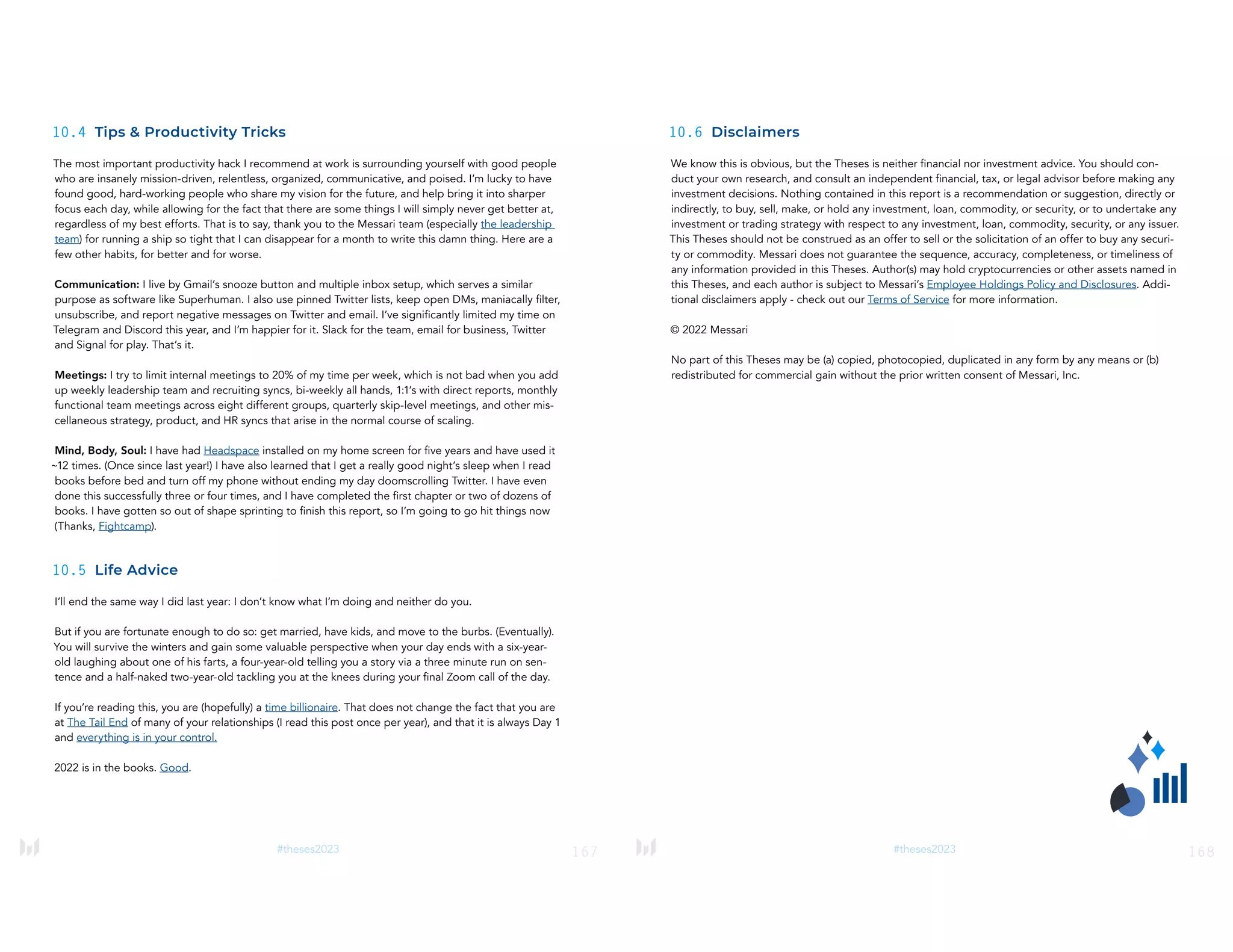The 2023 Messari Theses report provides an overview of key trends, people, and projects in the cryptocurrency landscape, emphasizing predictions and essential themes for the year ahead. It highlights the significant changes in the macro and political environment affecting the crypto market and reflects on the need for a return to foundational principles amid ongoing volatility. The author advocates for building and innovation within the crypto space, focusing on privacy, decentralization, and the long-term resilience of Bitcoin and Ethereum.

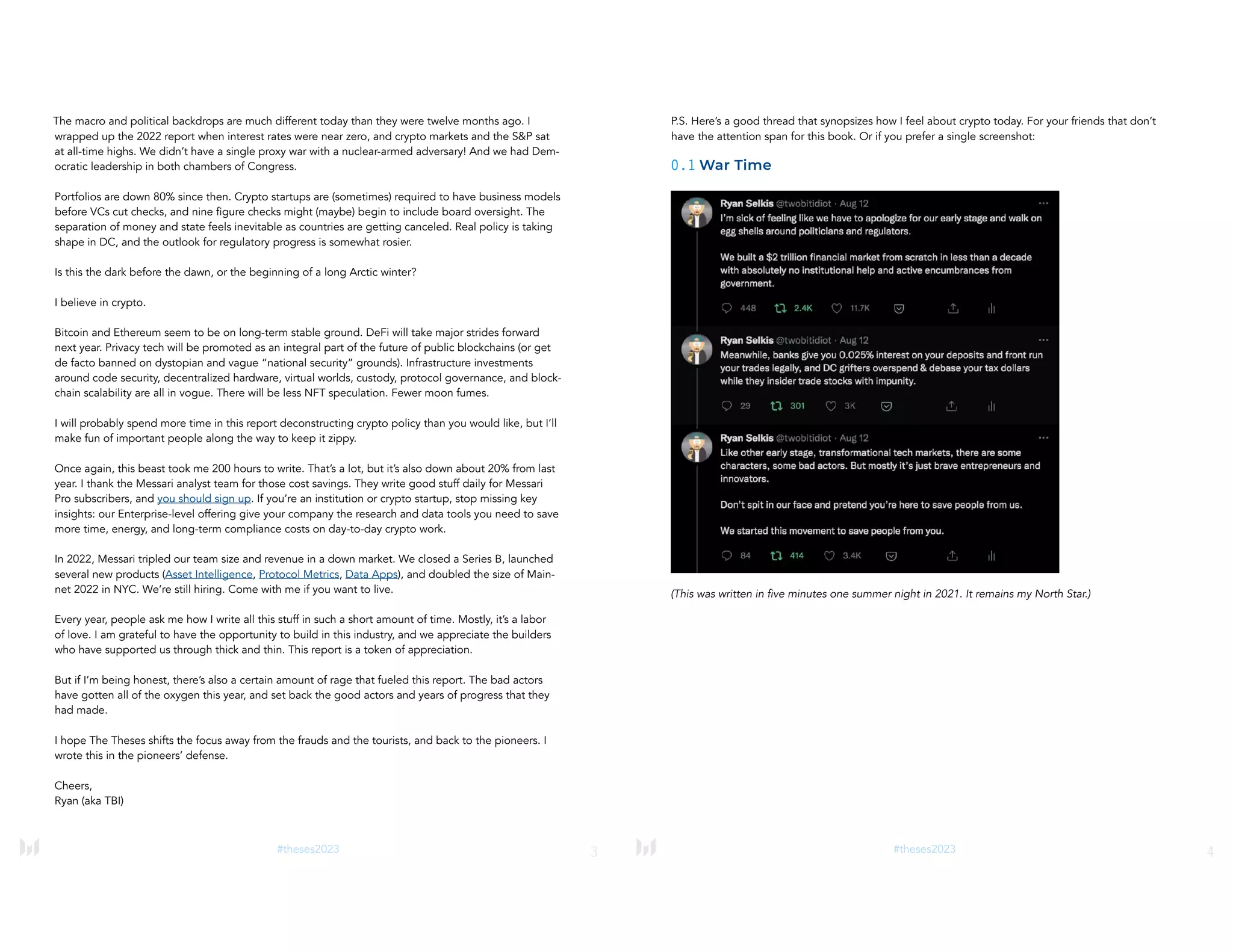
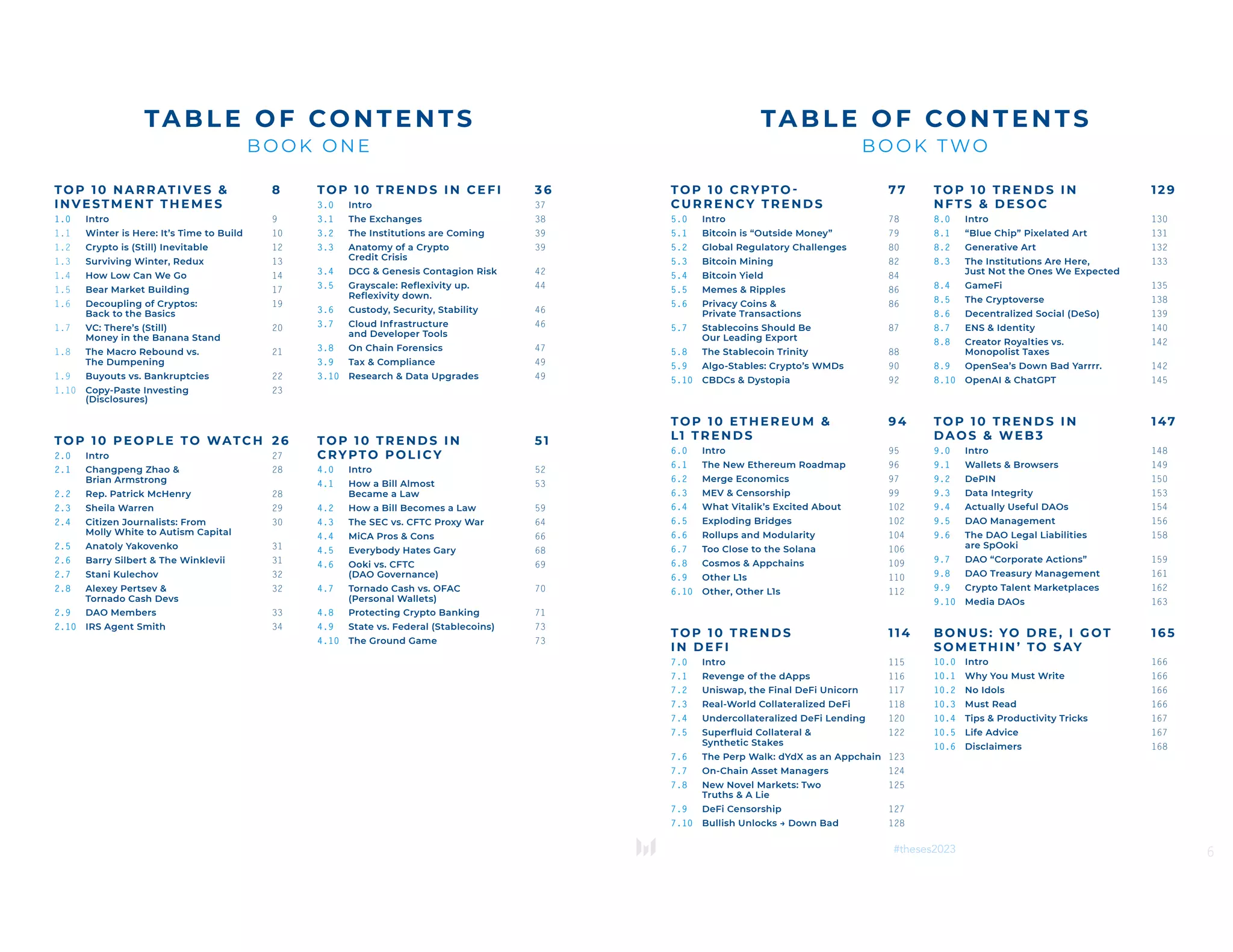
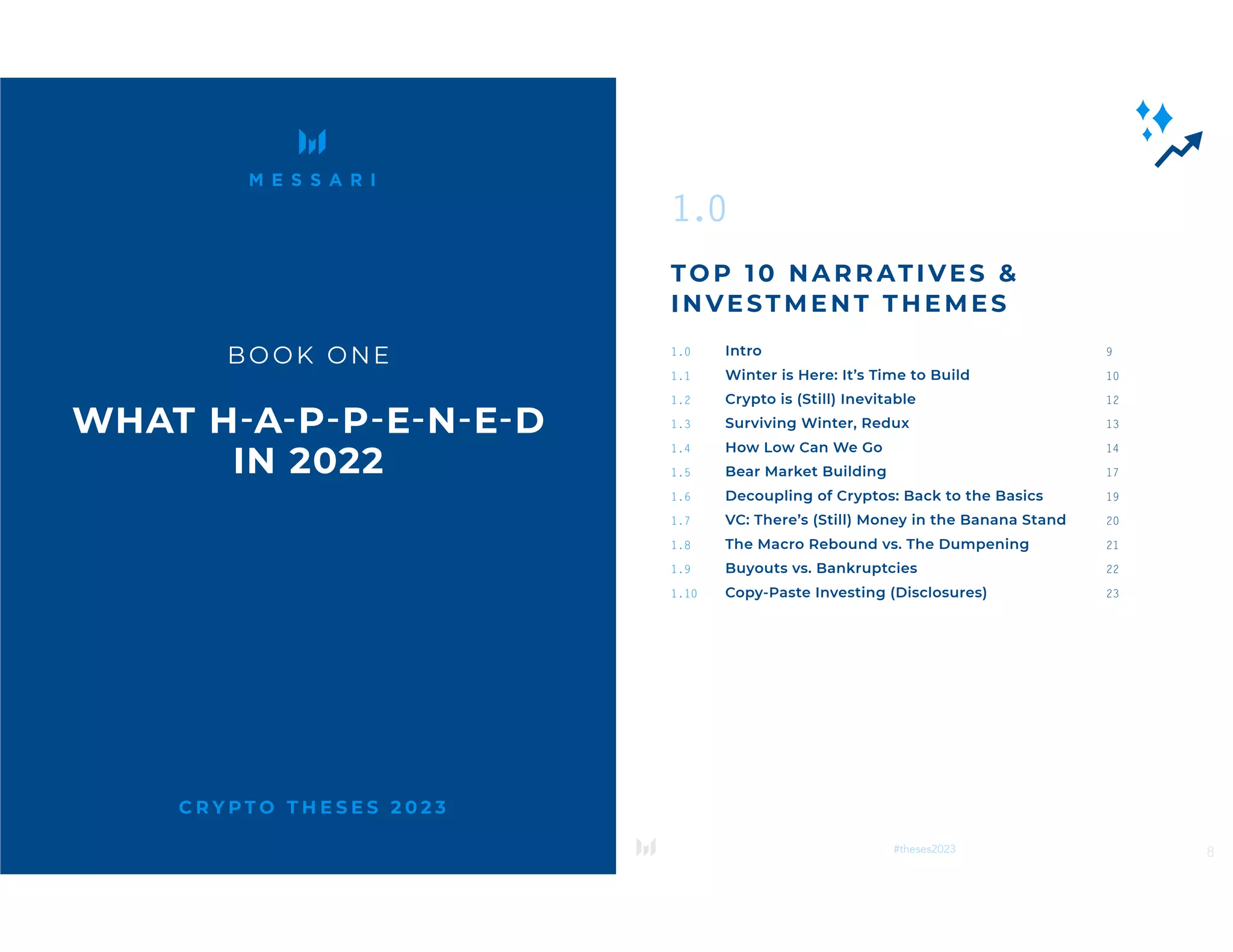
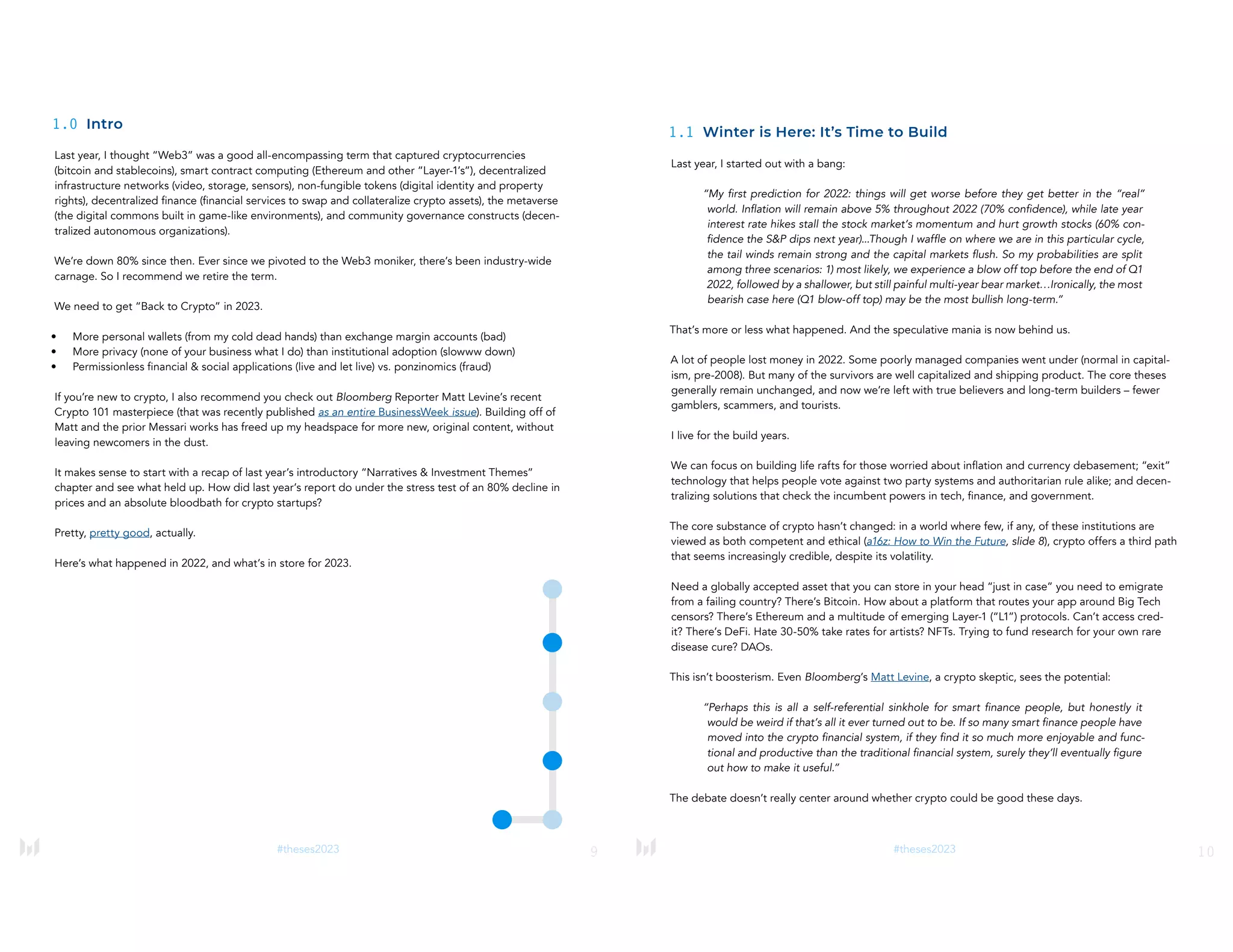

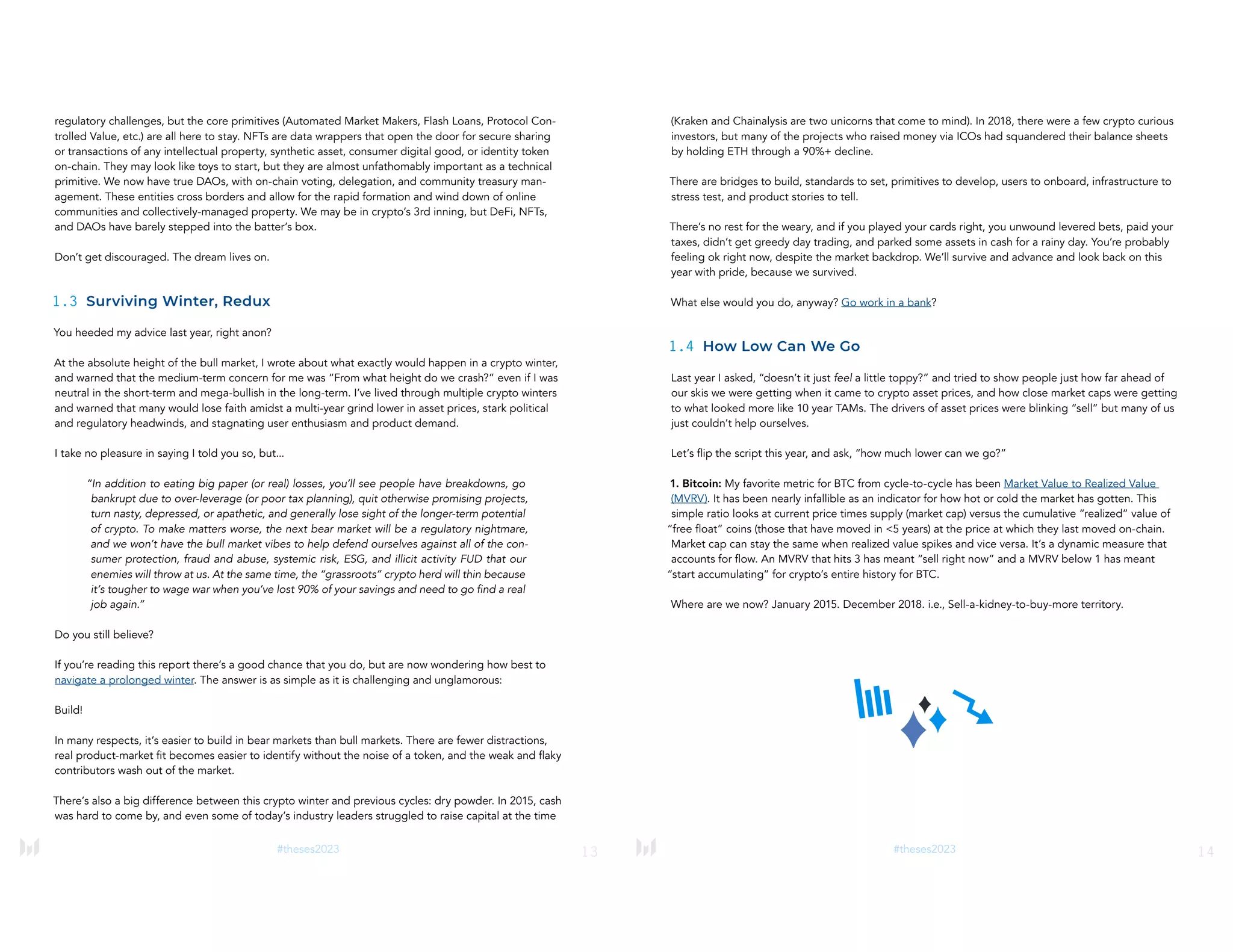
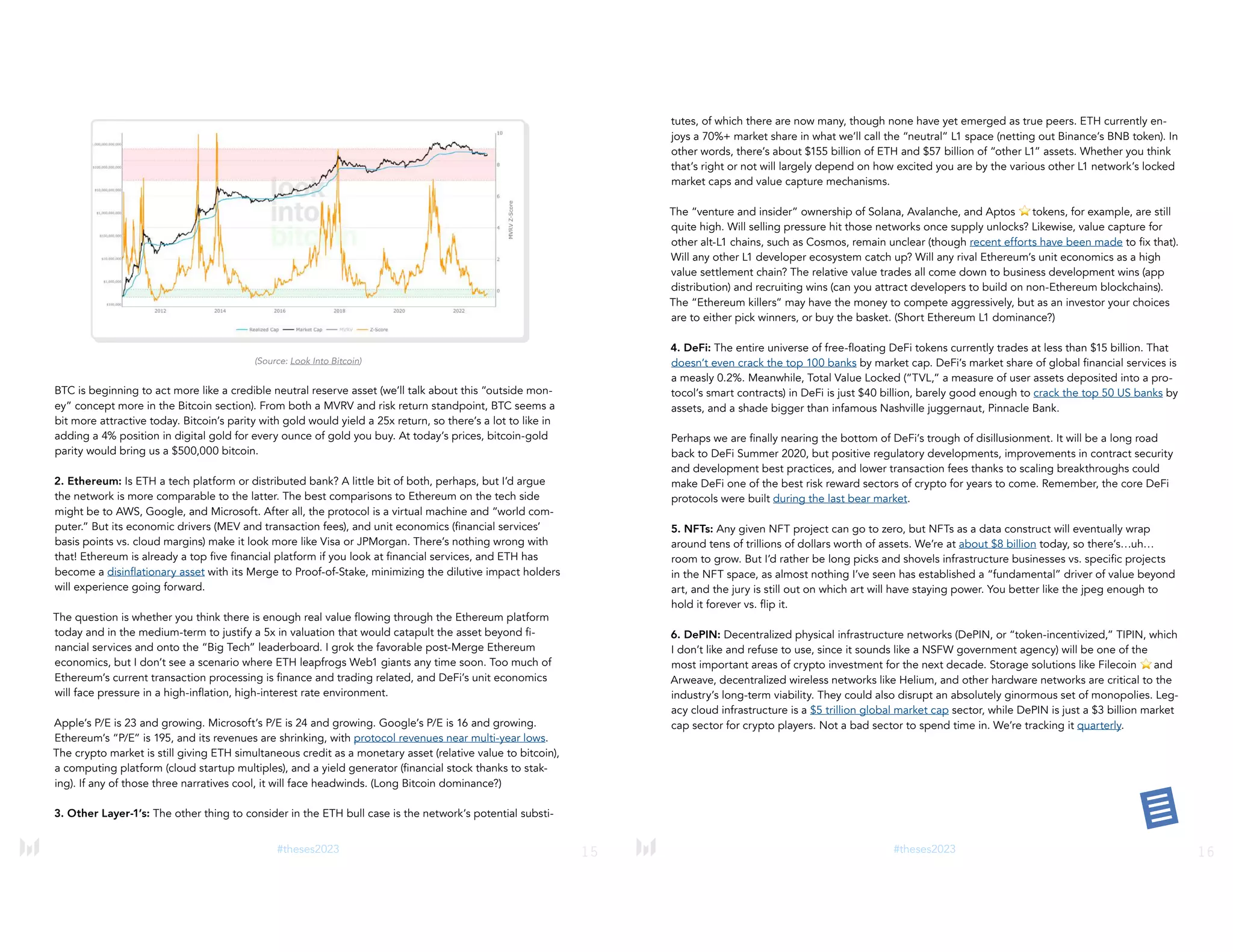
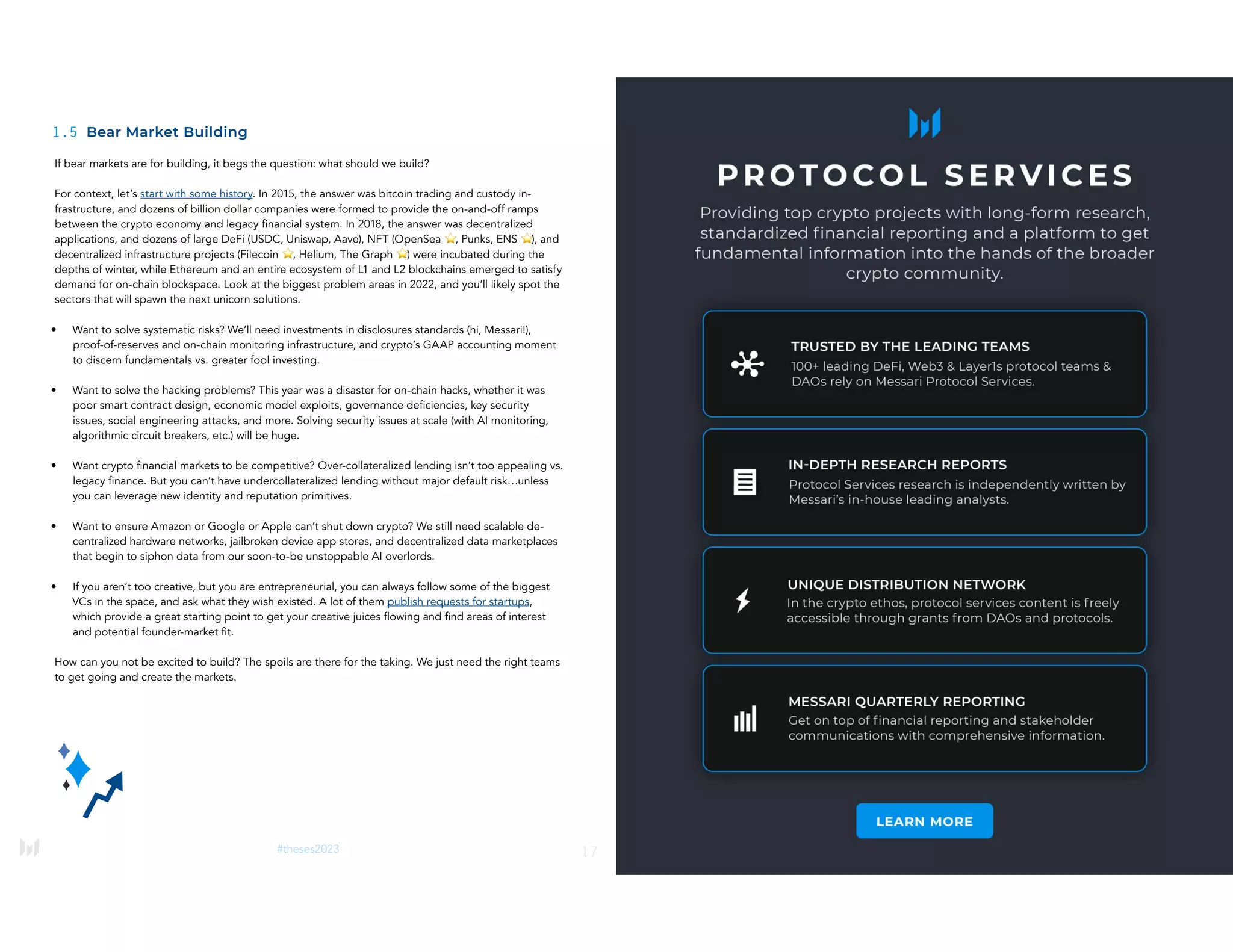
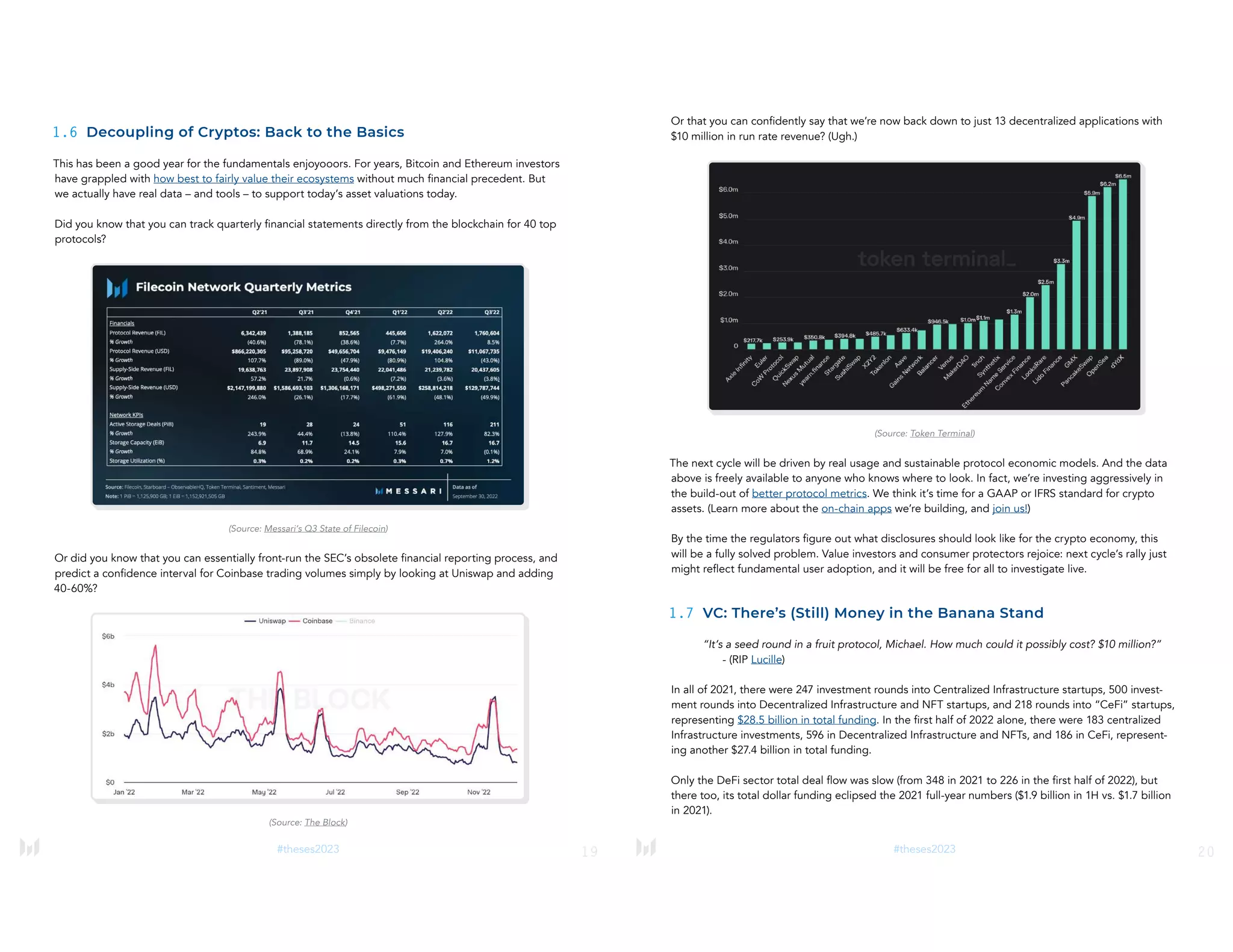
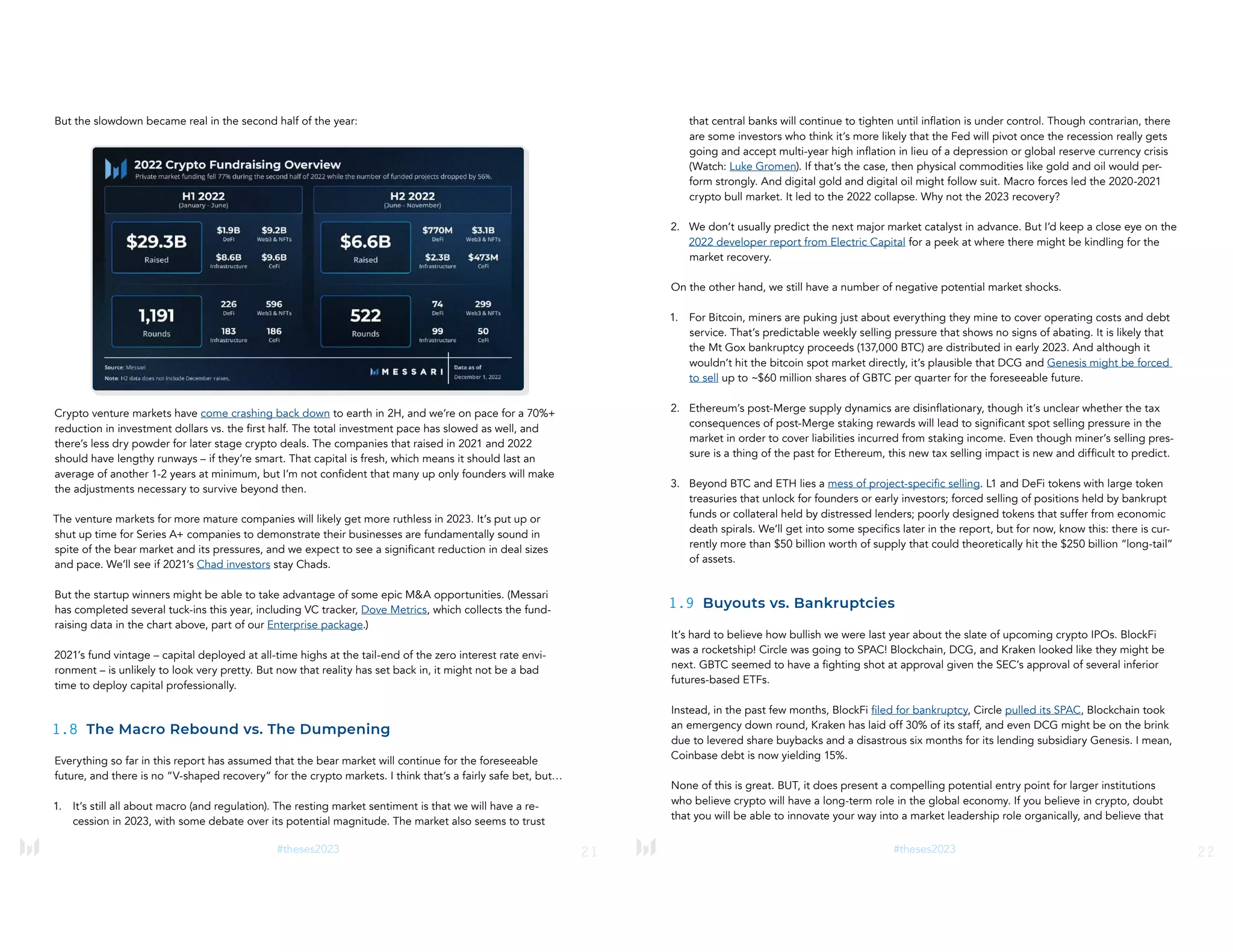
![23
#theses2023
TBI
Biggest winner: Messari Stock (Series B)
Biggest loser: LUNA
Holds: BTC, ETH, $GBTC
Likes: BTC, ETH, ZEC, DePIN (FIL ⭐/AR), GRT ⭐,
DeSoc, Tuck-in M&A
Maartje
Biggest winner: Adding more ETH on the cheap
Biggest loser: CRV (-90%)
Holds: BTC, ETH, RNDR
Likes: DePIN, taking the long view
Tom
Biggest winner: American dollars (0%)
Biggest loser: ETH (-70%)
Holds: ETH, SNX, RNDR
Likes: Cash/USDC until late Q2 as the FED
pauses, liquidity conditions improve and we hit
peak recession, then up only for all risk assets for
the rest of 2023. | Tokens: ETH, SNX, BTC, UNI,
RNDR, $COIN; Themes: TIPIN/PoPW, market
capture > token cash flow, continued ETH dom-
inance, the flippening in late 2023, institutional/
nation state adoption of crypto in Q3/Q4, and
undercollateralized lending.
Ally
Biggest winner:
Biggest loser: ETH
Holds: ETH, MATIC, DOT, SOL
Likes: Ethereum’s rollup ecosystem, zk tech, NFT
tech applications outside of PFPs
Dustin
Biggest winner: USDC +0.00%
Biggest loser: RGT (-99%)
Holds: USDC, ETH, Aave, Matic, Pendle
Likes: Social (familiar consumer use cases with
crypto complexities abstracted away), Eth-centric
rollup ecosystems, Decentralized rendering and
compute, Fuel for the winter (cash and lots of it)
Chase
Biggest winner: Not being in Terra & FTX (+∞%)
Biggest loser: TOKE (-95%)
Holds: USDC, BTC, ETH, MATIC, SOL, PCN, RPL
Likes: ETH & BTC as bases for future network
states, Ethereum core devs doing the Lord’s work,
Protocols as public goods / utilities (i.e., no rent
extraction), Decentralized social combined with
DeFi, TIPIN experiments (humble Pollen garden-
er), SNARKs and oracles for cross-chain communi-
cations, the friends we’ve made along the way.
your compliance and regulatory cloak position you well to clean up a technically sound, but operation-
ally inferior “crypto institution,” you might want to shoot your shot in 2023.
Fidelity or Blackrock might like DCG in a distressed buyout situation. JPMorgan might jump at the
chance to lob in a hostile takeover bid for Coinbase at just 5% dilution. If the institutions were, indeed,
coming last year, then you have to wonder whether the barbarians are at the gates and Wall Street is
ready to execute a slow takeover of crypto.
I’m not saying that I particularly like that future.
I’m just saying it could happen, and it’s looking more plausible by the day that this downturn could
end up proving to be the bridge that institutions – on Wall Street and in Big Tech – needed to inte-
grate crypto products at scale. Through M&A.
1.10 Copy-Paste Investing (Disclosures)
24
#theses2023
Kunal
Biggest winner: Knowledge, experience, convic-
tion
Biggest loser: FTT (-100%)
Holds: RPL, LDO, ETH, MINA, BTC
Likes: Liquid staking protocols. Expect them to
outperform ETH, which in turn outperforms BTC.
Post the Merge, real yields for stakers are up to
6% from 0%; as soon as users return, they go up
even more. With the right tokenomics, L2-coins
could also have some potential.
Sami
Biggest winner: USDC (+0.00%)
Biggest loser: HNT (-94%)
Holds: BTC, XMR, ETH, RNDR, AKT, AR, HNT
Likes: Physical infrastructure protocols (also
known as TIPIN, PoPW, EdgeFi) that provide
real-world value and tap into existing, non-specu-
lative demand. This includes DeWi, compute/
storage, energy, and sensor networks. Web2
adopting crypto infrastructure will bring on the
next wave of crypto adoption.
Kel
Biggest winner: Surviving my first cycle above
where I started it.
Biggest loser: ETH (-70%)
Holds: ETH, JitoSOL, RNDR, AKT, RPL, SHDW,
AURY, POLIS
Likes: Solana: best tech without introducing
cross-chain risks, TIPIN & decentralized comput-
ing networks, Gaming: The model worked with
worse games, what happens when you use it with
better games? Liquid staking derivatives: muh
free yield.
Mihai
Biggest winner: CHF
Biggest loser: ETH
Holds: BTC, ETH
Likes: Zero-knowledge proof applications, Infra-
structure as the backbone of the next wave of
crypto social applications, Dry powder
Chris
Biggest winner: Kayne Anderson Energy Infra-
structure Fund [KYN] (+154.55%)
Biggest loser: GLMR (-80.62%)
Holds: BTC, ETH, DOT, LINK, FIL, ZEC, GLMR
Likes: Overweight LINK and FIL since 2023 will
be the year of infrastructure protocols. DOT.
Equities, crypto-adjacent equities, and real estate
buys will be highly selective throughout 2023.
Eshita
Biggest winner: USDC
Biggest loser: ETH
Holds: BTC, ETH, SOL
Likes: Boolish Ethereum ecosystem, ZK infra:
namely for scaling + identity applications, Ex-
perimentation with emerging DAO governance
frameworks, Lending w/ RWAs crucial in DeFi
adoption
Johnny_TVL
Biggest winner: Messari
Biggest loser: STEPN NFTs
Holds: BTC, ETH, SNX, AAVE, ATOM, MATIC
Likes: SNX staking is my favorite position (must
be managed). A rare utility token in DeFi. Sleep-
er pick is BNT, hoping they make a practical
decision around tail risks even if the models don’t
call for it. AAVE adding GHO. dYdX punt for V4
success. ILV punt for gaming.
Micah
Biggest winner: XMR (–42.4% YTD)
Biggest loser: AKT (–89.5% YTD)
Holds: AKT, AR, ALGO, ATOM, BTC, XMR, ETH,
DOT, FLOW, MANA, SOL, UNI, ZRX, LYXe
Likes: Utility-based Blockspace, Financialization
of Blockspace (e.g., Consensus Capital Markets),
Perps, 5-year (minimum) investment time horizons
(YTD, crypto down; since buying first–fifteenth
crypto, portfolio is up)](https://image.slidesharecdn.com/messari-cryptotheses2023-230101045959-80637cf4/75/MESSARI-Crypto_Theses_2023-pdf-12-2048.jpg)
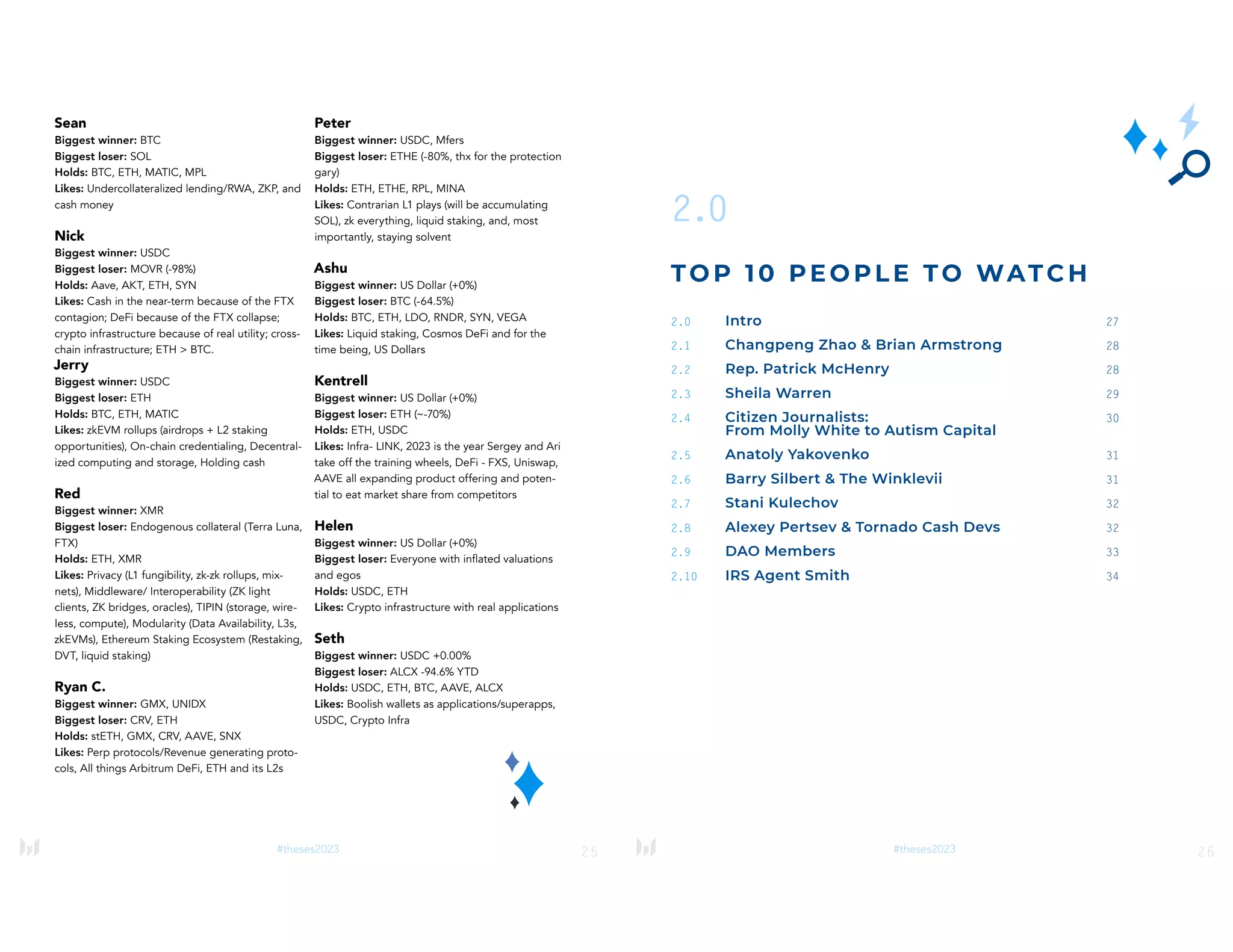
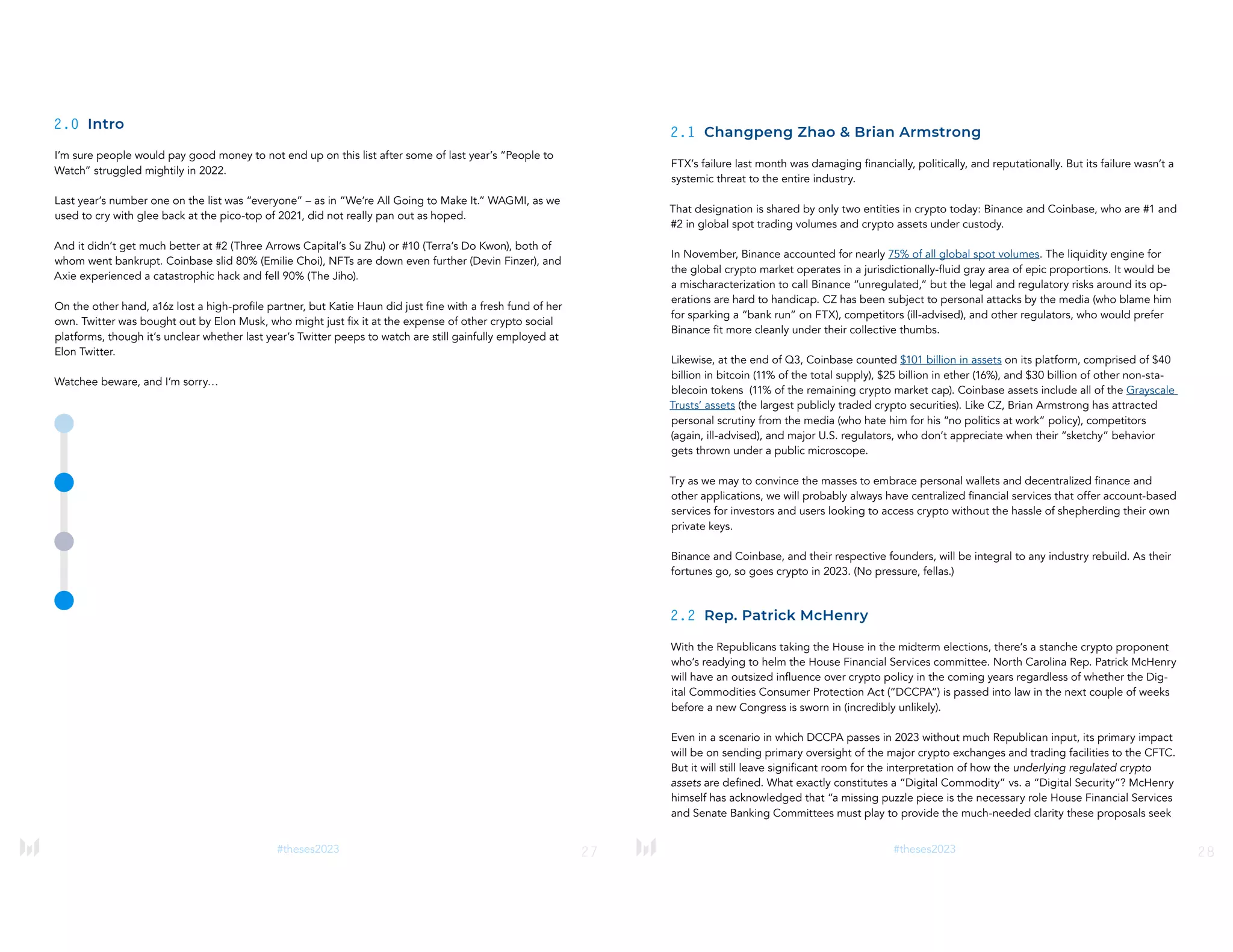
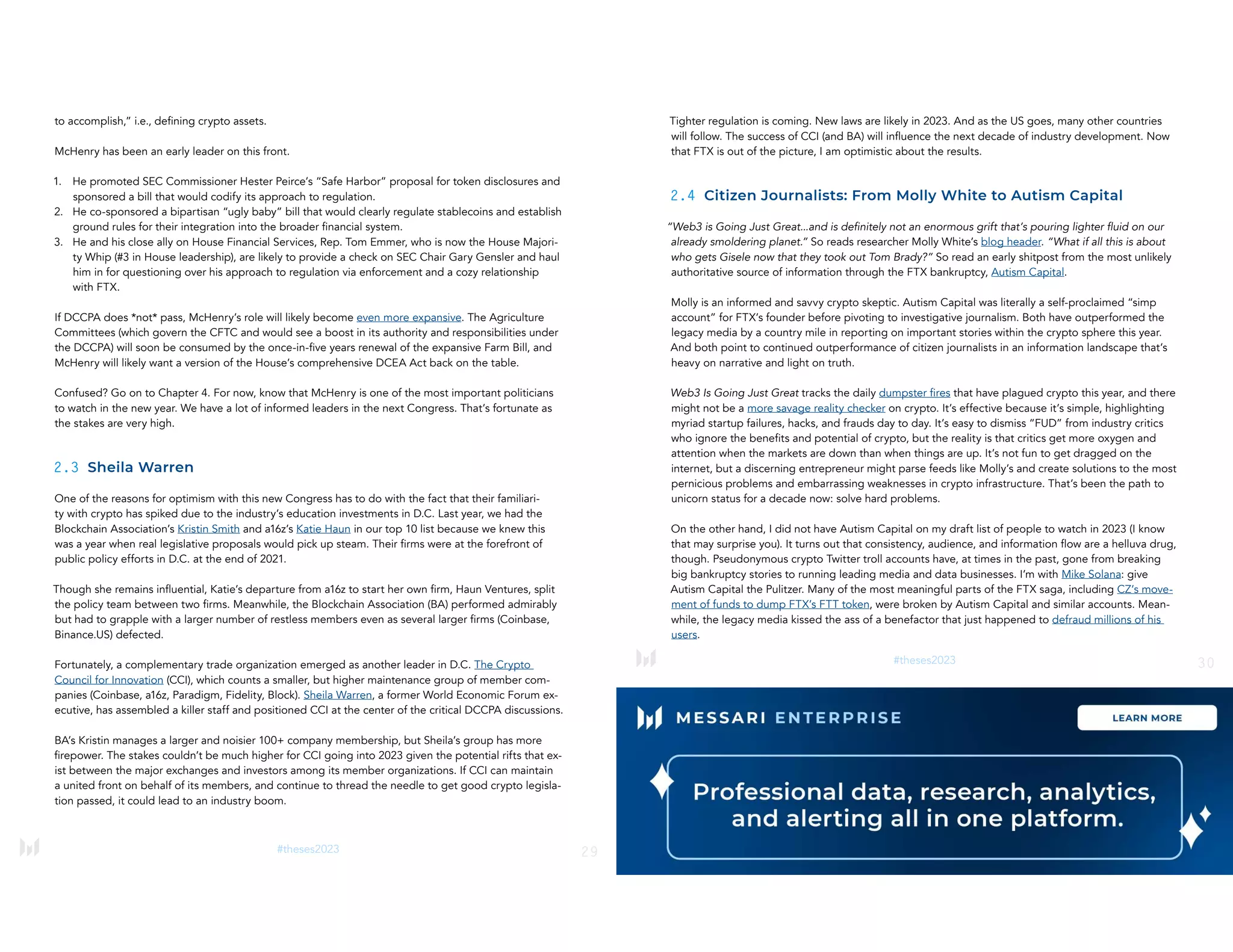
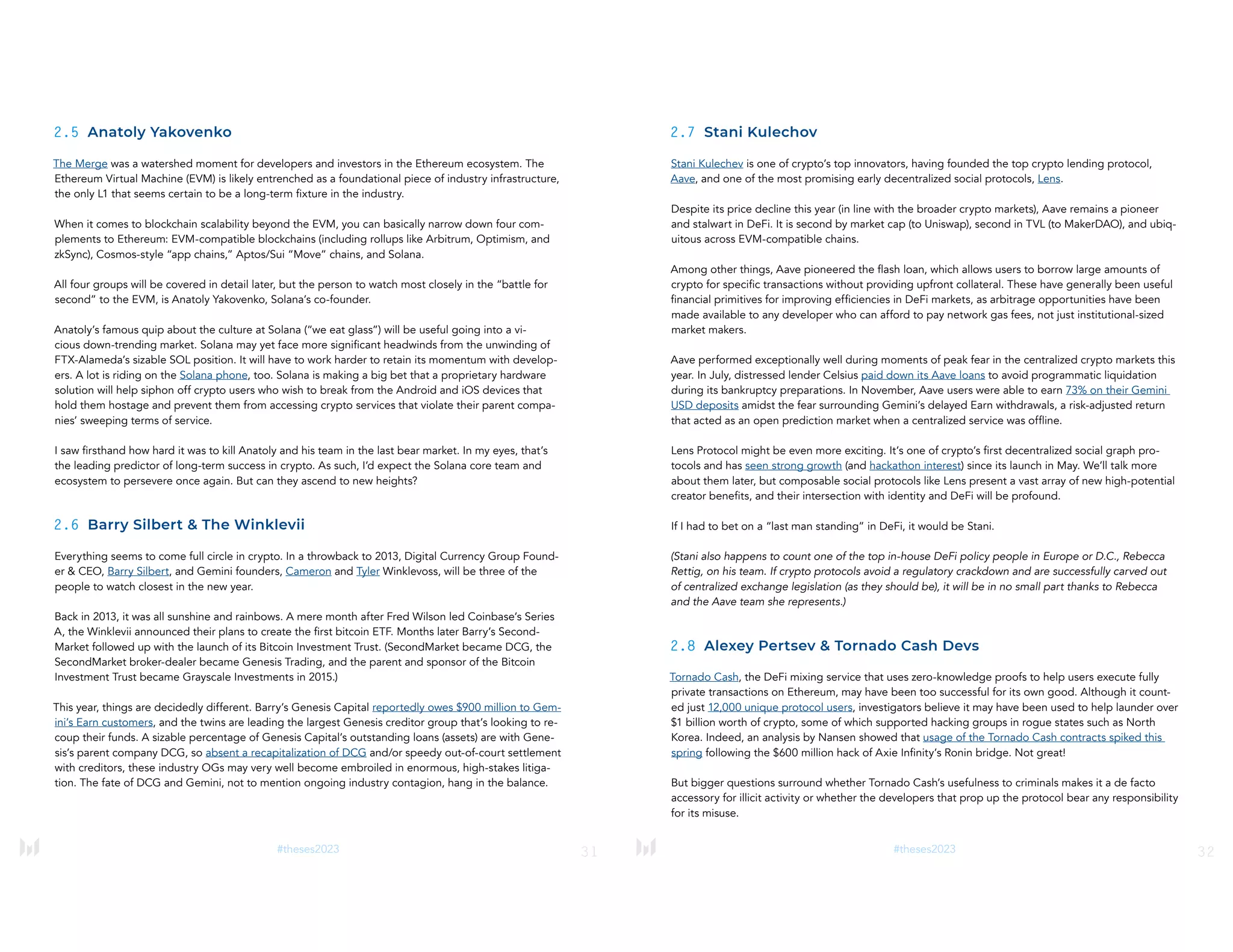
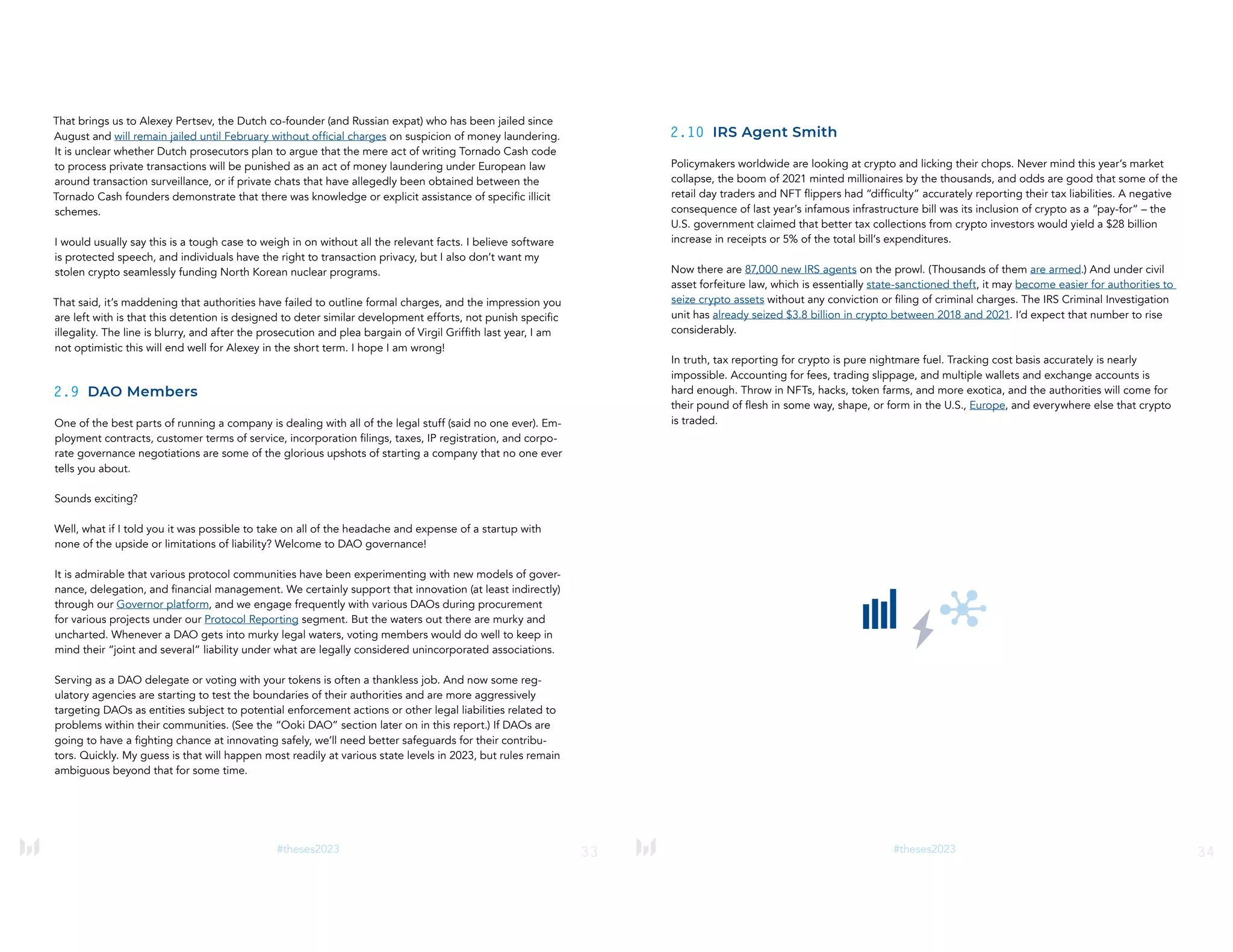

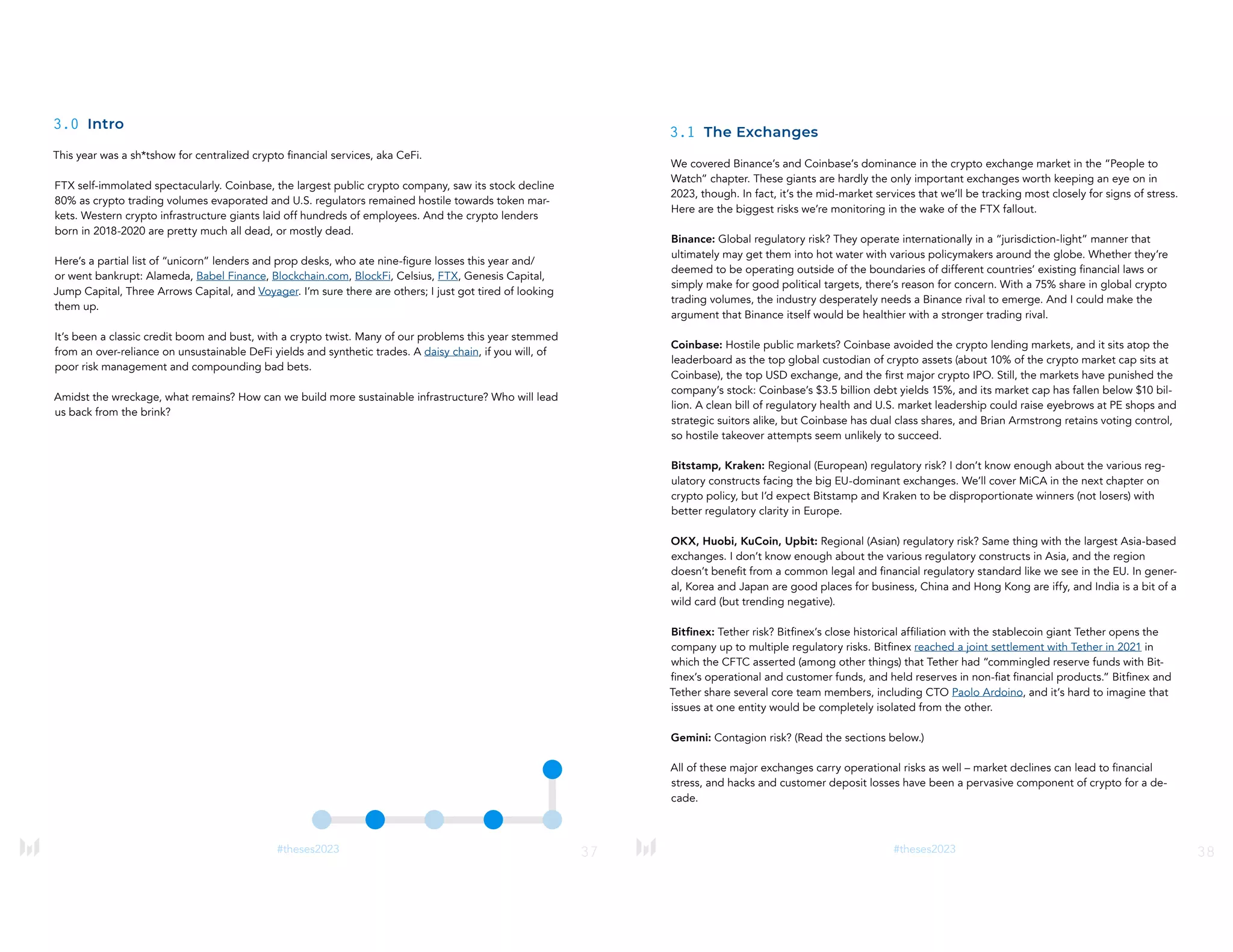
![39
#theses2023
But at least one silver lining to the FTX crisis was its catalyzing effect on the “proof-of-reserves” move-
ment. For years, many have clamored for on-chain evidence of major exchange reserve assets in order
to ensure top platforms were solvent and willing to prove they weren’t going fractional or otherwise
misappropriating user assets. FTX proved – too late – that those concerns were absolutely warranted,
even for the “smartest guys in the room.”
There is still work to be done on the “proof-of-liabilities” side of the ledger, but we now at least have
unprecedented transparency around exchange assets. The days and weeks following FTX’s collapse
were record-setting in terms of asset withdrawals from the top crypto exchanges. “Bank runs” were
everywhere for those running lending books, but for those who weren’t breaking their own rules, and
gambling with customer deposits, things were fine. Nansen killed it in quickly assembling a public
repository of exchange reserve data. Kraken and others publish proofs-of-reserves without publicly
divulging info, and Coinbase is audited quarterly as a public company. Some $200 billion in crypto
assets held on exchanges are now fully accounted for and trackable quarter to quarter.
3.2 The Institutions are Coming
Despite the market slowdown, there was surprising and meaningful crypto adoption by a number of
legacy institutions.
[This is the part of the report where I pretend to care for a minute about institutional crypto efforts.
Insert something about [awesome legacy Wall Street firms and Big Tech pioneers], and how this time
they really will continue to invest in crypto during a lengthy bear market.
Or leave this in brackets and “forget” that you didn’t update this section, blame a late night editing
oversight, and say “Oh damn, I had a whole spiel about how awesome your [insert recent press re-
lease from the crypto team at the institution] was. I’m kicking myself for that process error!” then make
up for it next year with no consequence via another vague update about how, for the 11th year in a
row, the “institutions are coming” after one of the banks or asset managers buys one of the exchanges
listed above.
In case this accidentally doesn’t get cut via a process error, write that you love the companies listed
above and this is just a very funny draft joke and misunderstanding, so the sales team can honestly tell
them “Selkis said he loves you guys” and then some of them may forgive you for writing 140 pages for
free, but not spending an incremental day gouging your eyes out reading up on corporate blockchain
initiatives. Maybe one of the esteemed institutions that I really love quite a lot will have a sense of
humor and respond by commissioning a report on corporate blockchains because “they REALLY DO
care about crypto” and “this deserves a look.”]
3.3 Anatomy of a Crypto Credit Crisis
The Grayscale Trade, aka crypto’s “Widowmaker,” was integral in helping create much of the crypto
contagion we saw this year.
It was a root cause of the Three Arrows Capital (3AC) and BlockFi bankruptcies, and its potential rip-
40
#theses2023
ple effects on its distressed sister company Genesis Capital – and Genesis counterparties like Gemini –
remain unresolved and could cause further damage still. The Grayscale products themselves continue
to deteriorate for their investors as the discount to their fair value (the underlying assets held in the
trusts) have widened to 40%, with no fee reductions or ETF conversion on the horizon.
This spring’s Terra/Luna failure was simply a haymaker that followed years of body shots from the
slow-bleeding bad bet on GBTC. Yield-hungry investors, forced further out onto the risk curve as
Ethereum-based DeFi remained mired in a multi-year recession, gobbled up 20% teaser yields on an
emerging algorithmic stablecoin (UST) and its rising star lending protocol (Anchor), not realizing it was
laced with arsenic. It was a good reminder to use common sense in investing. If you don’t understand
the yield, you are the yield.
Let’s set the stage for this section on CeFi with a speed run through crypto’s first credit crisis. CMS
wrote up the cliff notes in just five tweets that explain how this all went down, but I will also attempt to
summarize here:
1. It started with the Grayscale Trusts. These vehicles allowed investors to buy GBTC in their 401ks
through OTC traded securities. But they weren’t ETFs, so they didn’t have typical creation and
redemption mechanisms. Instead, accredited investors could create Trust shares with bitcoin, hold
the shares for a six-month “seasoning” period, then flip them for what was a hefty GBTC Premium
for quite a while pre-2021.
2. Flipping and rolling the GBTC Premium ballooned in popularity and The Grayscale Trade got
crowded in 2020 hitting $40 billion in AUM at its peak due to stimulus, bitcoin halving, and zero
interest rate COVID policies of 2020. 3AC and BlockFi accumulated 10% of the Trust’s shares with
$4 billion in exposure at the peak in February 2021. But then 3AC started offloading some of its
exposure during the great GBTC Premium Crash.
3. Now a good chunk of the seasoning - GBTC is trapped and underwater with 3AC and BlockFi still
subject to six months holding restrictions. They eat the unrealized losses and instead lean on lend-](https://image.slidesharecdn.com/messari-cryptotheses2023-230101045959-80637cf4/75/MESSARI-Crypto_Theses_2023-pdf-20-2048.jpg)
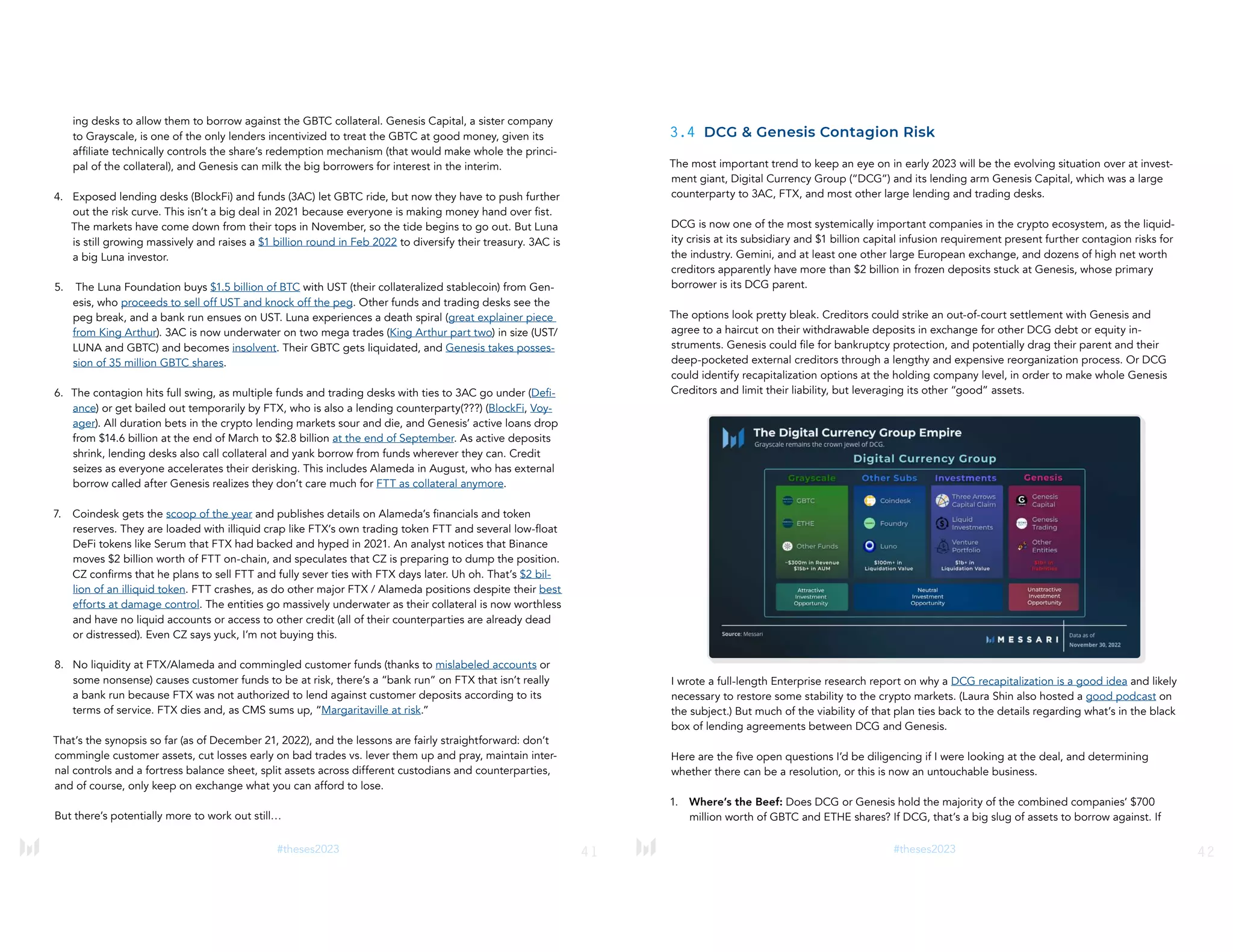
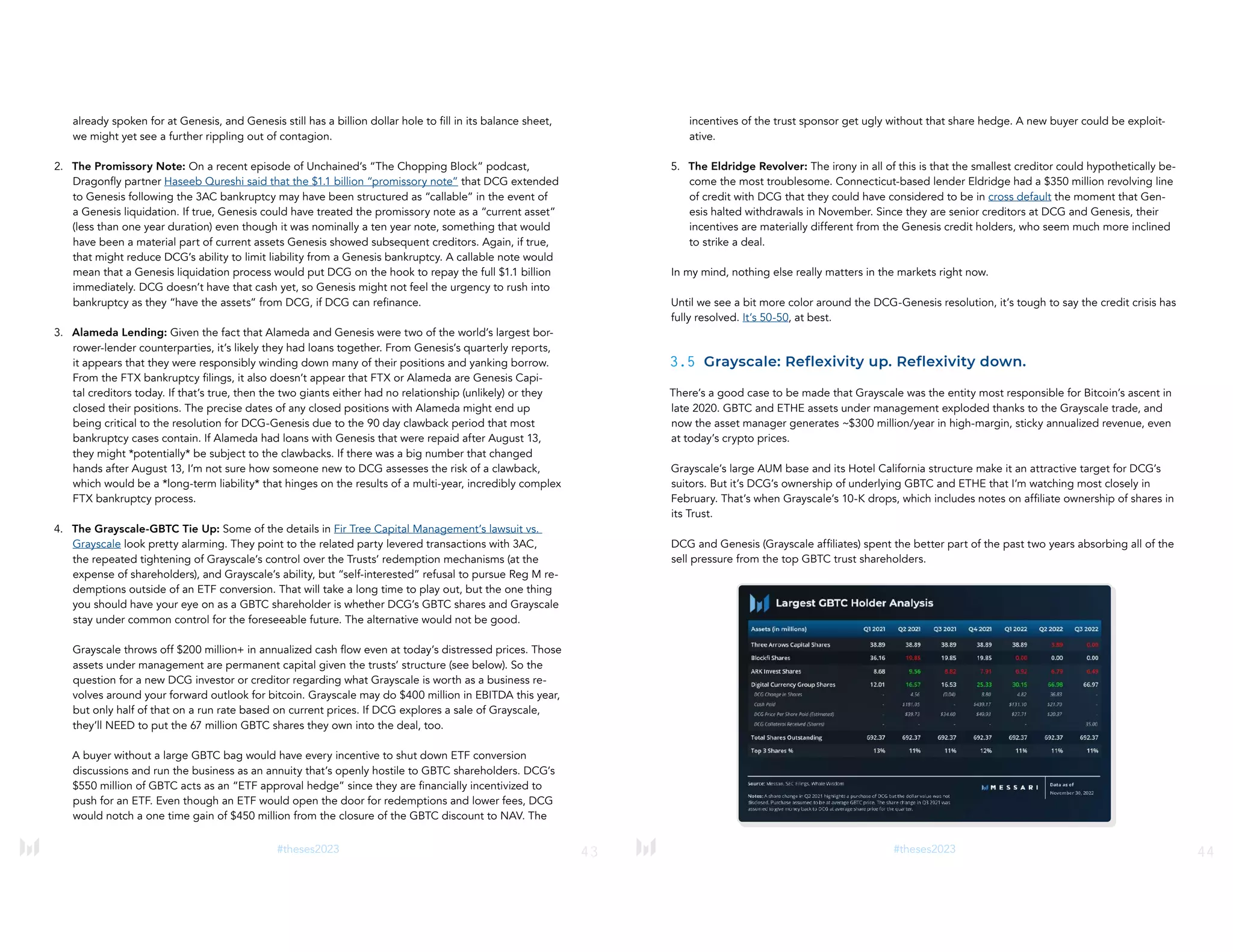
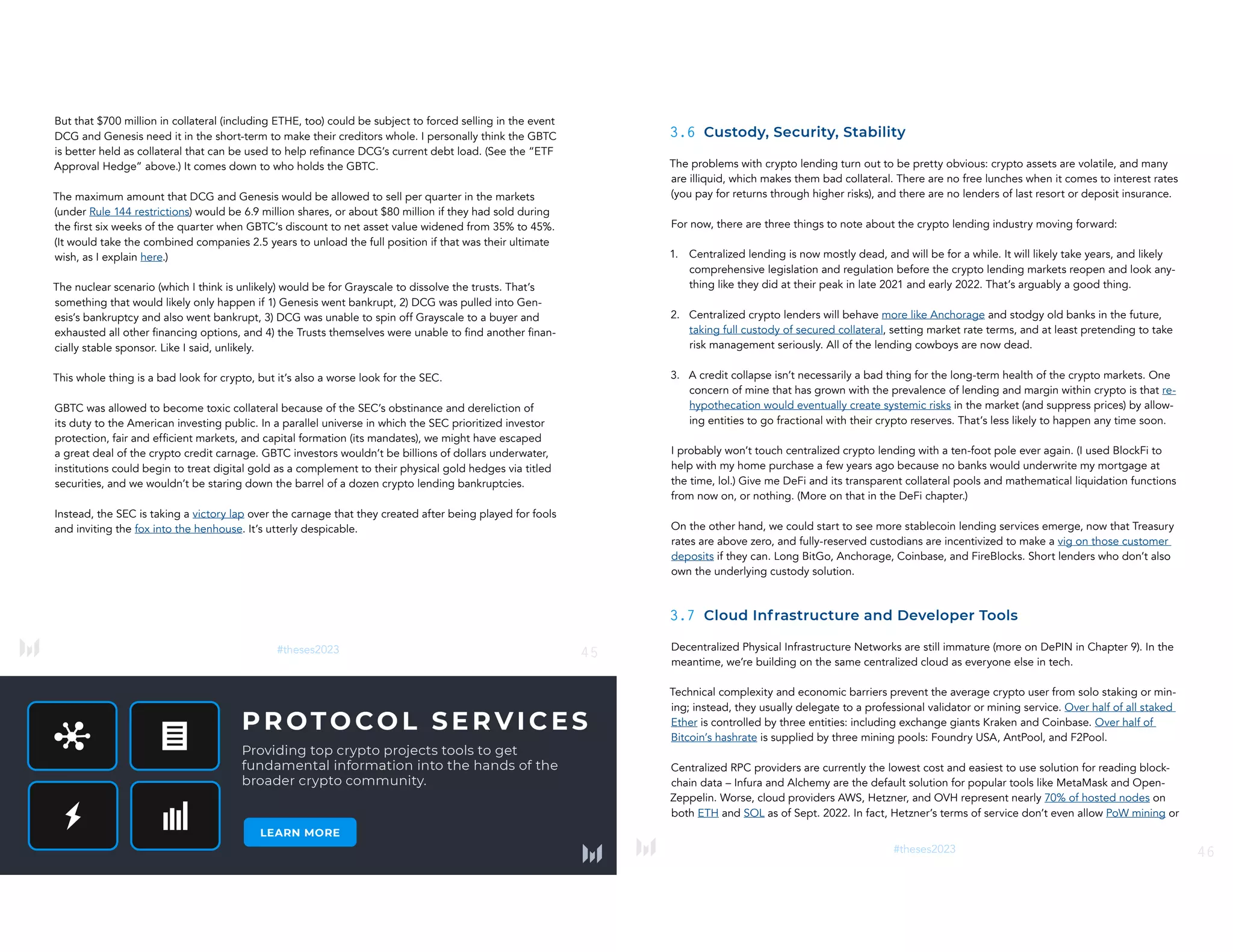


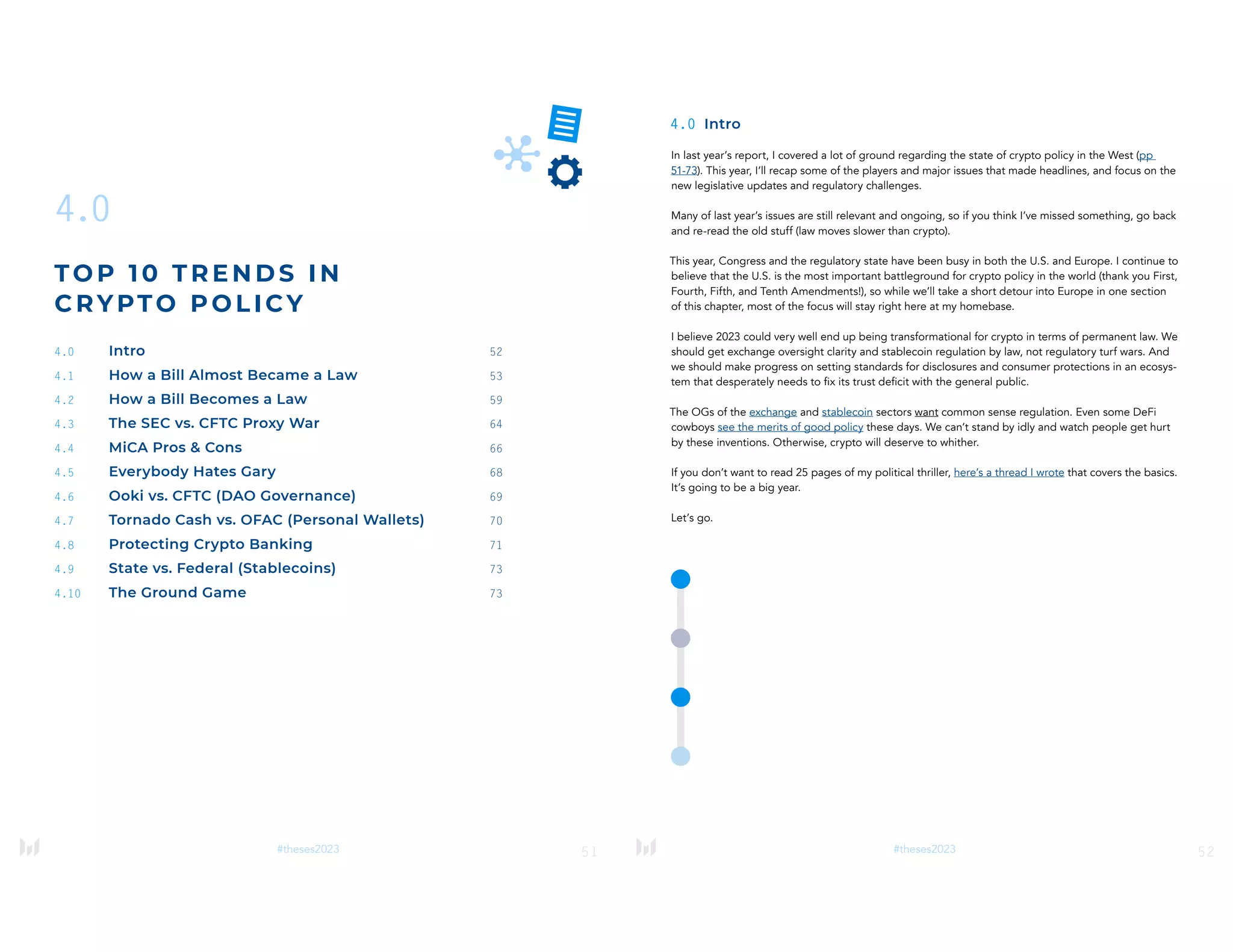

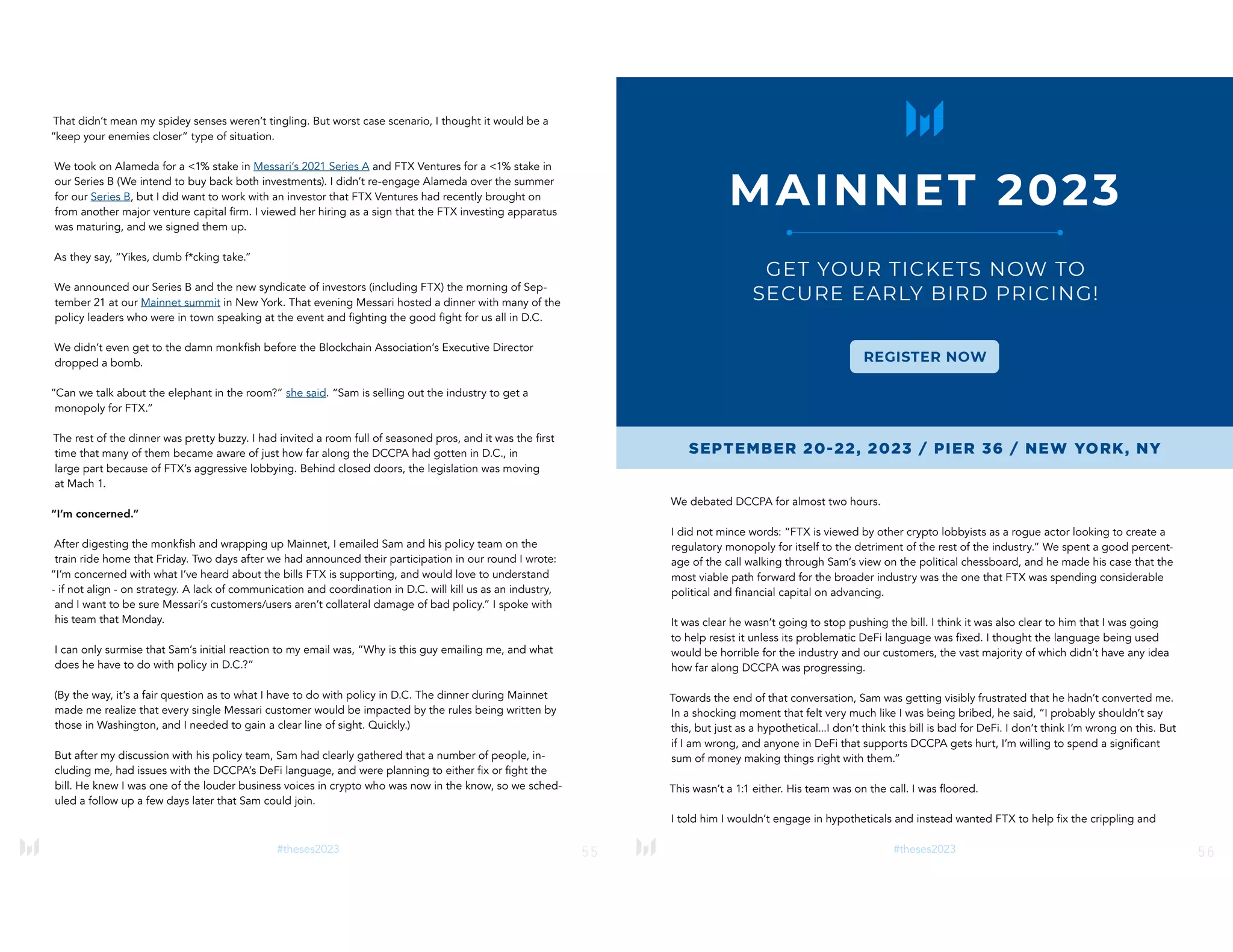

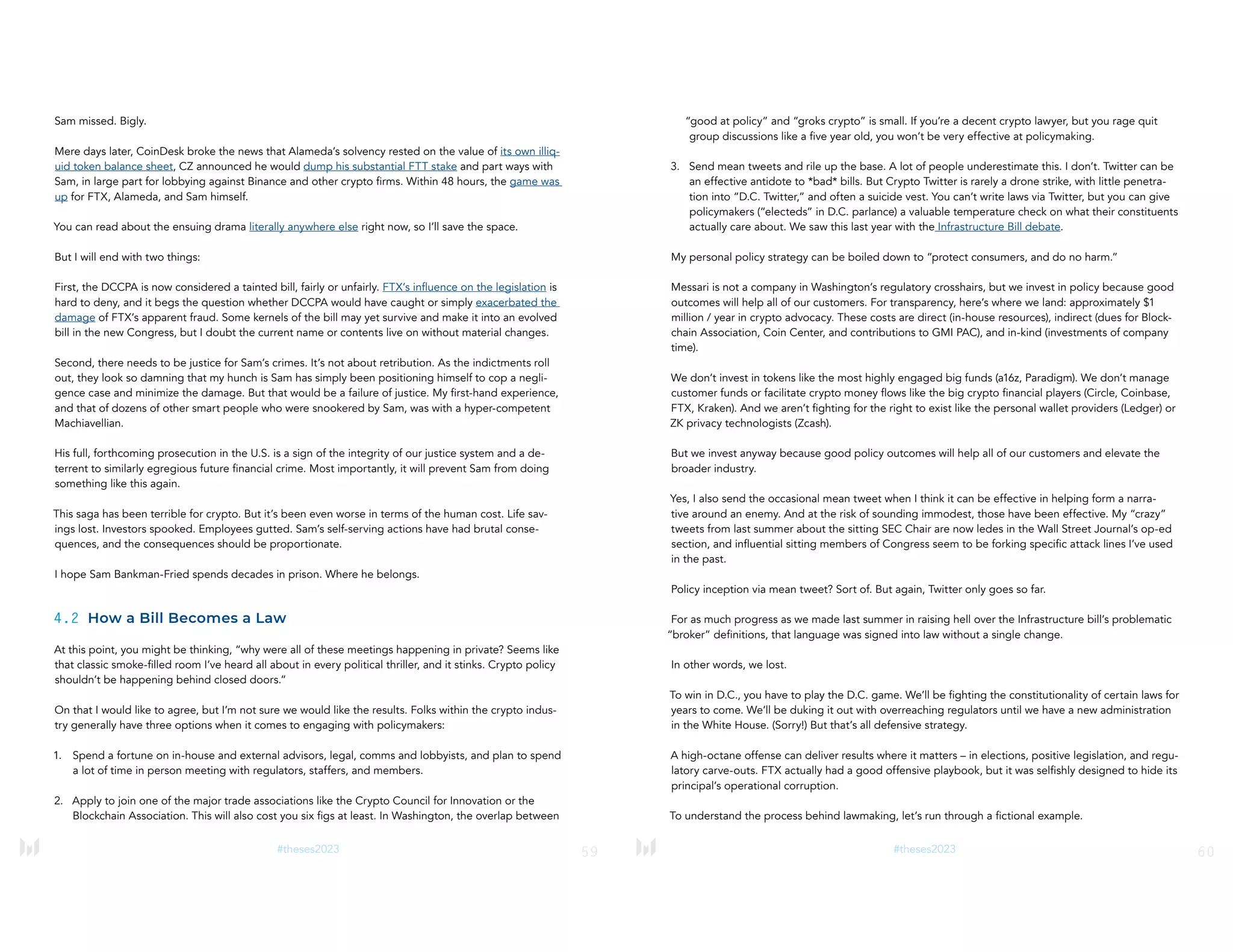


![65
#theses2023
As a result, legislation that puts the CFTC in the driver’s seat in the oversight of exchanges and cus-
todians like Anchorage, Coinbase, Gemini, Kraken, and others seems to make sense. The CFTC is no
slouch as a regulator (as we’ll see below), but at least they aren’t openly hostile to crypto’s existence,
and exchange compliance would seem possible under their oversight.
SEC oversight, on the other hand, would likely prove impossible, as exchanges wouldn’t be able to list
assets like ETH until they were either issued “no action letters” as non-securities, or registered with
the SEC. How does a decentralized Layer-1 protocol and its community produce centralized financial
reports and disclosures, you might ask?
Well, I think you have your answer for how unworkable SEC authority is to the future of crypto in
America.
The Crypto Counsel for Innovation’s (CCI) CEO, Sheila Warren, lays out the most likely path forward by
drawing on some history:
“Where does policy go from here? Dodd-Frank gives some insight. At the center of the
[2008] collapse were exotic and largely unregulated financial products called derivatives
- credit default swaps (CDS) were sold on billions of dollars of securities backed by shaky
mortgages (MBS). Think of CDS as insurance on default risk.
In the 1990s, derivatives were seen as an exciting financial innovation that could unbundle risks, and
Washington decided the economy would benefit from as little regulation as possible. Fed Reserve
Board Chairman Alan Greenspan in 1999:
‘By far the most significant event in finance during the past decade has been the extraordinary devel-
opment and expansion of financial derivatives.’
When I worked as a Wall Street lawyer in the early 2000s, CDS were gaining popularity among many
financial firms and had moved well beyond super elite traders. In fact, several cutting edge financial
firms were exploring other similar products. In 2008, mortgages began to default rapidly and sudden-
ly everyone who sold those MBS derivative products – CDS – owed a lot of money, causing a global
economic meltdown and revealing just how interconnected financial institutions were. The contagion
was shocking and severe.
Title 7 of the Dodd-Frank Act subjects all derivatives to substantive regulatory oversight – ‘swaps’ are
regulated by the CFTC & ‘security-based swaps’ by the SEC. Two years after enactment, the agencies
issued a joint rulemaking defining these terms. So these things can take years.
[Fast forward to crypto, post-FTX collapse.] Reactive, panicky policies are not the solution. Now is the
time for thoughtful, careful discussion with lawmakers and stakeholders to ensure the U.S. crypto reg-
ulatory framework promotes safety & soundness, protects consumers, preserves our innovative edge,
and prevents bad actors.”
66
#theses2023
The best case scenario in 2023 is one in which:
• The CFTC regulates the custodial exchanges, “digital commodities” like BTC and ETH, and carves
out DeFi (for now).
• Stablecoin issuers face new oversight requirements that outline the rules they will need to follow in
order to fully integrate with the legacy financial system.
• And then, and only then, we can have a discussion around the SEC’s role in overseeing bona fide
crypto securities. Ideas like SEC Commissioner Hester Peirce’s Safe Harbor provide a glimpse at
how the Commission could deal with the gray area in between.
As Ledger’s Seth Hertlein pointed out, the DCCPA never “solved the threshold ‘what is it’ problem.
(security/commodity/other). In fact, it may make things worse by creating a new bucket (digital com-
modity), giving the CFTC primary authority, but then giving the SEC veto power over CFTC decisions.
That won’t go well.” Those definitions will be tricky, but critical.
Common sense might yet prevail, but we’ve got a couple of big, powerful mob bosses that stand in
the way of a short-term resolution.
4.4 MiCA Pros & Cons
It pains me, but we have to talk about Europe and their mixed bag of policy tricks, Markets in Cryp-
to-Assets (“MiCA”) and the Transfer Funds Regulation (“TFR”), since they are now law of the land
across the EU, and will go into effect by 2024. These two bills form the backbone of three years worth
of discussion regarding a comprehensive regulatory framework for crypto. Some of it is terrible and
should be avoided at all costs in freedom-loving countries, and some of it borders on passable, if not
positive.
Let’s start with the good news.
• There’s clarity from a big economic bloc in terms of their treatment of crypto in the years ahead,
and they think this is a step forward in consumer protection and market integrity.
• They (mostly) focus on centralized Crypto Asset Service Providers (“CASPs”) and asset issuers and
focus on rules that would protect against market abuses. They kick DeFi regulations down the
road until after the sector has been properly studied.
• They require CASPs to have real presence and management in the EU, hold them liable for dam-
ages or losses caused because of hacks or operational failures, and mandate that client assets are
segregated in case of bankruptcy.
• Asset issuers are responsible for certain minimum disclosures, and for assets without any issues
(BTC, ETH), exchanges will have to provide a white paper and other basic information if they want
to list them, in which they could end up liable for mistakes.](https://image.slidesharecdn.com/messari-cryptotheses2023-230101045959-80637cf4/75/MESSARI-Crypto_Theses_2023-pdf-33-2048.jpg)
![67
#theses2023
• The early returns on their DeFi “study” are encouraging! They want to regulate legal entities ver-
sus protocols, introduce a voluntary framework for DeFi supervision, establish something called
“embedded supervision” (on-chain monitoring!) and oversee oracles.
• They didn’t ban bitcoin thanks to its energy intensiveness, as some radicals had initially proposed,
though they do have some maddening ESG reporting provisions in MiCA.
• And they provide a path to a digital euro stablecoin that isn’t necessarily a central-bank digital
currency. That’s a loaded section of regulation. They cap issuance for asset-referenced tokens
(“ARTs”) and non-euro e-money tokens (“EMTs”)
• NFTs are excluded (for now), except if they have a function that would make them some sort of
financial instrument. (ApeCoin versus Bored Apes comes to mind. More later.)
As for the problem areas?
• TFR is one of the strictest implementations of the Financial Action Task Force’s “travel rule” any-
where in the world. It introduces detailed AML requirements for CASPs, including transactions
that touch personal wallets. It doesn’t ban peer-to-peer transfers or personal wallets outright (in
fact they’ve gone from referring to them as “unhosted” to “self-hosted” – little victories!), but it is
invasive.
• There are no exemptions or minimums to TFR for transfers between CASPs (more onerous than
banks), and CASPs must apply “risk-based” AML measures and verification if transfers to a given
wallet exceed 1,000 euros.
• I know it doesn’t sound too good, but for a long time, it looked way worse. For most transfers to/
from wallets, there won’t be a mandatory verification. Hence, this key demand (“unhosted wallet
verification”) from the EU Parliament was quite weakened.
• Algorithmic stablecoins are essentially banned. It’s not just about the LUNA disaster. Remember
this regulatory framework was originally urgently proposed and conceived after governments
worldwide began to hyperventilate about the potential of the supranational Libra currency out of
Facebook.
• They included a requirement to write “regulatory technical standards” to establish “minimum
sustainability standards for consensus mechanisms,” which could end up being a backdoor way to
ban Proof-of-Work mining, if not bitcoin itself.
• Crypto lending is not covered, but it will be reviewed later. I suppose that is a positive given it’s
not a restriction, but given that a crypto crisis got us into this year’s mess, it seems like an omis-
sion.
Much like we have legislation and rulemaking in the U.S., MiCA and TFR can be thought of as perma-
nent legislation passed by three “political trilogues” (the Commission, Council, and Parliament, which
has some similarities to the House versus Senate in the U.S.) that will now be put into effect by “tech-
nical trilogues.” A key difference in the EU, is that the industry’s input into the final technical text (i.e.,
68
#theses2023
the letter of the regulations) will be much more limited than in rulemaking with U.S. regulators.
Bureaucrats know best and will take it from here.
Passage of MiCA and TFR is now all but a formality in early 2023. After that, the stablecoin regulations
will go into effect 12 months later, and other MiCA and TFR provisions 18 months later with periodic
reviews and reassessments of the policy baked into the framework.
Aave’s Rebecca Rettig has broken all of this down in a couple of interviews, including this one with
The Economist, and Circle’s Patrick Hansen has been a veritable fountain of valuable context and nit-
ty-gritty updates on Twitter. Consider much of this section stolen from those two primary sources on
the ground, plus Ledger’s Seth Hertlein, my spirit animal in fighting for privacy and personal wallets.
Their work and other policy leaders’ work is only getting started going into 2023 in Europe. With any
luck, they’ll also be able to point to the temperance in the EU’s DeFi study language to carve that lan-
guage out from bills like DCCPA. It would be nice to get DeFi-less exchange and stablecoin legislation
passed in the new U.S. Congress, even if asking for utility tokens to earn designation as a new type of
asset is too much to hope for.
4.5 Everybody Hates Gary
It’s the new hit sitcom on YouNow TV.*
(*Oh wait, the SEC killed them. It turns out SEC reporting requirements for a consumer token is impos-
sibly restrictive: “Props Tokens’ status as qualified securities significantly limits our ability to respond
to changing market conditions in a commercially feasible manner. [We must] make public filings and
often get prior regulatory approval for product changes. As a result, we are unable to follow anything
remotely like proper product development of “launch, measure, iterate” and struggle to launch new
key functionalities we develop (like staking or per-app tokens).”)
The first thing you need to know about Chair Gary Gensler’s SEC is that they have never met a compa-
ny they didn’t want to sue (except, apparently, FTX). They’re suing Ripple over XRP’s status as an un-
registered security, and it now looks more likely that they will win the case in 2023 given new evidence
and the precedent set in the LBRY case. They snuck a side door “unregistered securities” claim into an
insider trading at Coinbase that the company itself had investigated and referred to authorities.
At least Grayscale is suing the SEC over their “arbitrary and capricious” rejection of the GBTC ETF
Conversion application.
Though to be fair, the SEC went after Grayscale first, forcing a 2016 settlement that oh so ironically
created the GBTC redemption problem in the first place. And now they’re back at it harassing Gray-
scale over Zcash.
Hammer. Nail.
The second thing you need to know is that this SEC missed most of the major problems that were
going on right under their noses. They never seemed to investigate FINRA-registered broker deal-](https://image.slidesharecdn.com/messari-cryptotheses2023-230101045959-80637cf4/75/MESSARI-Crypto_Theses_2023-pdf-34-2048.jpg)

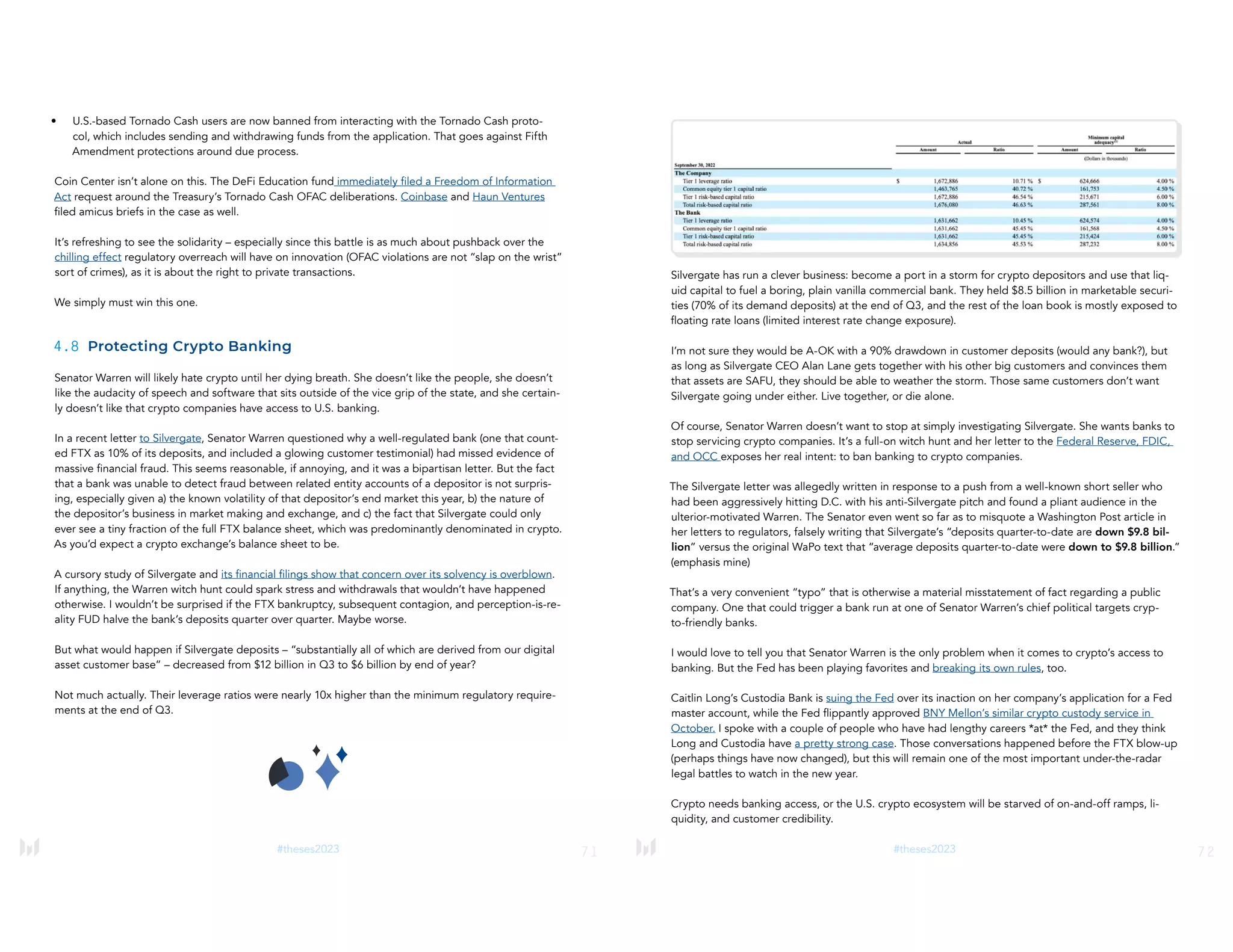
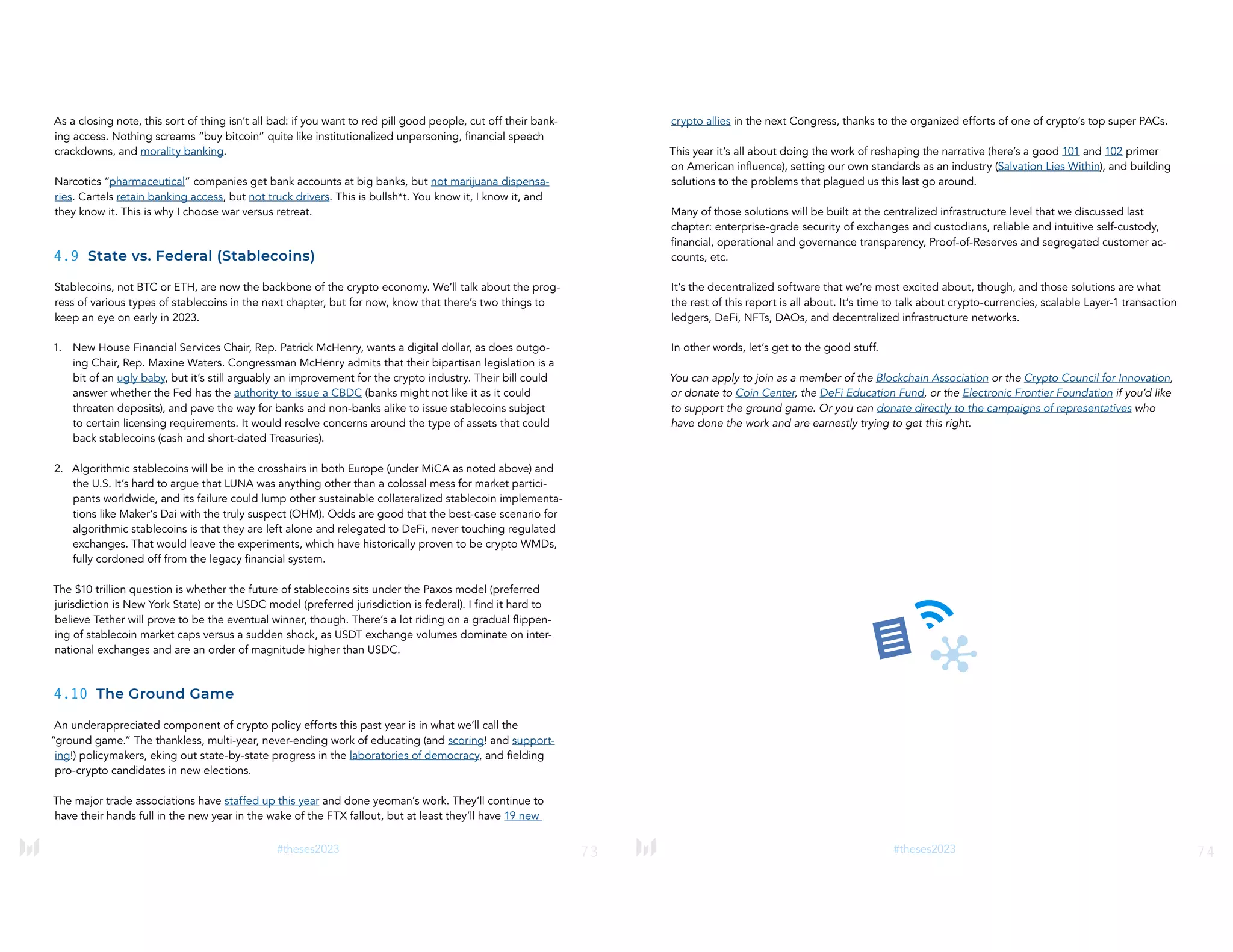
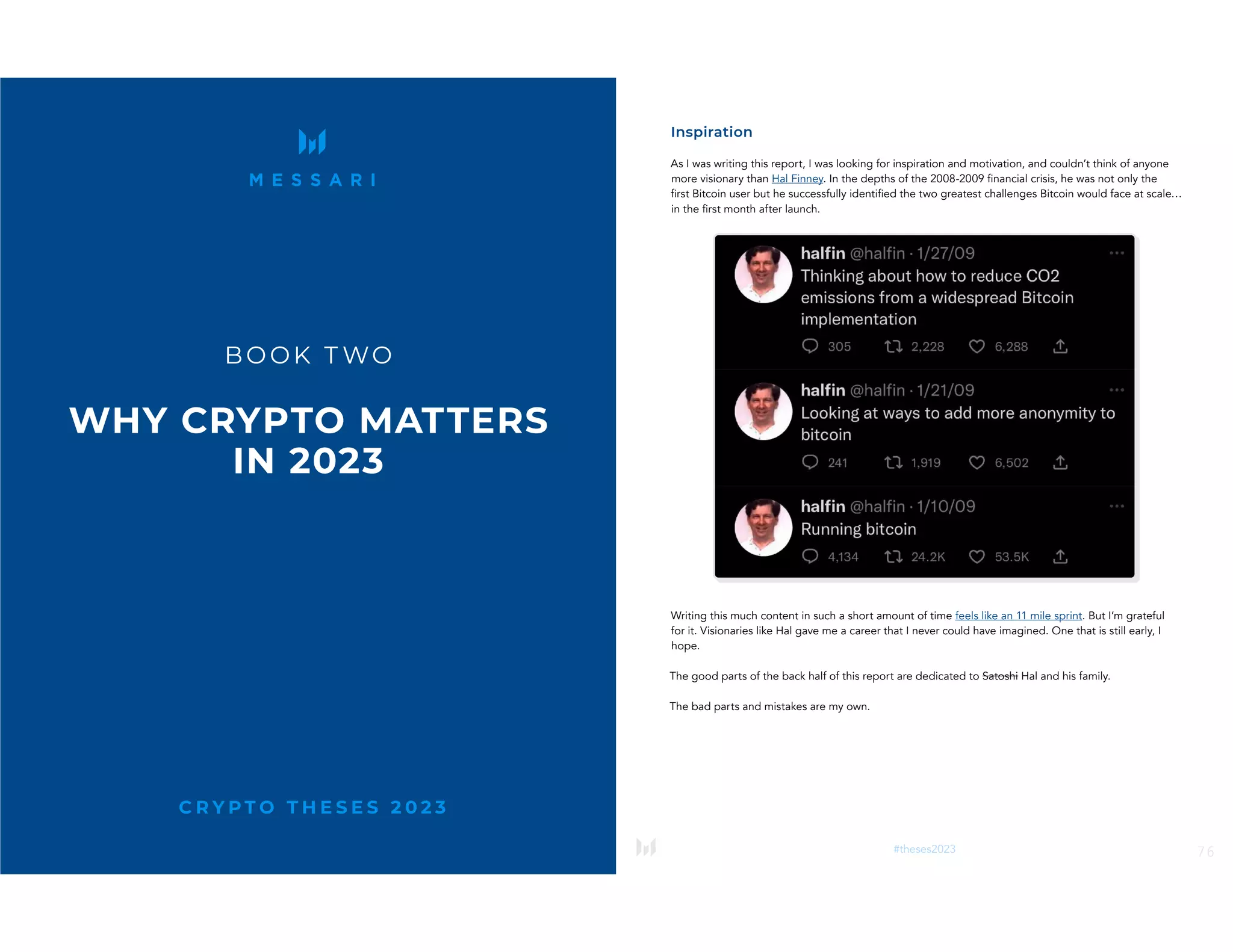

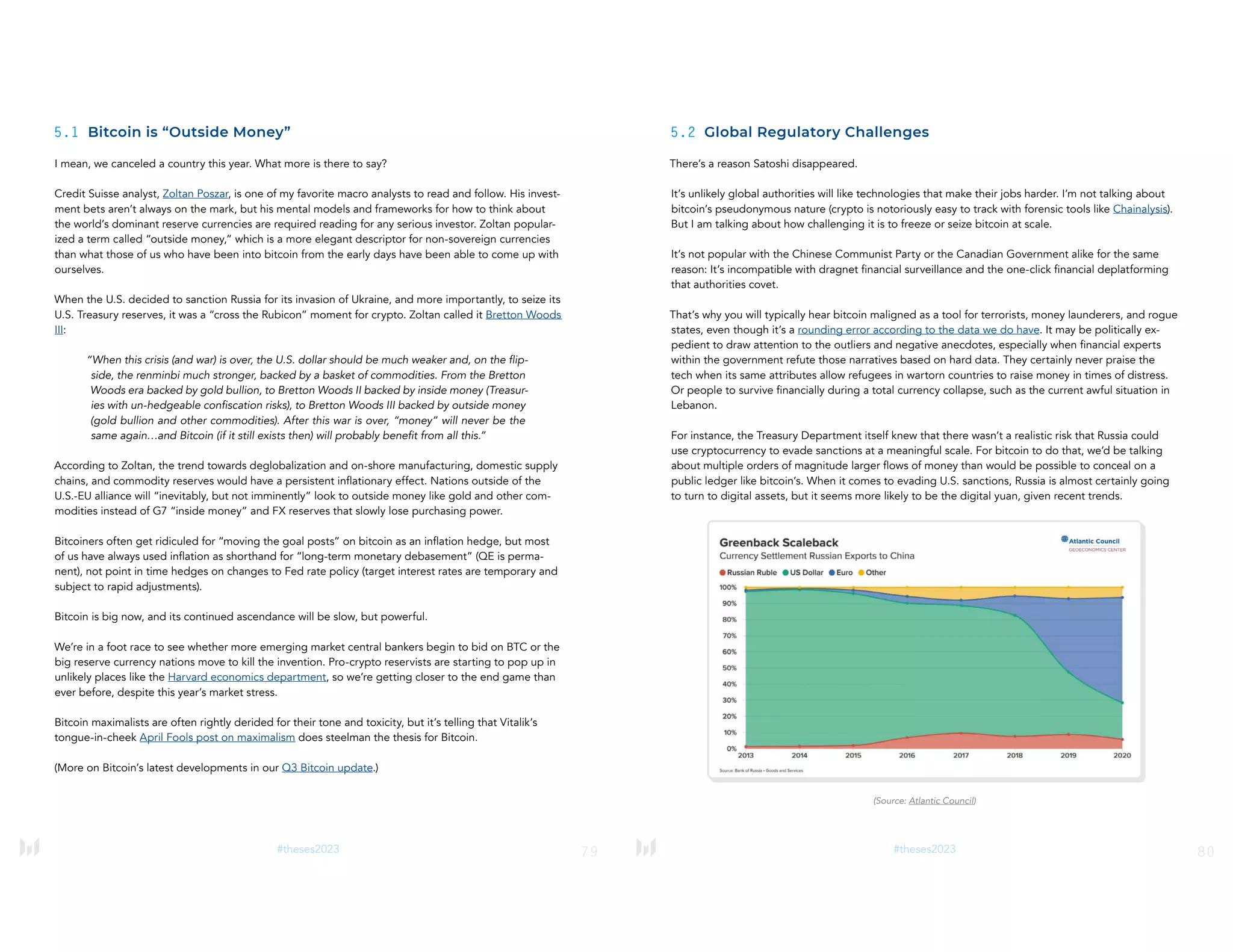

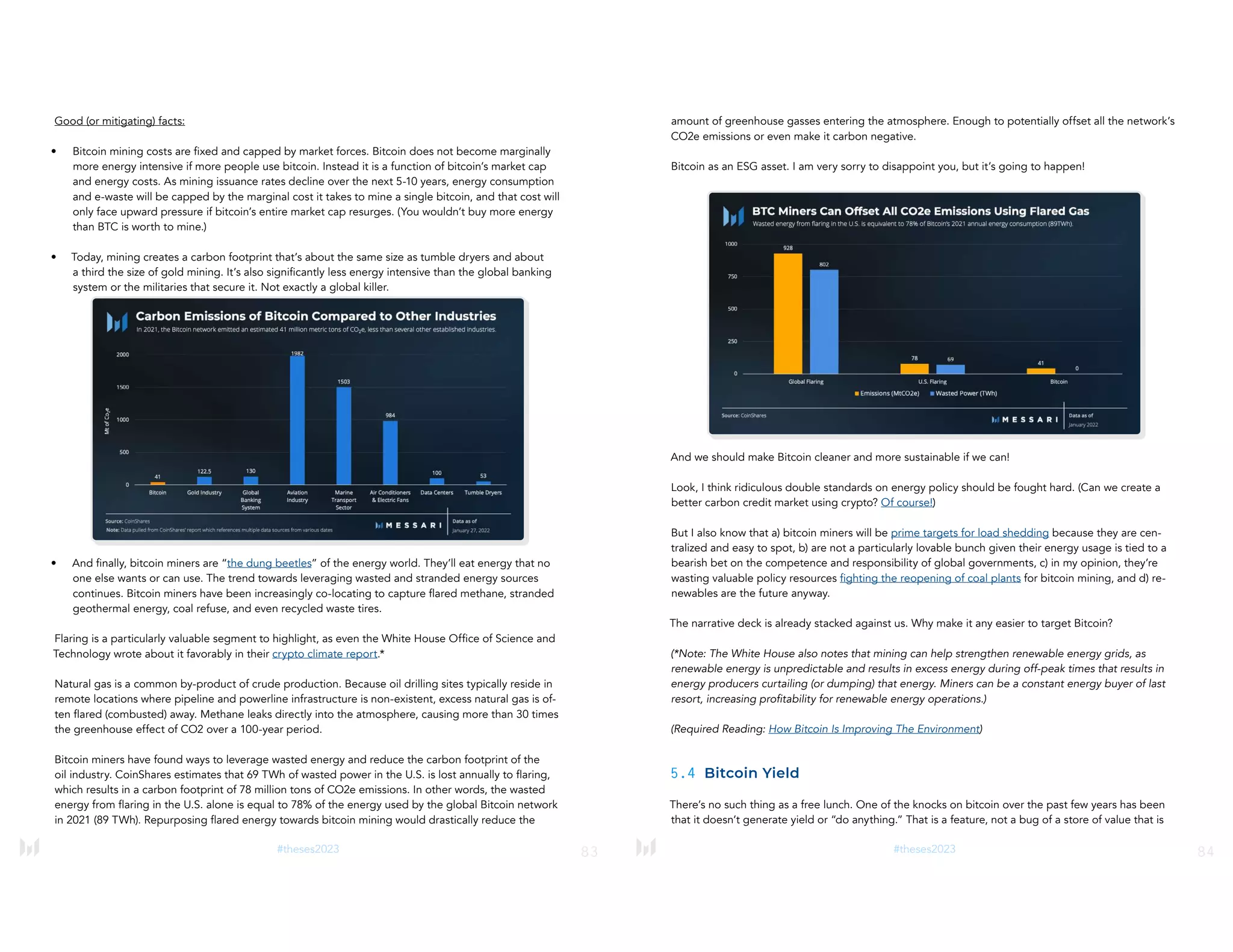
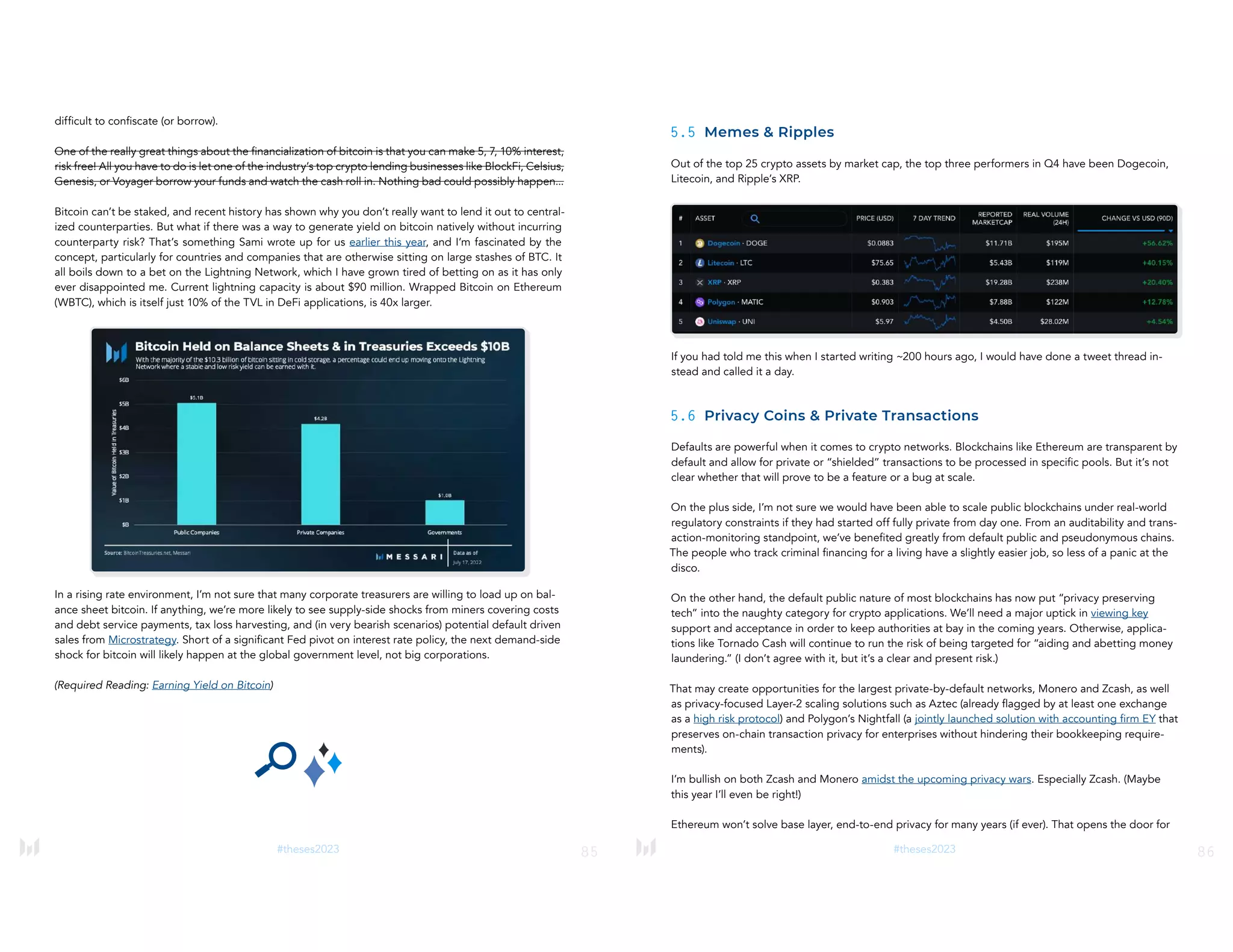
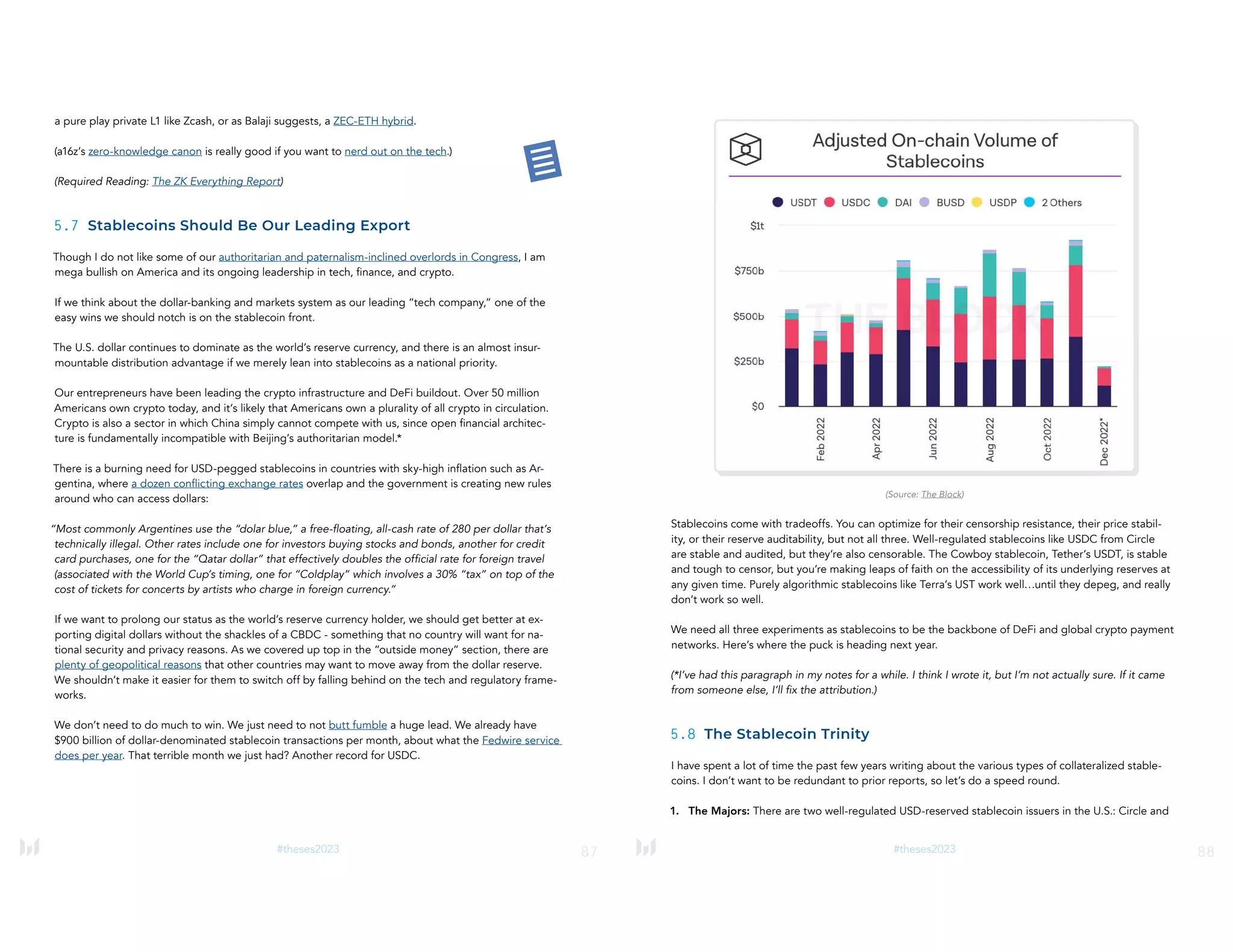
![89
#theses2023
Paxos. Circle has $45 billion in USDC and counts Blackrock and BNY Mellon as its custodians.
Paxos issues the Binance USD stablecoin (*on Ethereum) and Paxos dollar, which combined have
about $20 billion in circulation, 95% of which is BUSD. Paxos is regulated by the New York State
Department of Financial Services as a trust company, while Circle is a licensed money transmitter.
Those legal details matter in terms of how these issuers may jockey for regulatory positioning
going forward. Paxos has a trust company charter and conditional OCC charter, so it likes keep-
ing things cozy in New York State, while Circle is pushing harder for federal stablecoin legislation.
Paxos is “more regulated” and has the biggest global exchange (and Mastercard and PayPal) as
its white label customers, and USDC is the most dominant Ethereum-based stablecoin, and DeFi
reserve, but faces FUD at times.
2. The Cowboy: Tether’s market dominance has declined each year over the past several years, and
it continued to narrow this year, as BUSD and USDC ate into its ETH-based market share in par-
ticular. USDT is still 50% larger thanks to the dominance of Tether on the Tron blockchain, but it
has otherwise lost its lead. USDT on Tron is mostly an international phenomenon: the leading “not
quite U.S.-blessed” digital eurodollar.
I explained last year why it was not quite right to call Tether a fraud. USDT seems to live by a code
vs. any one law. Maintain full reserves (they publish semi-annual audits, but no one will ever be
happy), but keep out of reach of any jurisdictions whose authorities seem trigger happy to seize
assets. At times, they have been under-reserved, such as the 2016 Bitfinex hack (and customer
bail-in) and the 2018 theft where they were a victim of an $850 million fraud themselves. (Good
Tether overview on Odd Lots.)
You can think about the fully-reserved stablecoins on crypto exchanges and blockchains almost like
Balkanized digital nations. On Ethereum, the ranking goes USDC, USDT, BUSD. On BNB Smart Chain,
the order is reversed. On Solana, Avalanche, Polygon and most other major L1’s and L2’s, USDC and
USDT are usually #1-2 in circulation. On Binance, and most international crypto-crypto exchanges,
USDT is the top quote currency. All three are useful, and USDT on Tron is particularly underestimated,
but powerful in its own right.
Then there’s the crypto-collateralized stablecoins:
1. Dai: MakerDAO is one of the cockroaches of crypto, and I mean that in a good way. Though its
circulation has roughly halved to $5 billion from its March 2022 peak, it has shown resilience once
again in a brutal bear market. Despite the repeated shocks in the centralized crypto lending mar-
kets, MakerDAO and Dai haven’t experienced any material issues or destabilization of the Dai peg.
2. Others: most of the other crypto collateralized stablecoins are rounding errors compared to Dai
though they have similar structures, such as Liquity’s LUSD (and soon competitive stablecoins from
Aave and Curve). There’s only one other meaningful crypto collateralized stablecoin, the last algo-
rithmic stablecoin team left standing, Frax.
90
#theses2023
5.9 Algo-Stables: Crypto’s WMDs
This year’s failure of Terra and its LUNA token and TerraUSD stablecoin was swift and savage. The pain
inflicted on investors was severe, and many people lost their life savings directly or indirectly betting
on Terra’s UST. It’s a fair question as to whether we should continue running these high stakes algo-
rithmic stablecoin experiments or whether they are all doomed to die the same painful death eventu-
ally.
I’ll save you the look-back: I was optimistic on Terra in the 2022 Theses and will double down on why
below. I only started to sour on the project in January 2022 as Do Kwon’s swagger began to depeg
from reality and into God complex territory. The aggressiveness I liked in 2020 and 2021 started to
look like VC-fueled narcissism as the numbers got bigger. I sold most of my stake at the “arm tattoo”
moment in January (and said as much on Twitter).
I did warn about the very thing that undid LUNA in the end:
“[Terra’s] biggest headwinds are known unknowns, and it’s unclear whether they would
prove manageable or catastrophic to the entire Terra ecosystem…the reflexivity of UST
and its usage of LUNA as a primary source of collateral [is something] to worry about. In
a full “risk-off” environment, it’s unclear how resilient Terra and UST might be. During the
spring [2021] dump of LUNA, UST nearly became insolvent as the value of LUNA fell be-
low the total value of UST in circulation. It took a $70mm capital infusion from Terraform
Labs to shore up the stability reserve at Anchor, a systemically important Terra lending
protocol. That lender of last resort model works until it doesn’t.”
In hindsight, we got lucky that Terra collapsed before it got even bigger and knocked out all of DeFi.
Arthur’s take on LUNA is a great supplemental explainer as is Matt Levine’s if you want the gory de-
tails. Or there’s always a thread.](https://image.slidesharecdn.com/messari-cryptotheses2023-230101045959-80637cf4/75/MESSARI-Crypto_Theses_2023-pdf-45-2048.jpg)
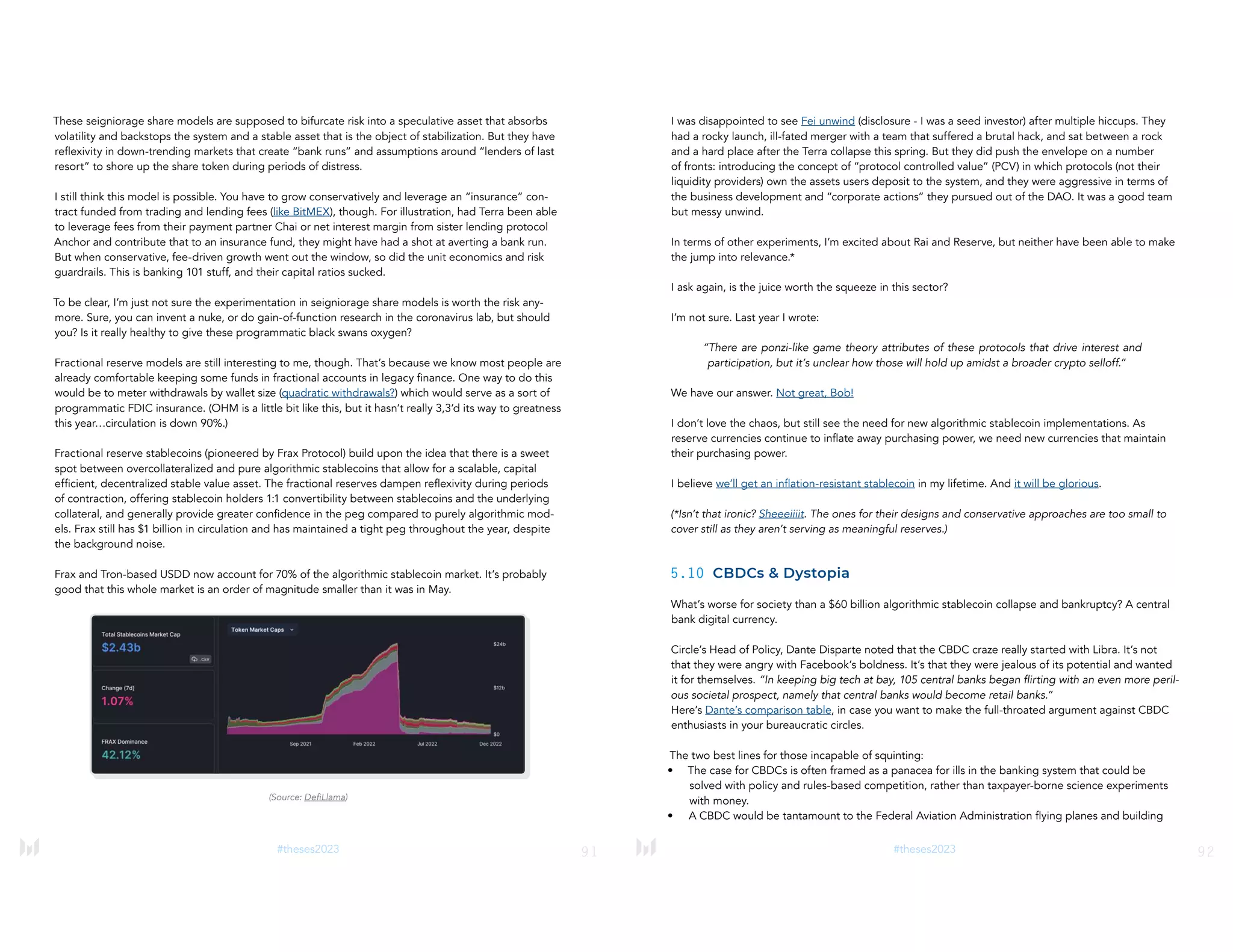
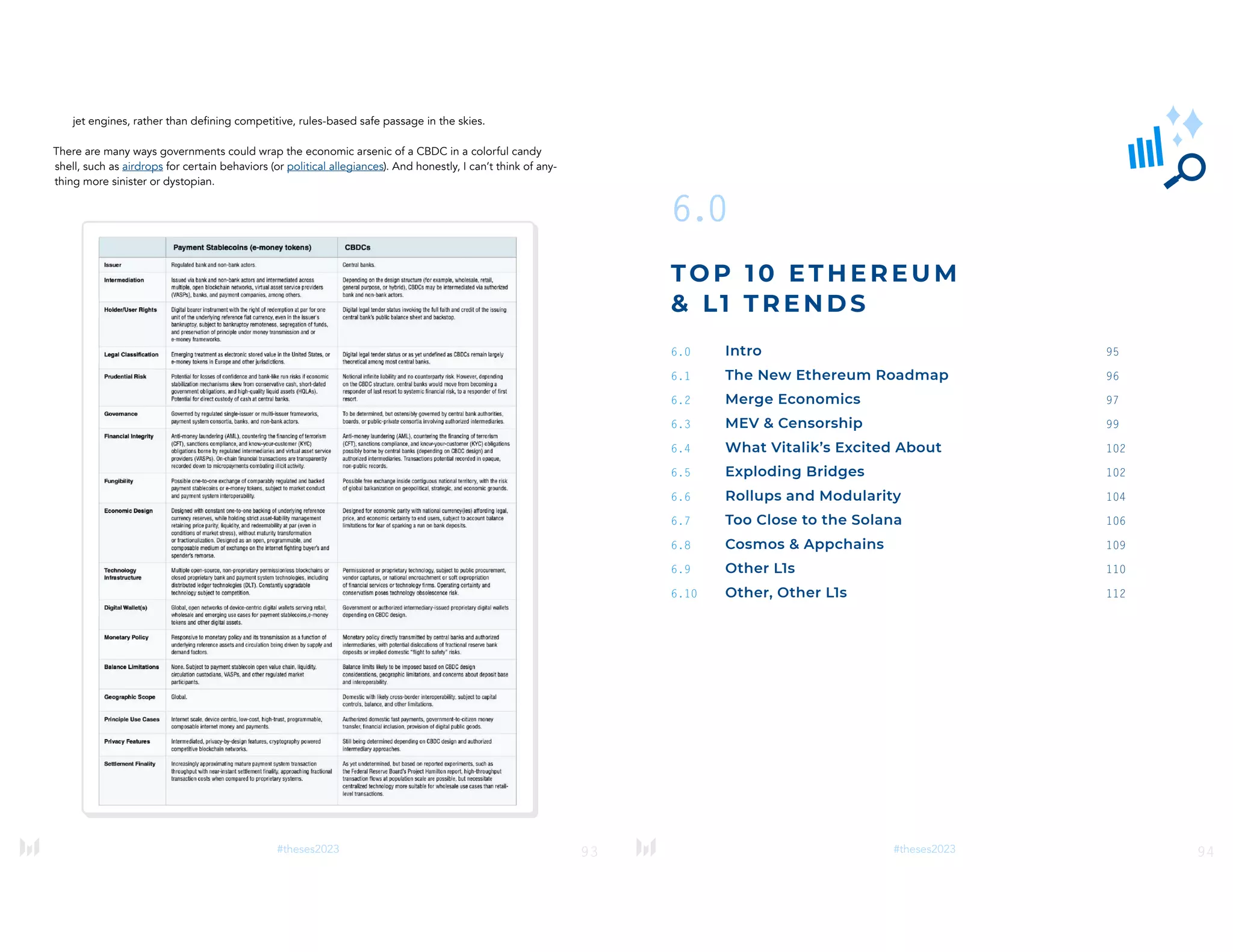
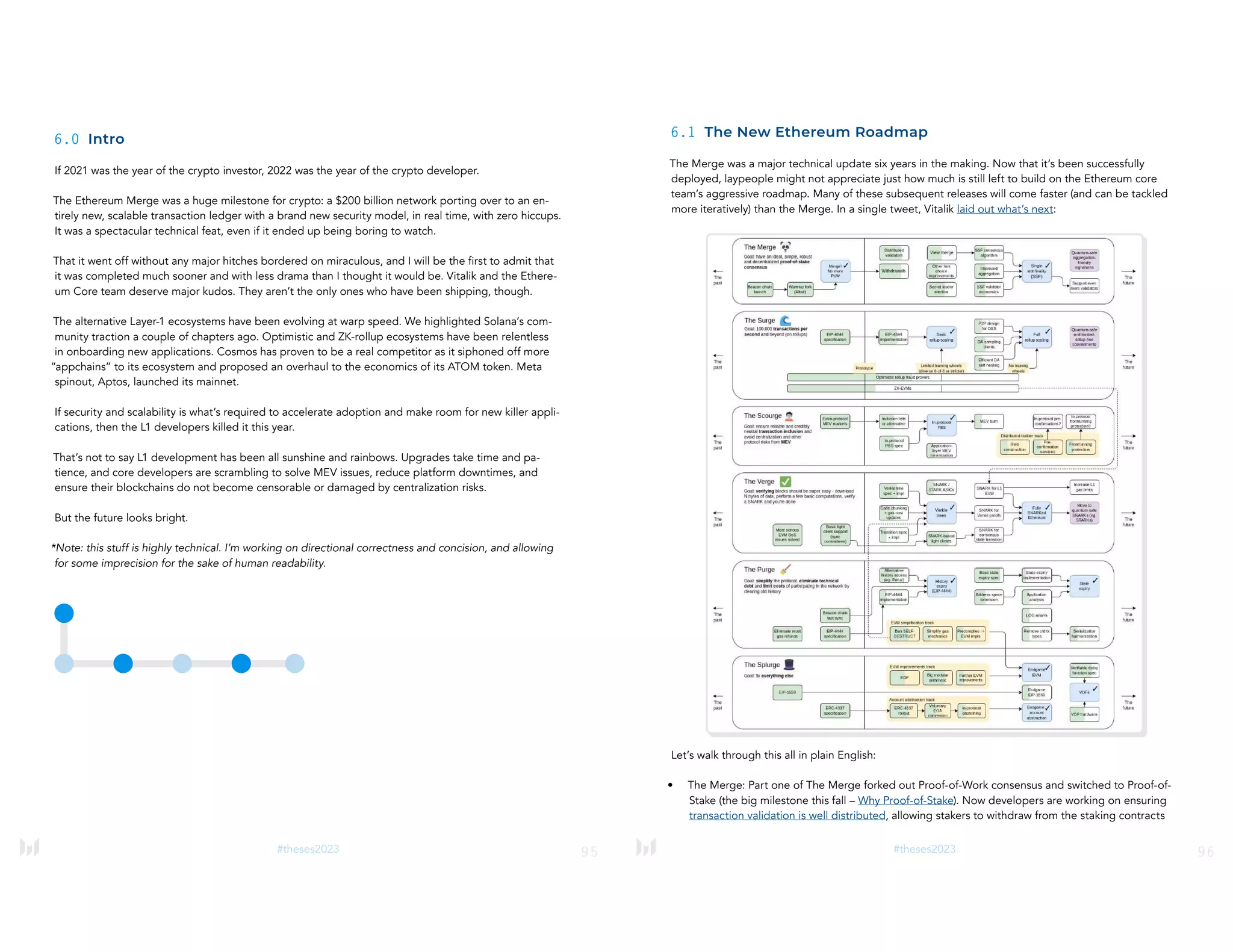
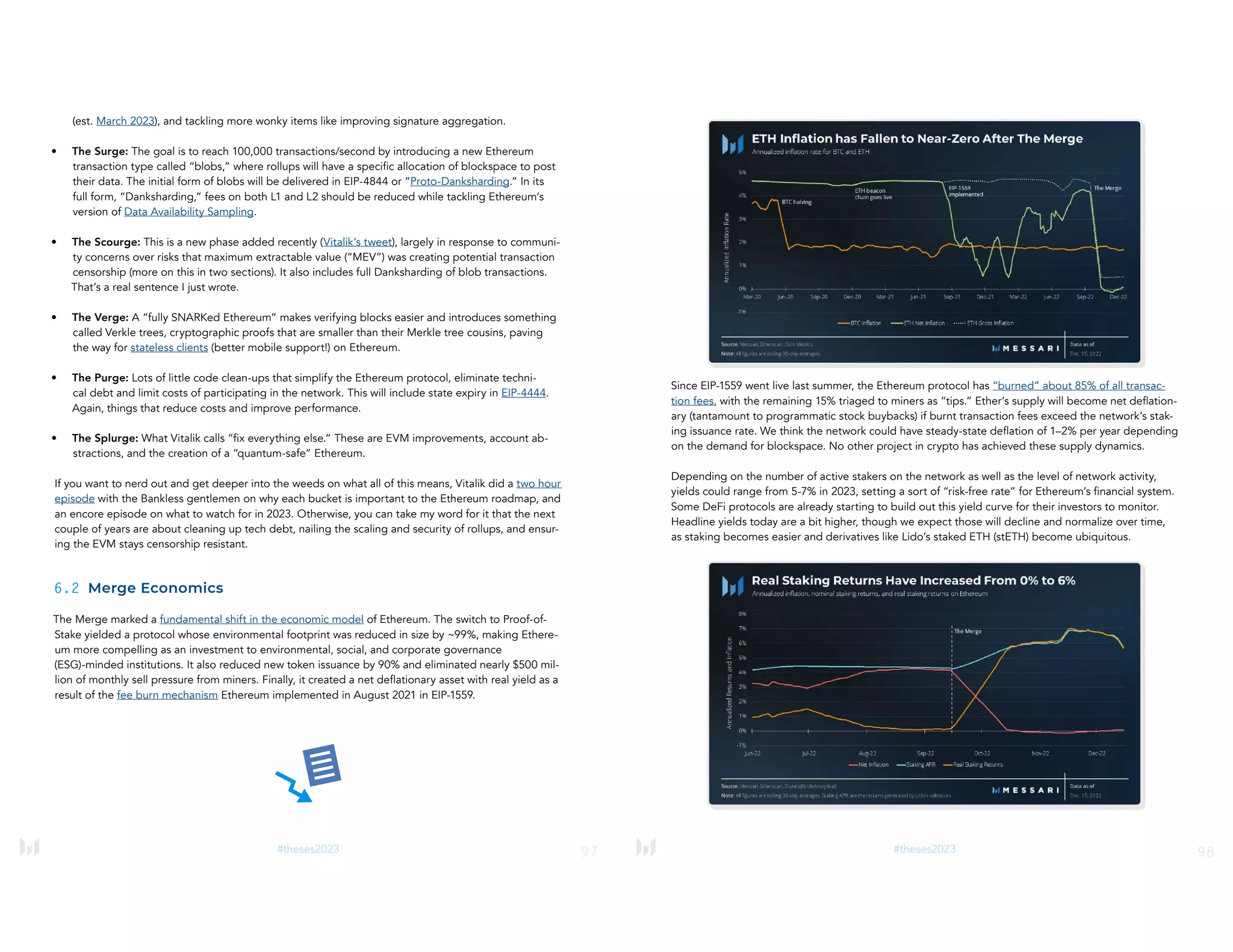
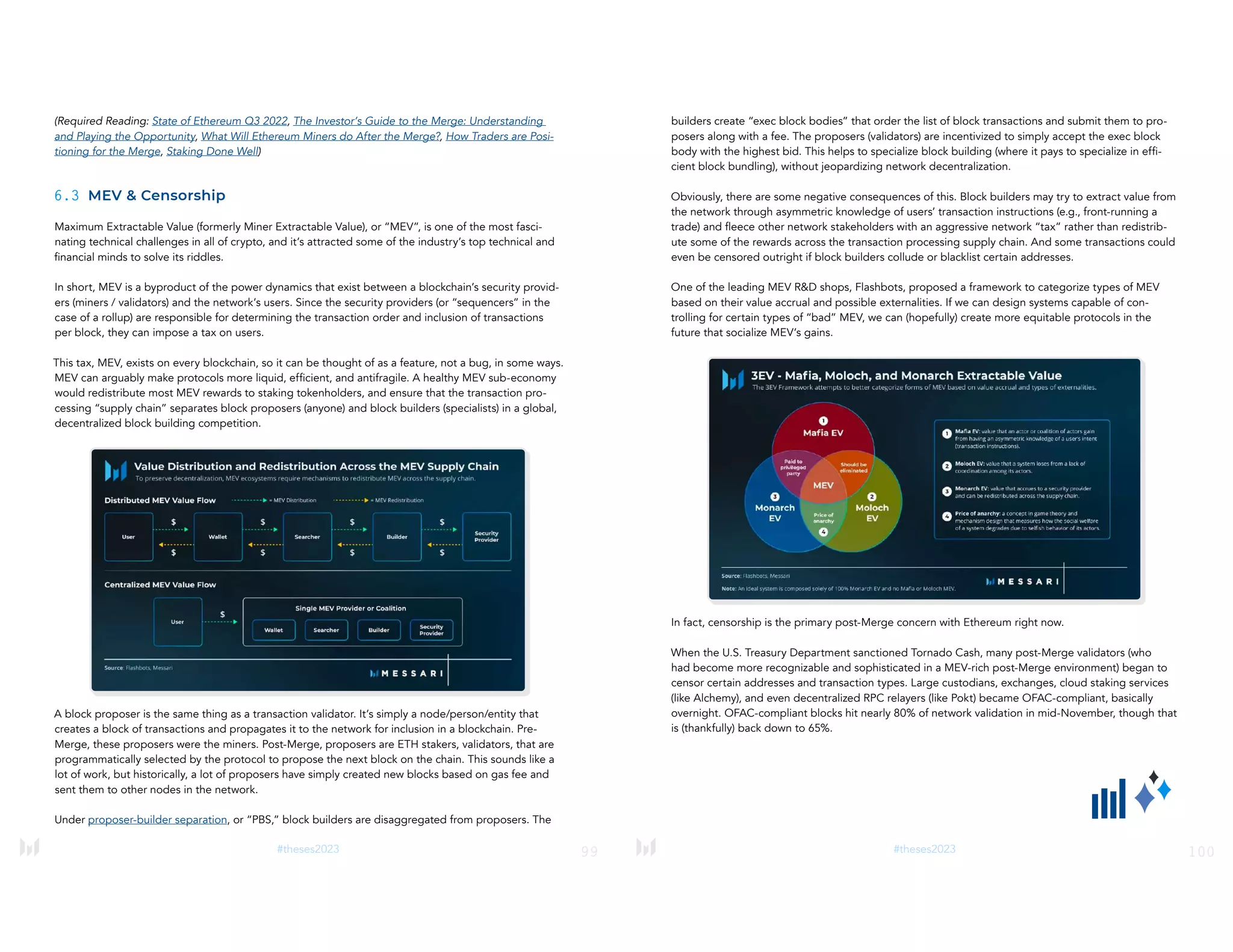

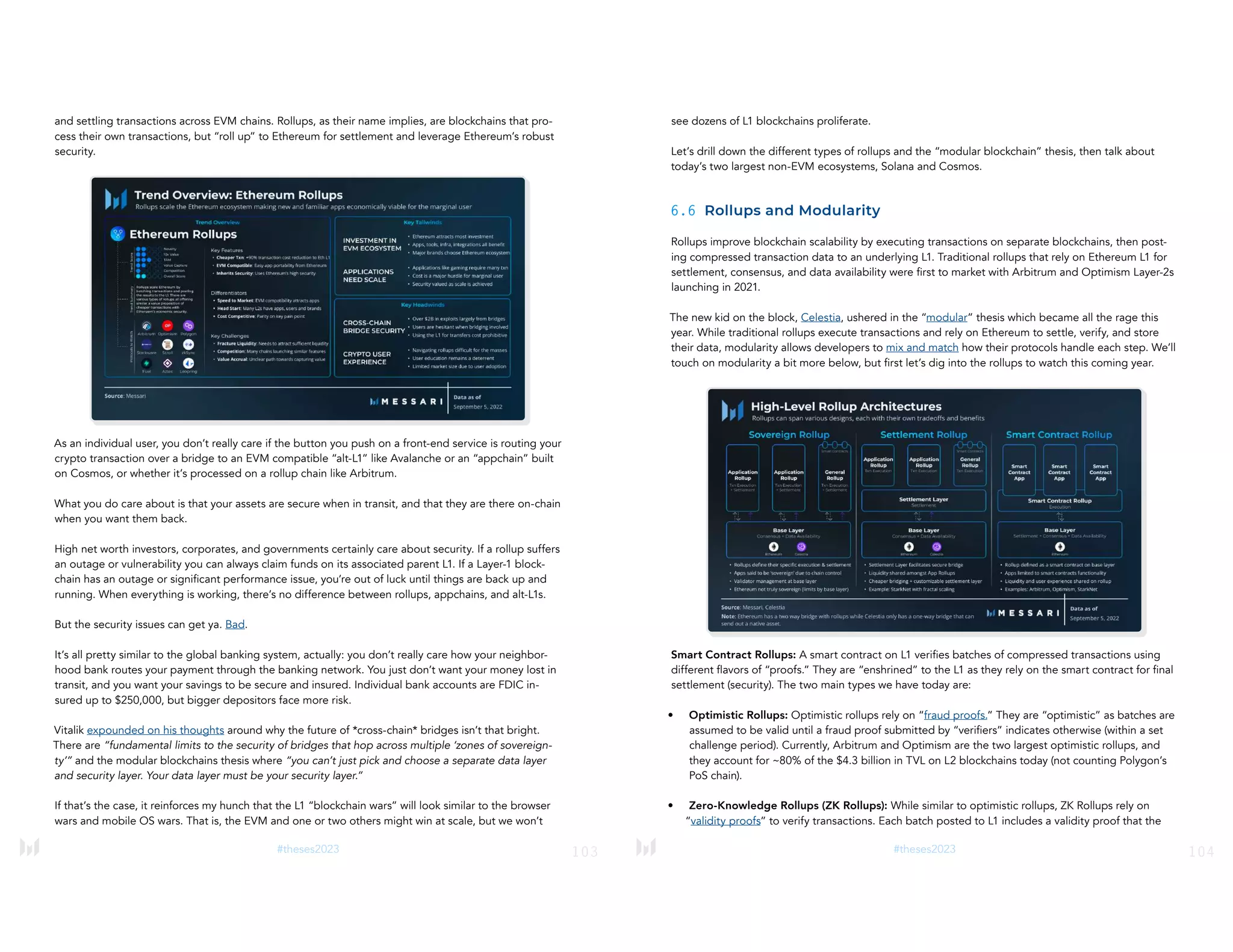
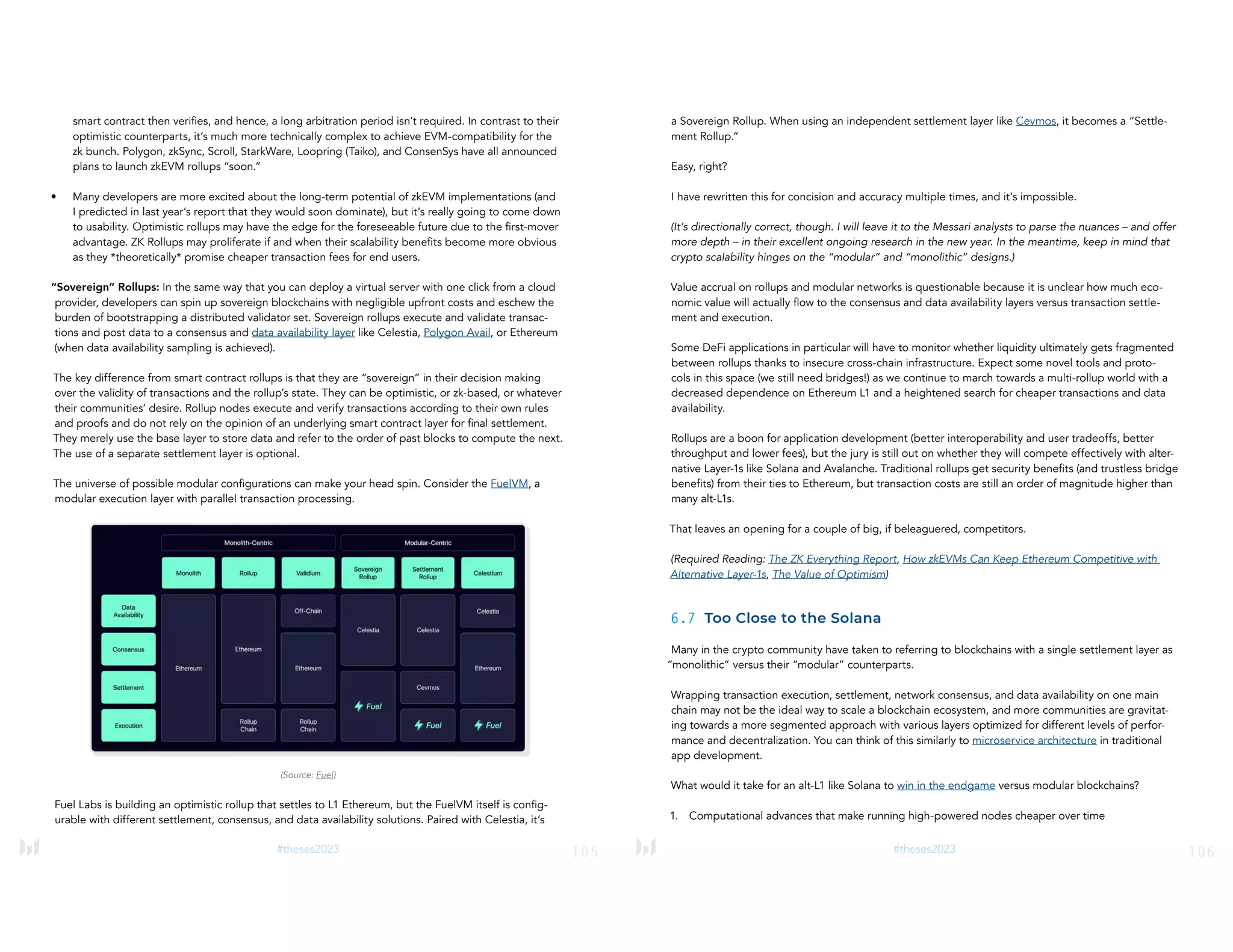
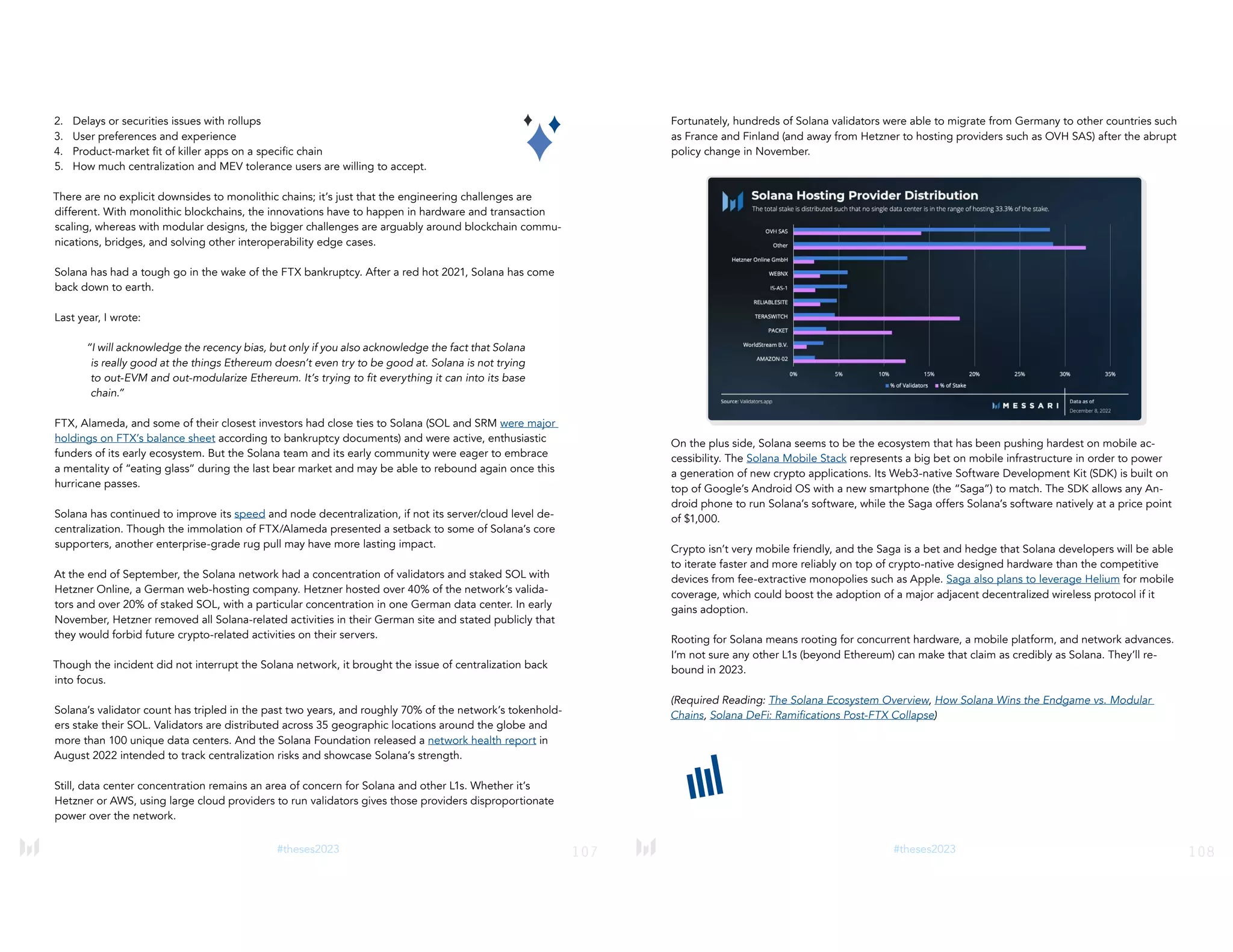
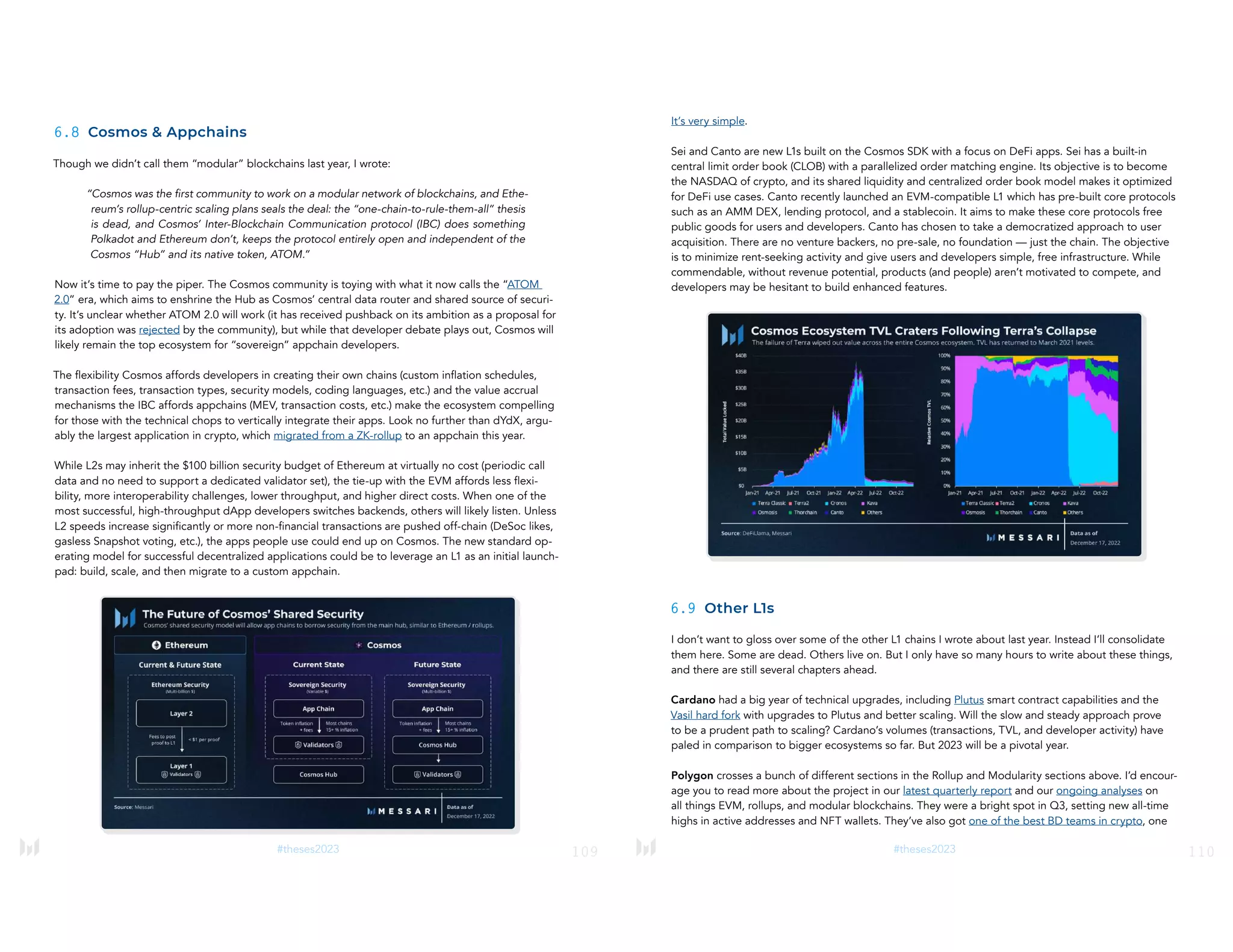


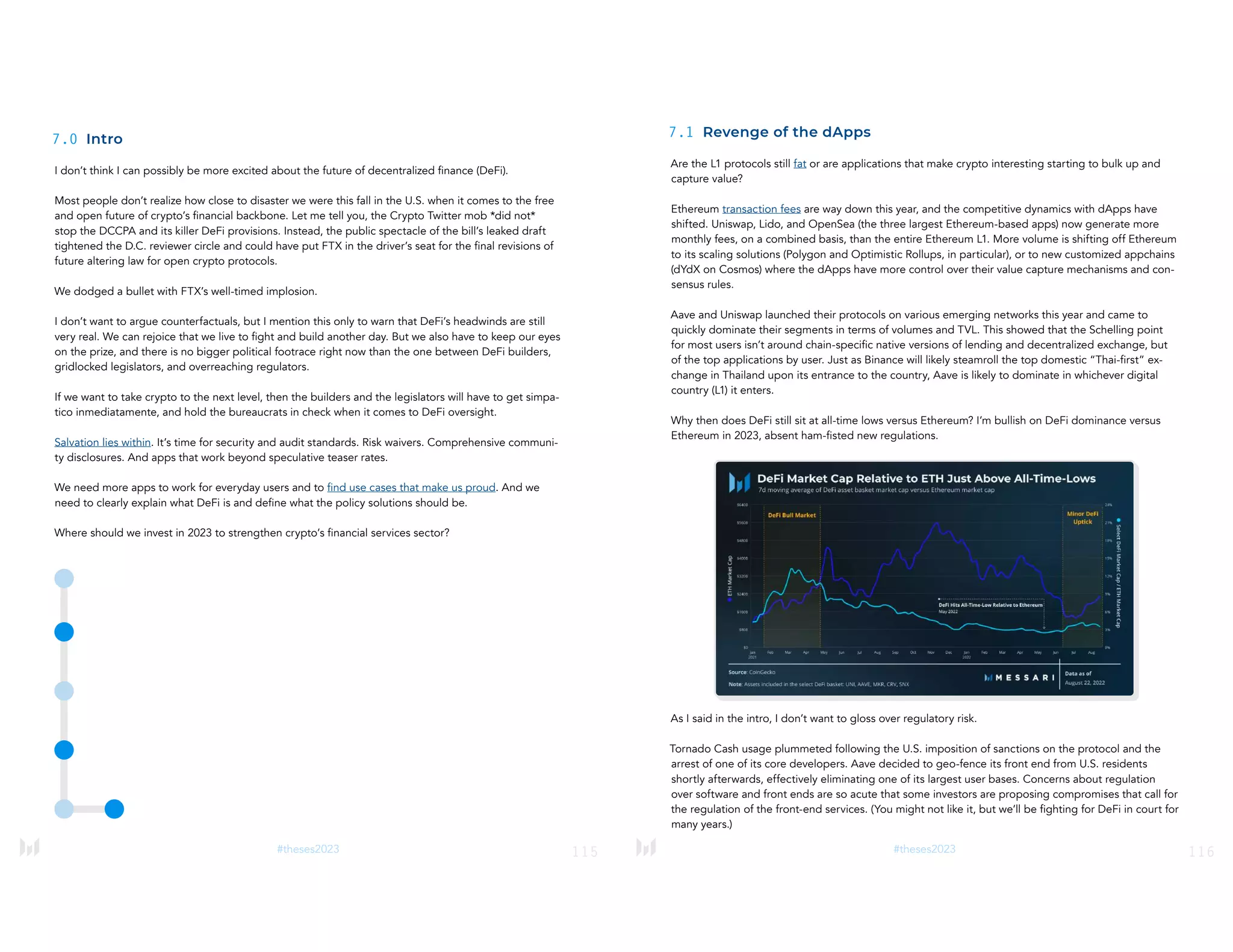
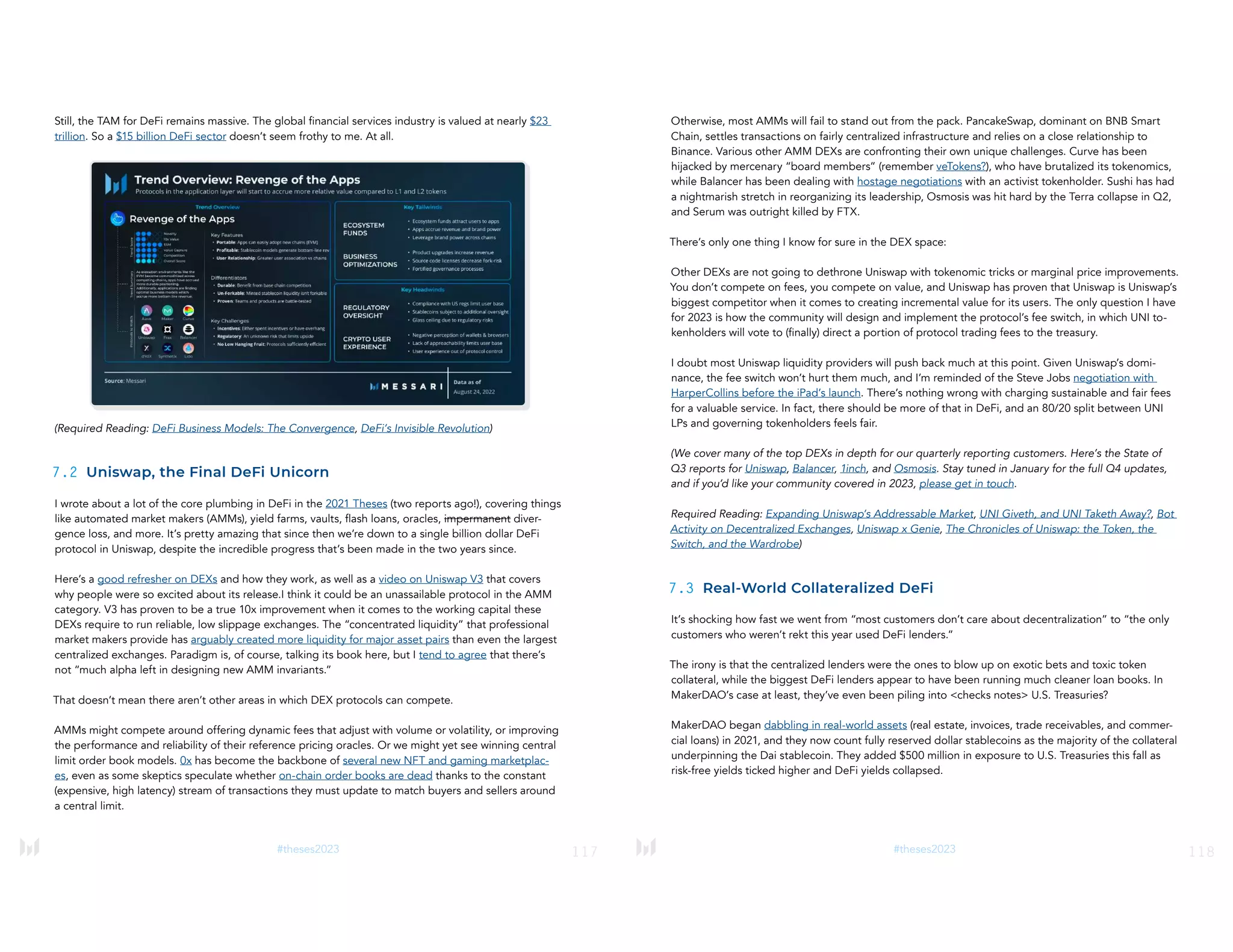
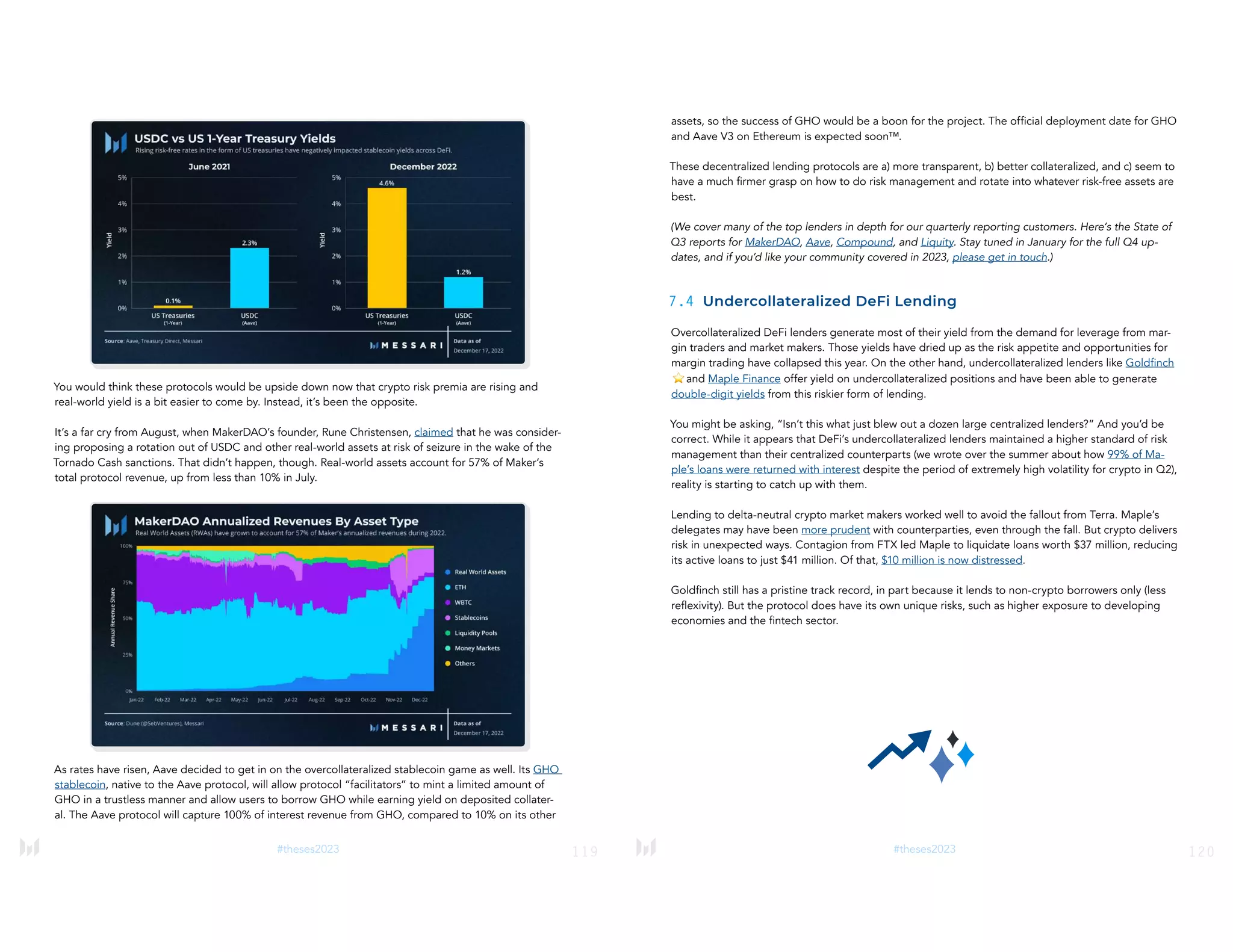
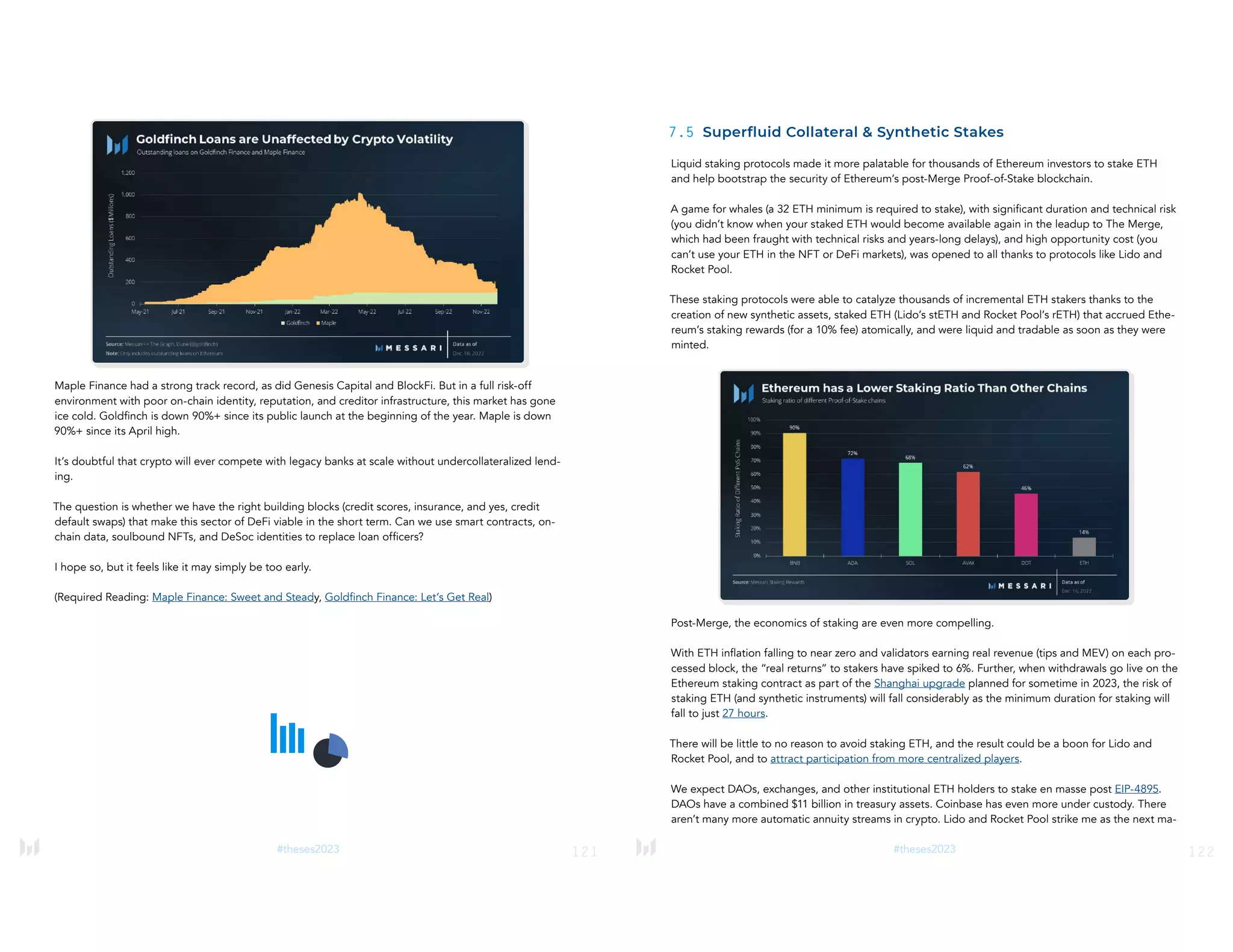
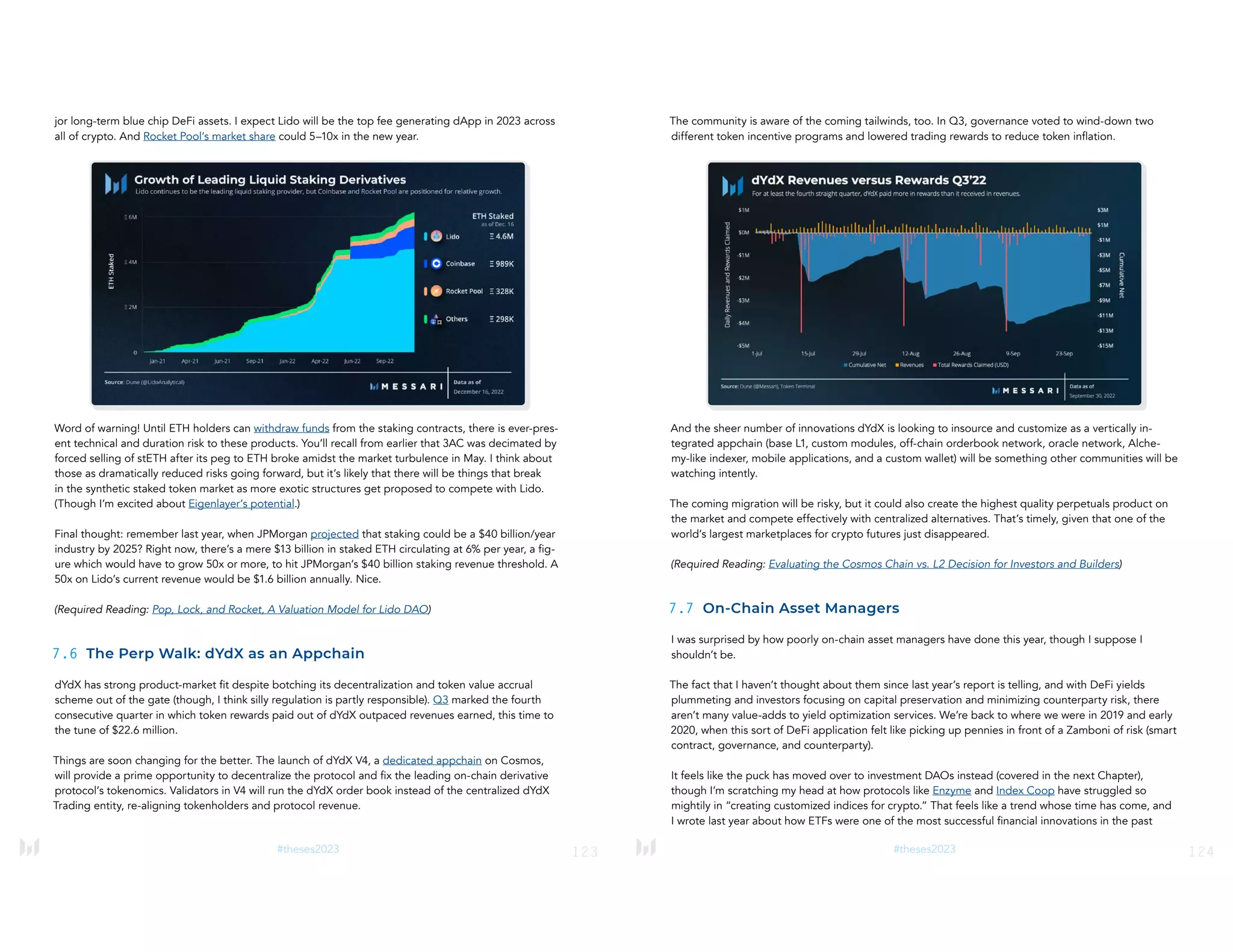
![125
#theses2023
30 years, with some $6 trillion in net assets, lower management fees, and higher net returns for their
investors.
Good active managers could make a killing this cycle as memes run out of steam and fundamentals
take over. Rules-based asset managers are now much easier to create with code, and protocols that
allow for a proliferation of on-chain funds and indices should have a stronger showing in 2023, provid-
ed they are built overseas. (The SEC *definitely* won’t like these.)
I’m going to run back this prediction for one more year:
“There’s opportunities for smart beta products, sector specific plays, portfolio copy-trades,
and more. The biggest near-term opportunity could be shadow stonks, like we’ve already
seen on Synthetix, Mirror, UMA, etc. Consider that the “total value secured” by Chainlink
oracles (smart contracts that leverage their data infrastructure) [is now $16 billion, down
80% year over year, but still 2x higher than it was in 2020] and you have the foundation
for something big. Reliable oracle data, synthetic stocks, and indices smart contracts…all
we need are CNBC talking heads for distribution, and we’re full-stack, fam.”
7.8 New Novel Markets: Two Truths & A Lie
Can you spot the lie?
a. Anyone who follows me knows that my side hustle to crypto is ESG investing. Whenever you can
invest in a provably sustainable, green, and socially conscious organization, you should. And I’m glad
more people are starting to agree with me, even if it’s only on a voluntary basis.
So you can imagine how excited I am about crypto protocols like Nori, Flowcarbon, KlimaDAO and
Toucan, which are laying the groundwork for corporations and individuals to reduce their carbon foot-
prints, by revamping the broken carbon trading markets. By tokenizing carbon offsets and establish-
126
#theses2023
ing reputable on-chain carbon marketplaces, these protocols have the power to bring transparency,
liquidity, and aggregation to the global green markets.
I’m bullish on “regenerative finance.”
b. Real estate finance is one of the largest markets in the world. So it should be expected that there
will be a massive opportunity for crypto protocols to innovate in this area. Physical real estate plays
that leverage crypto haven’t taken off yet, such as Propy (tokenized real estate), Milo Credit (collater-
alized mortgage lending), and Vesta Equity (fractionalized ownership), and I’m skeptical that there is
a near-term path to crypto’s meaningful participation in such a heavily regulated and physical asset
class.
That said, there are pockets that could be interesting. Housing prices are up 33% since the start of the
pandemic, and the average 30-year fixed-rate mortgage is at its highest level in over a decade (up
87% since last December). The majority of commercial institutions have ceased accepting new appli-
cants for home equity loans since the 2008 recession, and I can tell you from first-hand experience
that the lenders hate when the majority of your net worth is in crypto. I wonder if this is the sector
where undercollateralized lending could actually work. Buy a crypto-friendly bank, deposit holdings,
and secure loans against your house AND crypto. It’s not necessarily a cost saver, but it could boost
the accessibility of the mortgage market to more home buyers.
I’ve got to admit, I’m much more excited about crypto protocols that fractionalize NFTs and virtual
property than I am about physical real estate plays. When in doubt, natively digital property will be
easier to secure on natively digital ledgers. The physical markets will always come last.
c. I believe in prediction markets.
Ok, now guess the truths and the lie.
Give up?
Fine, it’s the prediction market one.
Prediction markets feel like a use case for crypto that’s always one year away. I’m surprised they yield-
ed essentially nothing of value in a high-stakes election year this year. Today, there’s a paltry $2 million
at stake on bets surrounding the 2024 Republican Presidential nomination in the US on Polymarket. I
think Avichal is largely right: “Prediction markets converge to the two big use cases: 1/ speculating on
the price of assets & 2/ sports betting. #1 is DeFi. I do think someone will do a sports betting ‘DEX’
but it requires sports specific oracles.” Legal sports betting is growing without the added risks of
crypto, and no one wants to gamble on tokens right now. Nothing to see here.](https://image.slidesharecdn.com/messari-cryptotheses2023-230101045959-80637cf4/75/MESSARI-Crypto_Theses_2023-pdf-63-2048.jpg)
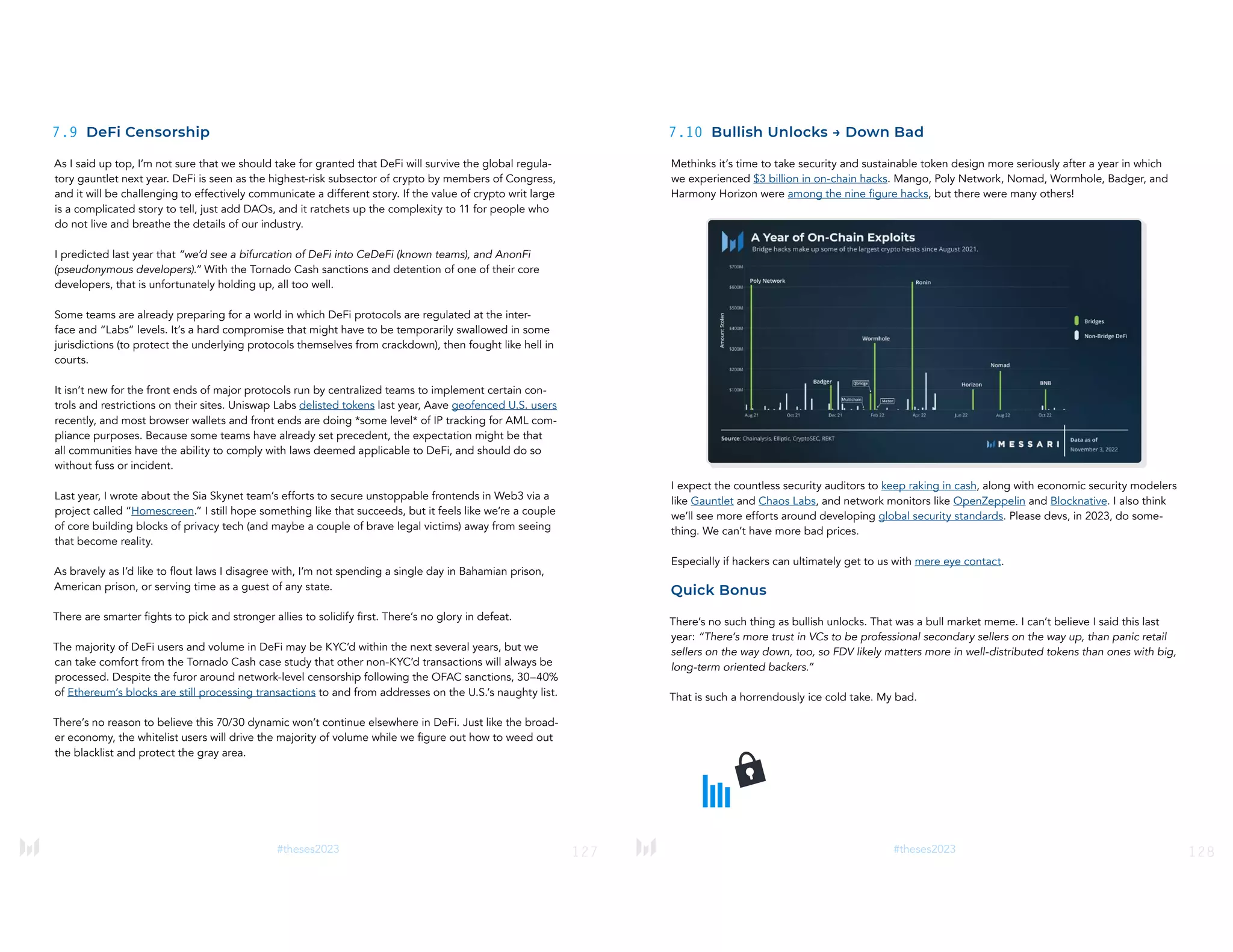
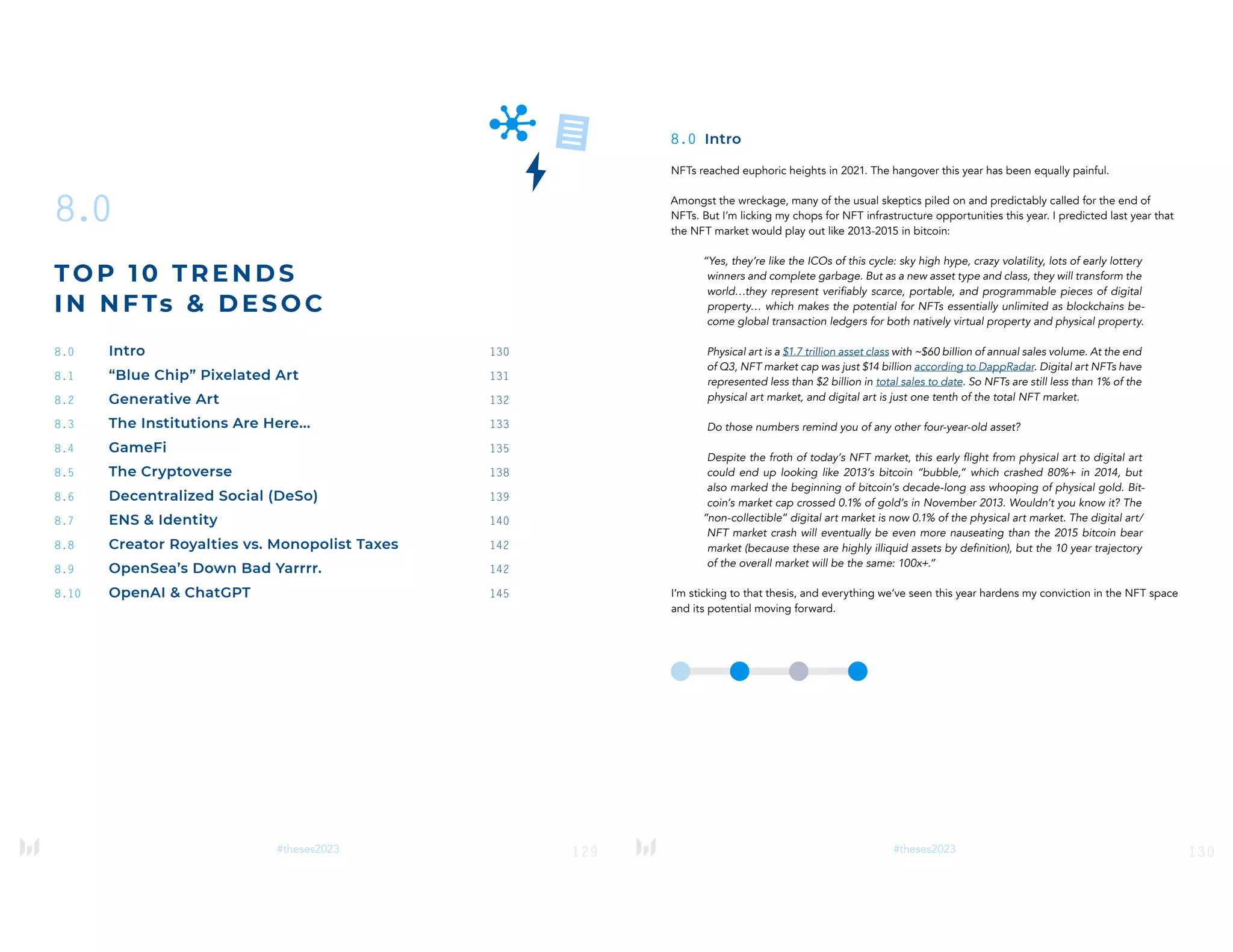

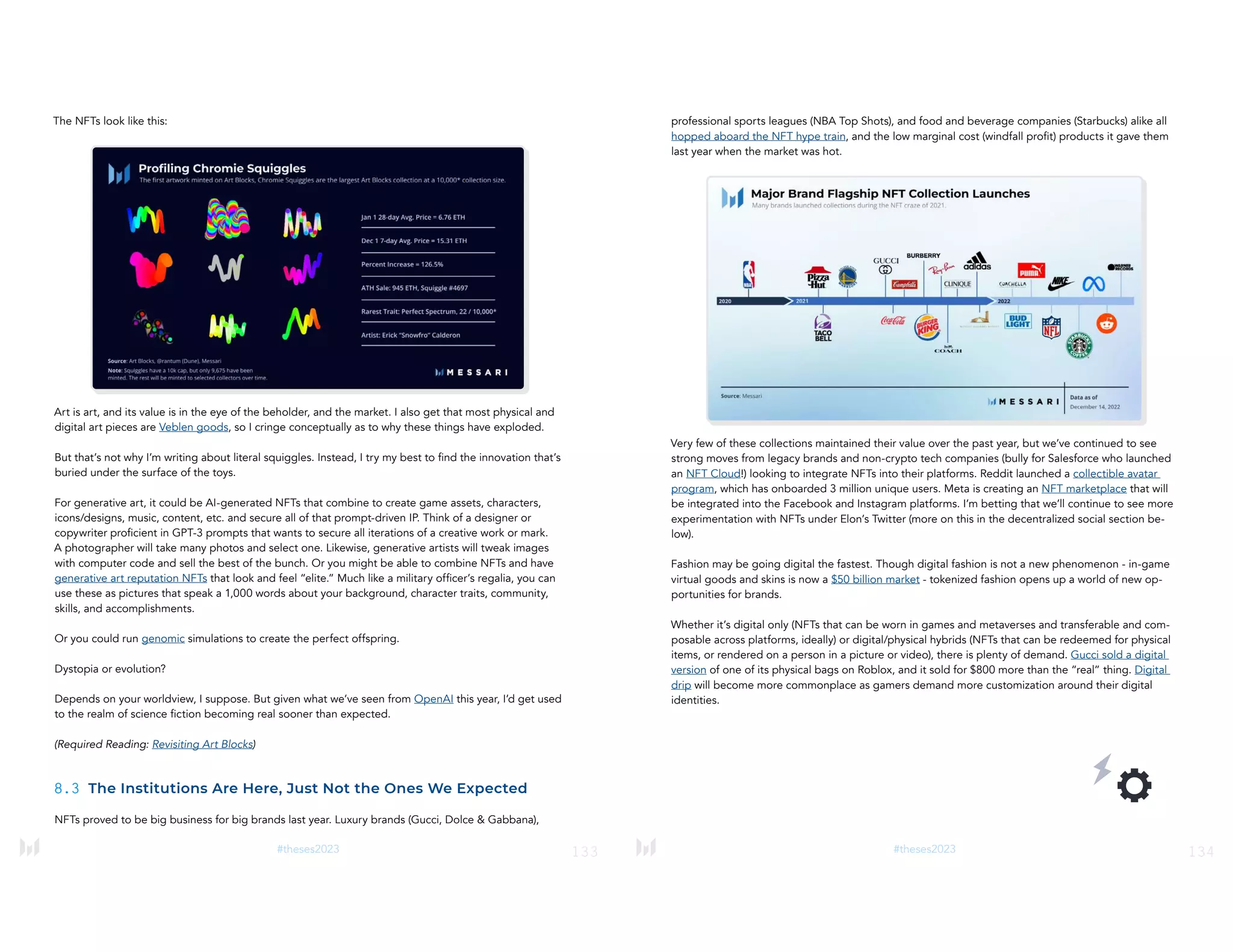

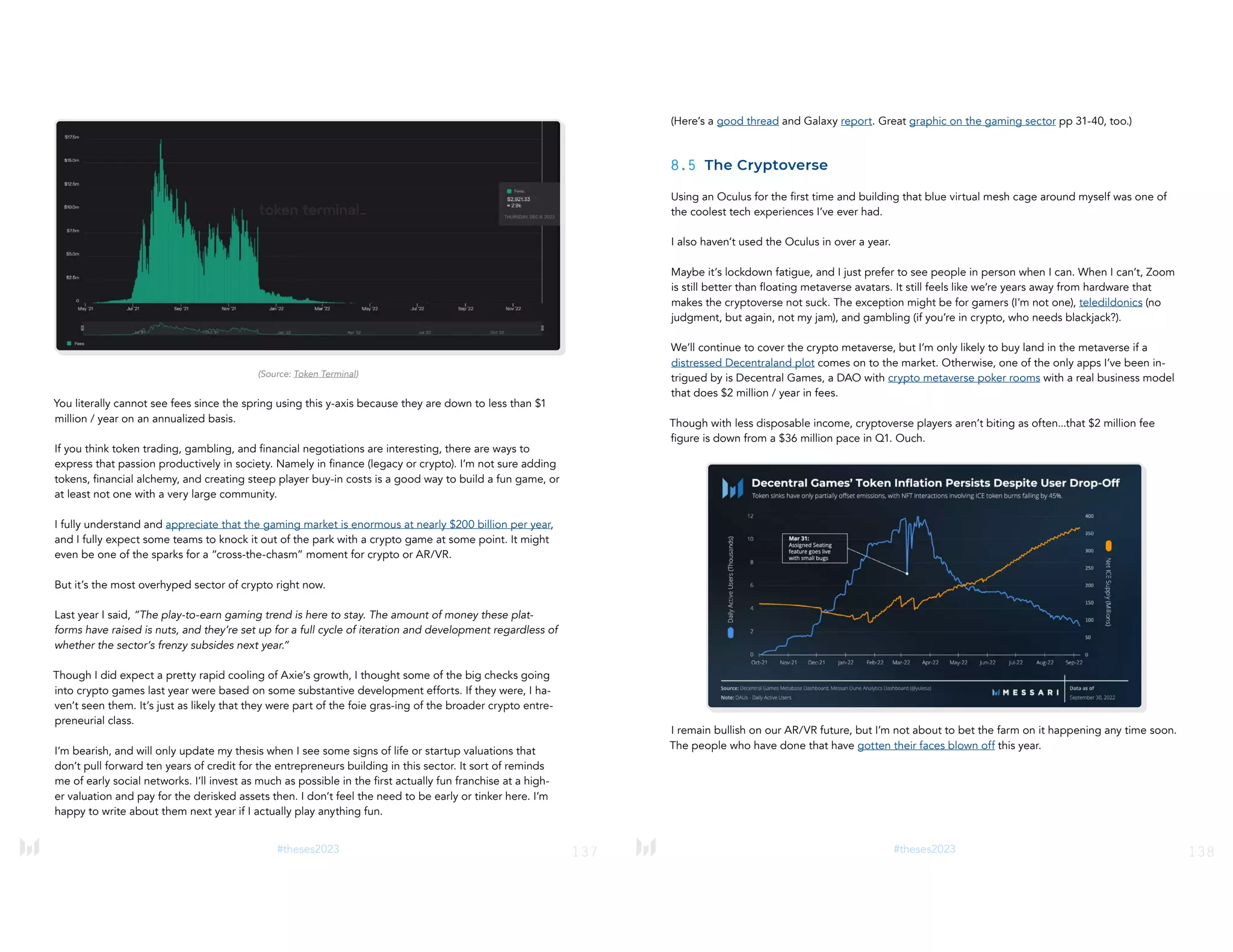
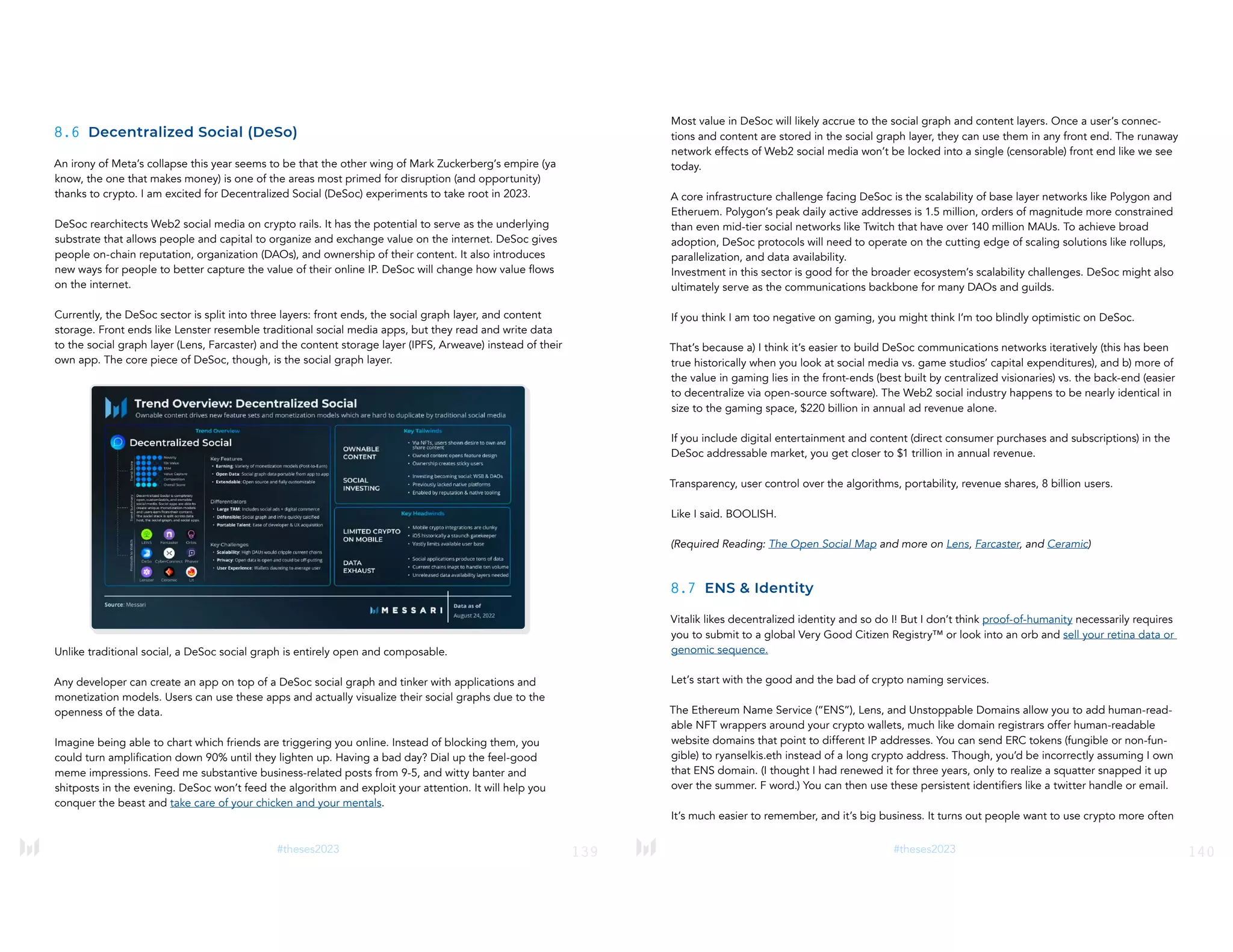
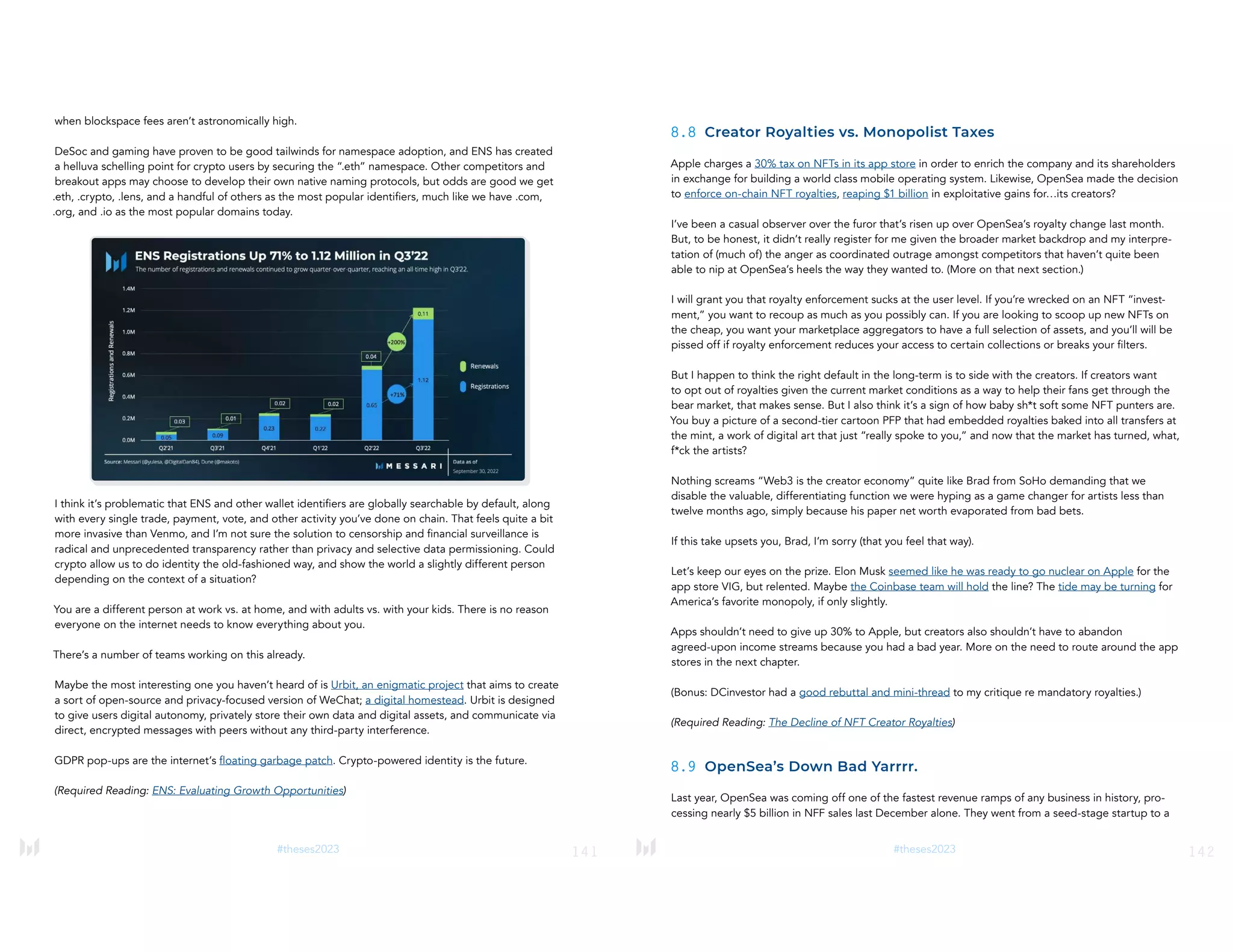

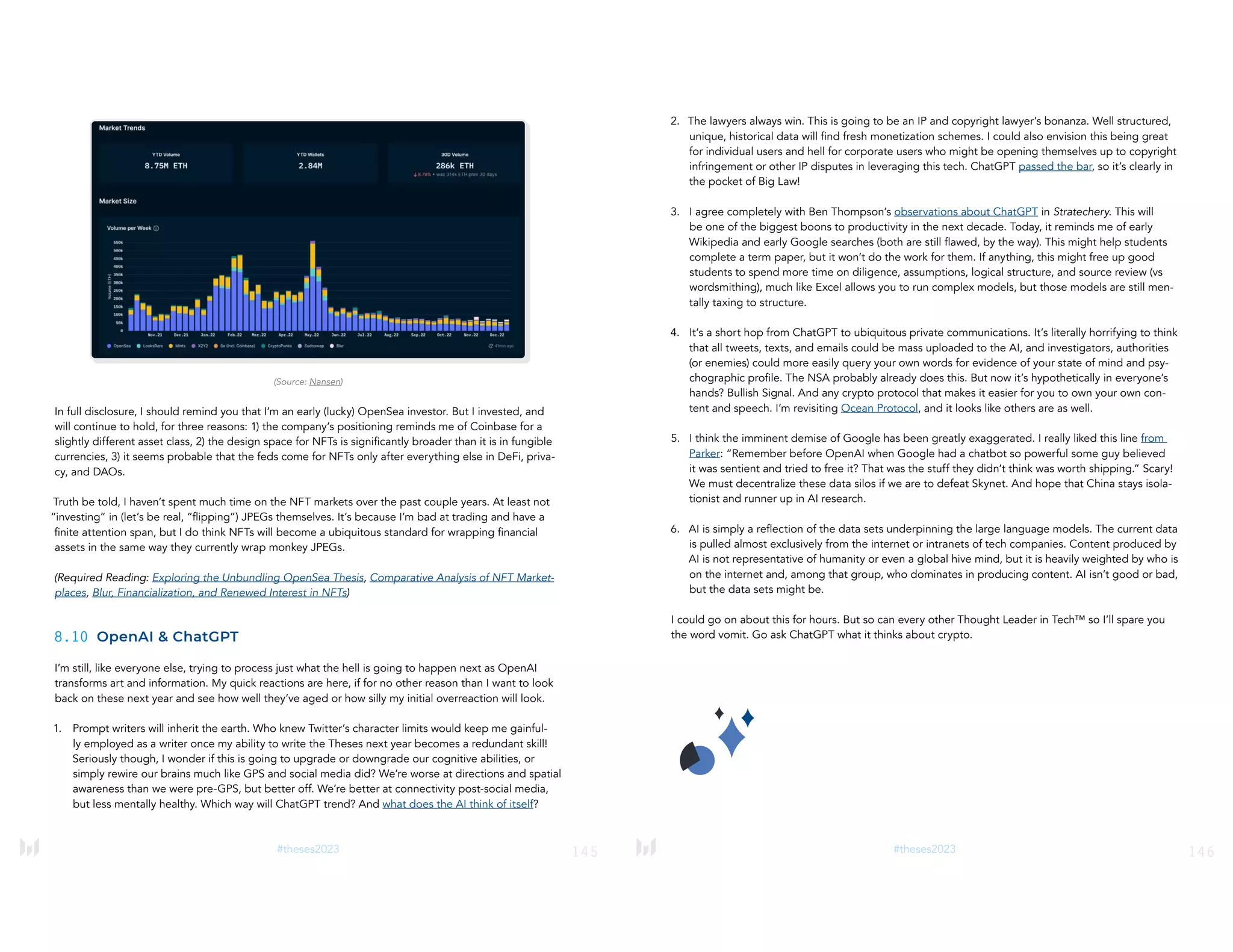

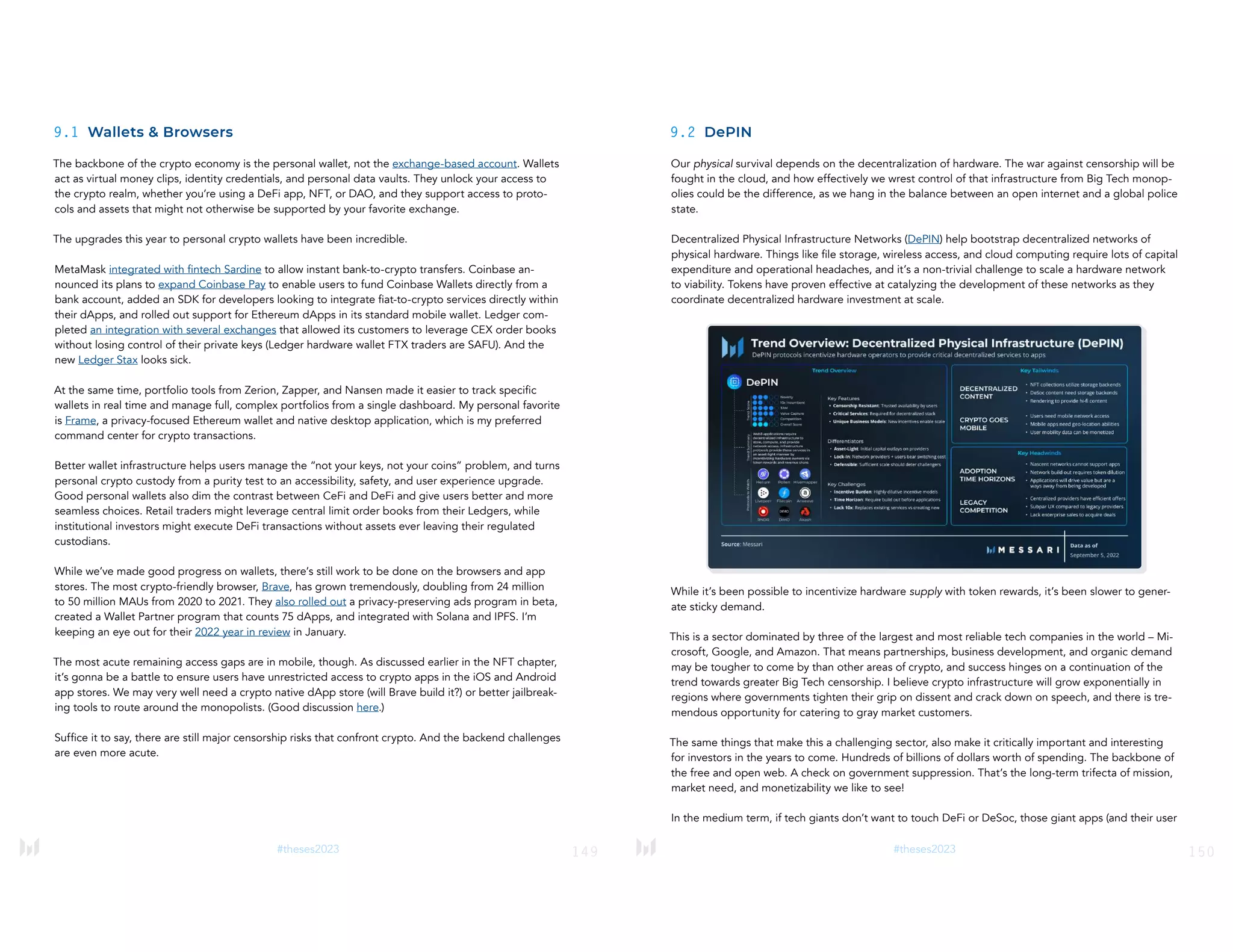
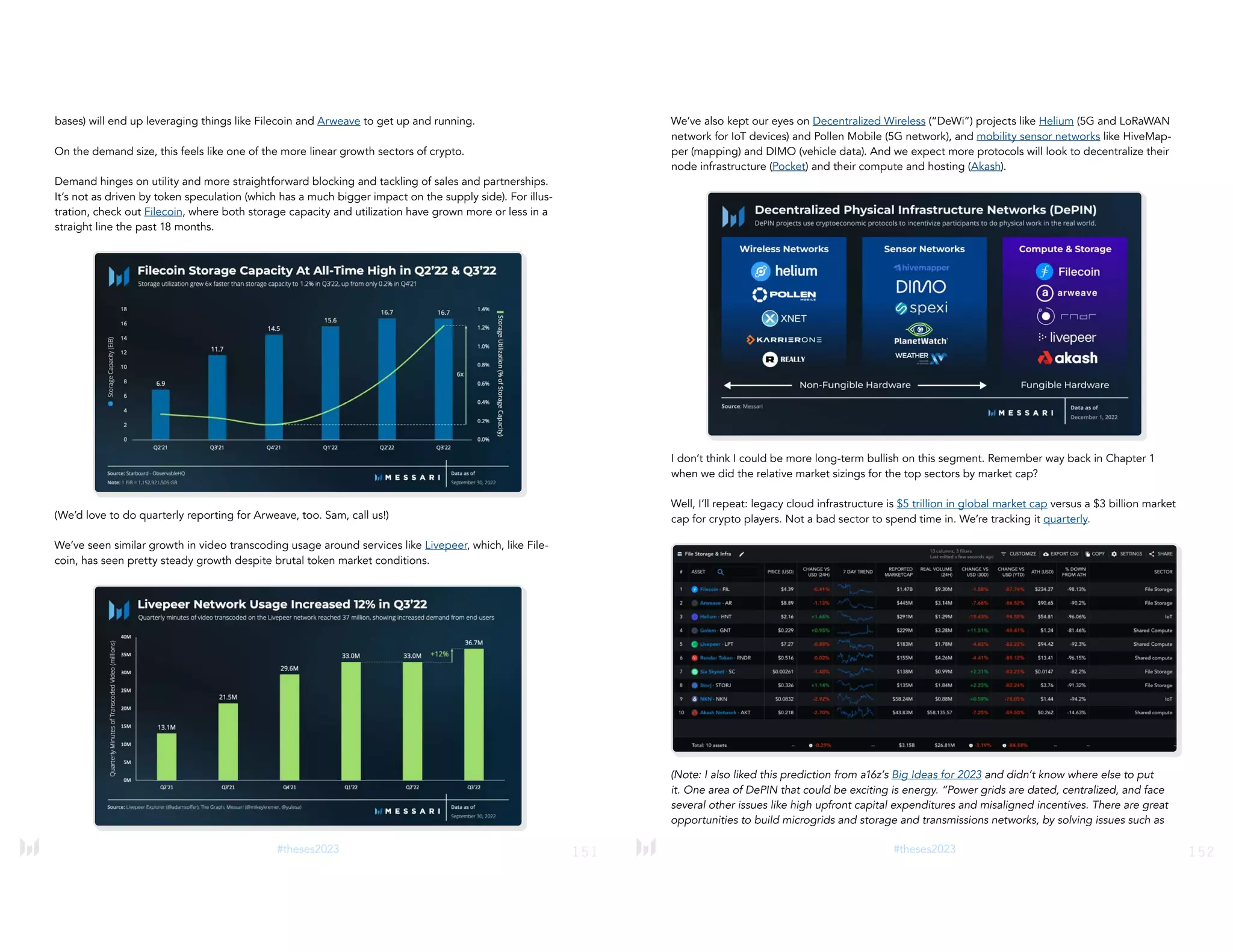
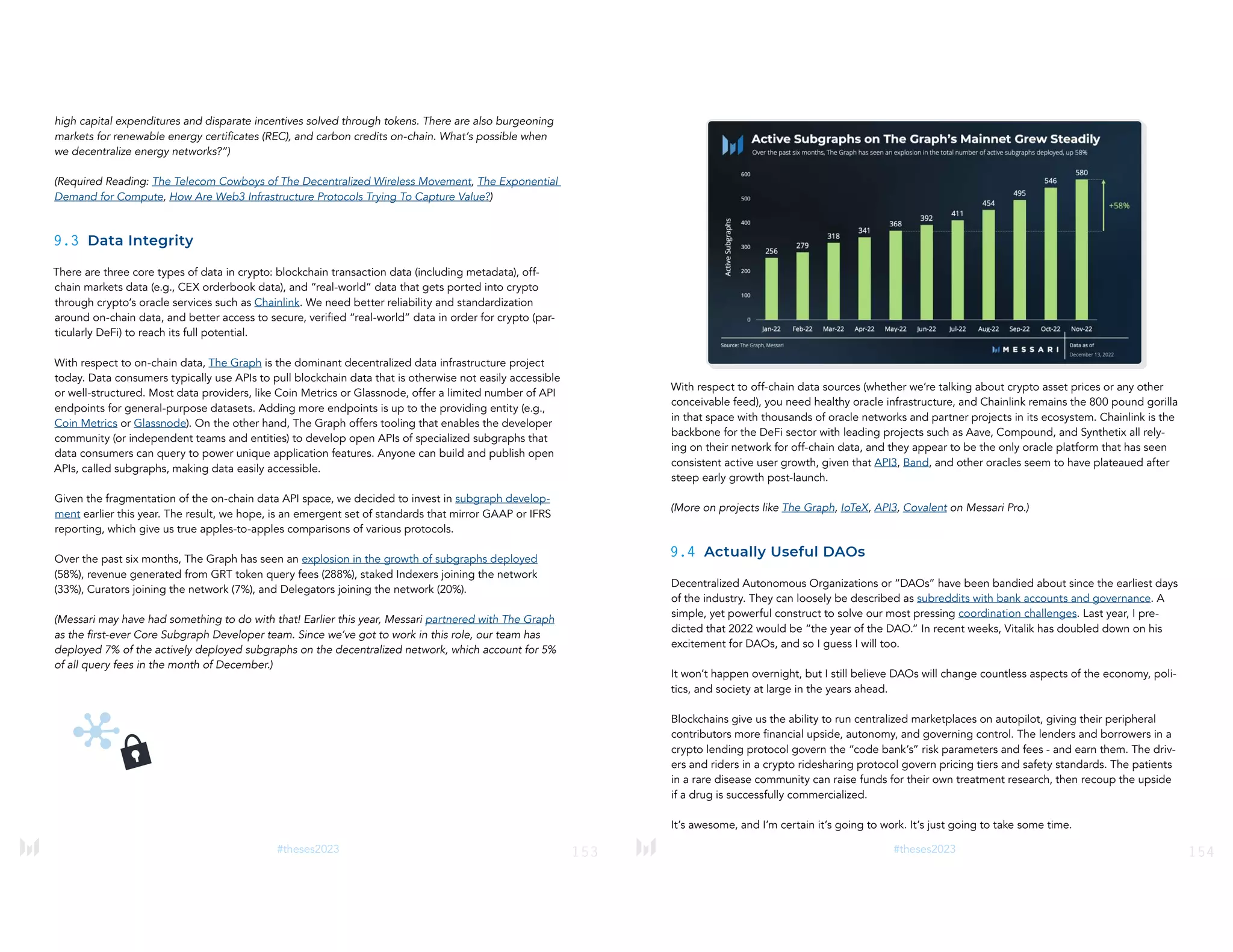
![155
#theses2023
To understand why I’m so bullish, you have to appreciate the unique, order-of-magnitude improve-
ments that DAOs can offer contributors (at least technically):
1. Unprecedented control over how money is invested and directed versus most types of corporate
structures. DAO contributors and workers truly are its owners.
2. The ability to leave a DAO, remove funds from its treasury at any time, and fork-off from the com-
munity (rage quit) without penalty is profound and inherently decentralizing.
3. An order(s) of magnitude improvement in the speed and cost of spinning up and winding down
entities. (Though real-world jurisdictions still cause headache and expense.)
The foundational legal work needed to bring the DAO vision to fruition is significant, as we outlined
last year: “One of the things that is going to be a long-term hassle to figure out is how DAOs actually
work in the real world from a tax, contract law, and compliance standpoint.” a16z has some of the best
proposals for how to create legal DAOs as unincorporated non-profit associations, and Wyoming took
the national lead on this already with its recognition of DAOs as a type of LLC.
It’s not getting any easier, but I think we’ll ultimately like the results:
• New Business Models: In Web2 there’s a health-focused social network called Patients Like Me. It
specializes in helping patients with rare diseases find new treatments and connect with others like
them. In crypto, there’s Vibe Bio, which aims to actually change the incentive structures in biotech.
The protocol makes it easier for patients and families affected by rare diseases to fund (and profit
from) the drug funding and research process.
• Small SPACs: ConstitutionDAO was the equivalent of a flash mob, a toy that showed how easily
single purpose communities could rally around a given cause and fund an investment. In this case,
it was the Constitution of the United States. But could this concept extend the “SPAC” model to
rescue a sports club? Or buy out a small business or crypto venture? What about funding litigation
versus a deep-pocketed enemy? The toy works. More innovations will follow.
• Investment Clubs: Syndicates make it easier to spin up NFT and token investment clubs, which
don’t require accreditation by members for many on-chain assets.
• Impact DAOs: Gitcoin has remained one of the most innovative early DAO projects, having pio-
neered quadratic funding and helped seed core ecosystem infrastructure like ethers.js, Optimism,
and Uniswap with over $70 million in grants since 2017. Their eight rules for creating Impact DAOs
are good commandments for DAO organizers.
• Social DAOs: LinksDAO will let you play golf with Mike Dudas (among other things). They raised
$10 million from 9,000+ members in January in order to DAO a golf course.
• Network States: Balaji wrote his book y’all. “A network state is a highly-aligned online community
with a capacity for collective action that crowdfunds territory around the world [DAO!] and even-
tually gains diplomatic recognition from pre-existing states.” The network states will be led by
leaders who write like storytellers and code like engineers.
These things actually work! Again, not at scale, but they work! How can you not be excited?
156
#theses2023
9.5 DAO Management
Calling DAOs “managed” is a bit generous if you know what I mean.
The political processes are messy, and conversations are chaotic. If you think email and Slack are time
sucks, try Discord. If you think political debates are tedious, wait until you have to try to debate every
minor business decision in public. And ohhh baby, if you think elections are rife with dark money con-
flicts, wait until you hear about metagovernance and bribes!
Suffice it to say, current DAO management structures are not sustainable. But the universe of gover-
nance tools that support them continues to grow fast.
In the spring, we introduced Governor V2, a product that lets you search for DAOs, monitor and vote
on proposals, and quickly discover the top tools other DAOs are leveraging.
We want to help people parse signal from noise in DAOs more quickly. There are essentially two
groups you should be paying close attention to: the delegates with real voting power and how they
are concentrated, and the developers who hold the keys to the code base.
Everything else comes in a distant second.
You can think of most DAOs as boards of directors with unequal (token-weighted) voting power.
Except that most of the board doesn’t usually show up to quarterly meetings, and the tokenholders
don’t respond to proxy solicitations. Participation rates have ticked up slowly over time as delegation
tools have improved, but we’ve also seen a rise in *literal bribes* as a result of low quorums and high
stakes: bribes have proven to be lucrative in moving votes and rewarding certain stakeholders.
This mechanism started to gain prominence last year. Convex was built on top of Curve in order to
allow voters to decide where CRV token emissions should be allocated. Users were able to lock up
liquidity in Curve pools in exchange for governance power, and protocols that wished to direct Curve
liquidity for their pools were often willing to bribe Curve tokenholders for their voting power, creating](https://image.slidesharecdn.com/messari-cryptotheses2023-230101045959-80637cf4/75/MESSARI-Crypto_Theses_2023-pdf-78-2048.jpg)
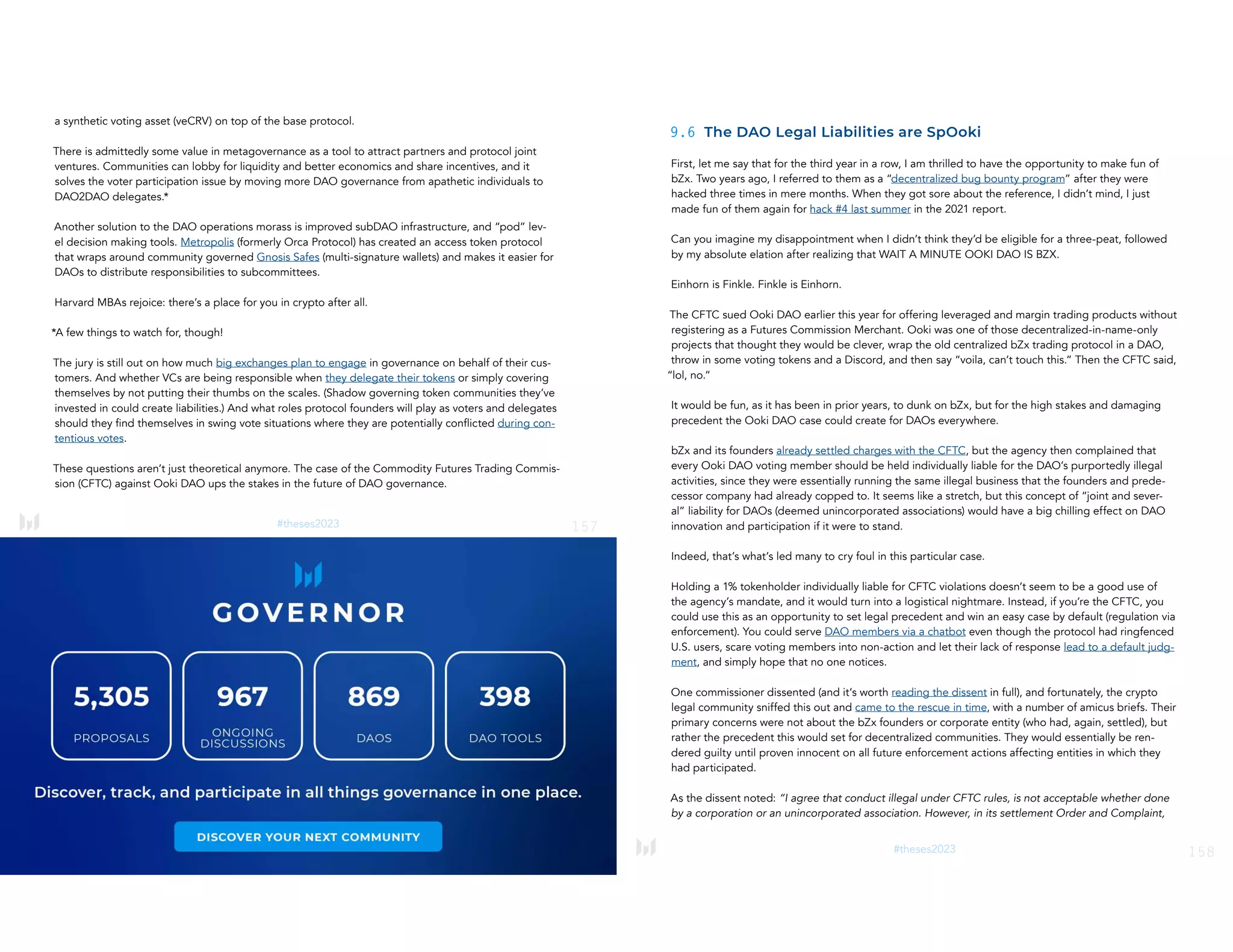
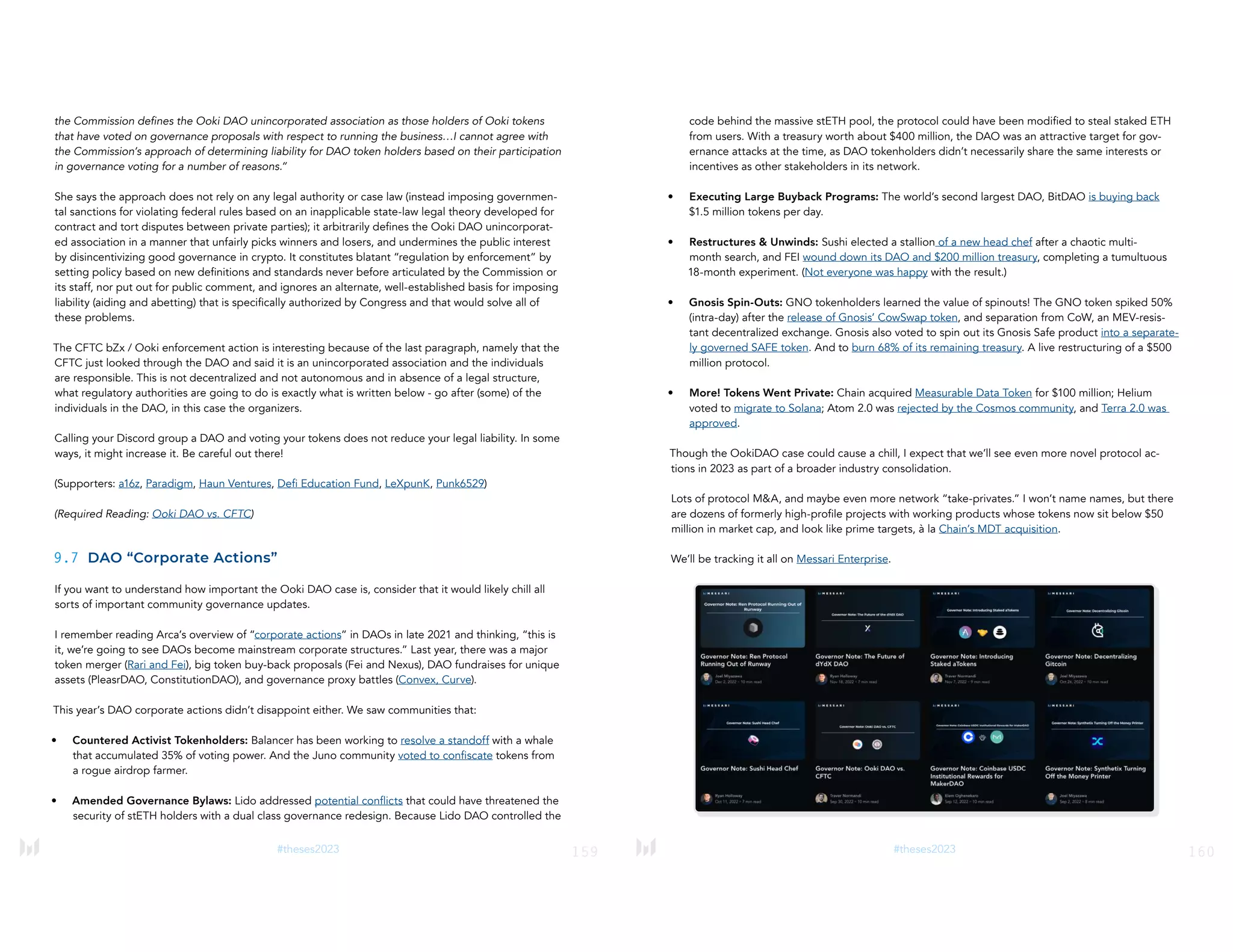
![161
#theses2023
9.8 DAO Treasury Management
Despite the lessons of history, most DAOs still don’t properly diversify their treasuries or spend much
time on coherent community budgeting processes. That is thanks, in equal parts, to legal and organi-
zational ambiguities, a lack of tooling, and a fairly blasé attitude toward professional management.
Last year, I wrote about how shocking it was that most big DeFi protocols hadn’t capitalized on one of
the top wealth generating events in crypto’s short history after DeFi Summer in 2020.
“You might think DeFi protocols are financially set for life, but a deeper look into the com-
position of each treasury suggests the opposite. The vast majority of the “value” in these
token treasuries is coming from the reflexive belief that the market will always absorb the
new supply. That may happen in bull markets, but things can unwind sharply when vol-
umes subside. In fact, that’s exactly what happened during May’s market crash.”
Surely, other protocols had learned their lessons, and big exchanges wouldn’t lever up on their trading
tokens with customer funds.
Right, Anakin? Right?
According to DeepDAO, DAO treasuries now hold just $8.7 billion, with a mere 60 DAOs holding $10
million or more in assets. Worse, native tokens still represent 80% of these treasury assets, making
the projects highly susceptible to market downdrafts and highly illiquid when it comes to operating
budgets.
It appears that the immediate future of crypto protocols will continue to flow through foundations and
VC-backed corporate entities as the catastrophic downdraft in crypto prices this year has essentially
relegated many high flying 2021 protocols from unicorn to Series A status.
There are some good reasons to hold large percentages of native tokens: governance sway, signals
of health and alignment with other tokenholders, reserves for DAO2DAO M&A and partnerships, etc.
162
#theses2023
But it is clear that many communities did not take proper advantage to diversify their portfolios at the
height of bull market mania last year, and now many may struggle to take advantage of opportunities
in this new market.
(Vitalik is an exception. He’s a god tier trader. 2017. 2021. All hail.)
We really need more adversarial thinkers in the DAO space. There are a lot of bull market newbies
out there who are about to be unpleasantly surprised when they’re thrown into a multi-year deep end
without a life jacket. Expect major upgrades to community “banking” and financial management ser-
vices such as Coinshift, Multis, and Parcel begin to proliferate.
The best time to diversify treasury was 12 months ago, when I wrote “the first recommendation most
treasury managers would make today: start selling. A Q1 blow off top doesn’t do a DAO any good if
the asset nukes 90% mere months later.” Communities that didn’t heed those bear market warnings
will now have to cut community spend, devolve into volunteer-led zombies…or consolidate?
(Required Reading: The Health of DAO Treasuries, What Protocols are DAO Treasuries Using?)
9.9 Crypto Talent Marketplaces
There’s a lot of interesting stuff to talk about when it comes to the DAO labor force, but I’m running
out of gas here, fam. Sort of like the DAO Treasuries above.
I don’t want to pick on DAOs, though it is easier to do because communities need to learn the number
one rule of running startups is You. Don’t. F*ck. Up. The Money.
I agree with Alex here:
“I think 2023 will be a bloodbath for crypto startups:
1. Most ‘21/22 seed startups run out of money.
2. Some get acquired [We’re on the prowl].
3. A few raise new rounds (>80% downrounds).
4. Tech salaries come down.
5. Tech job titles deflate [No Chief Fun and Chaos Officers].
6. VCs invest in other sectors (AI, etc.).”
Perfect. No notes. Except to say that it will be even worse in decentralized communities.
That said, I continue to be enthralled by crypto powered talent marketplace of all kinds. We just incu-
bated one here at Messari called Hirechain, which is a referral-based recruiting network. The “friends-
refer-friends” model is 1000x better than the 73 unsolicited recruiting inbound emails per day model.
Do NOT tell me, you’re going to read 145 pages and then bail on me now. Open your wallet or I’m
going to come find you. Get in loser, we’re going shopping.
(Read more about crypto talent marketplaces like Braintrust on Messari Pro.)](https://image.slidesharecdn.com/messari-cryptotheses2023-230101045959-80637cf4/75/MESSARI-Crypto_Theses_2023-pdf-81-2048.jpg)


